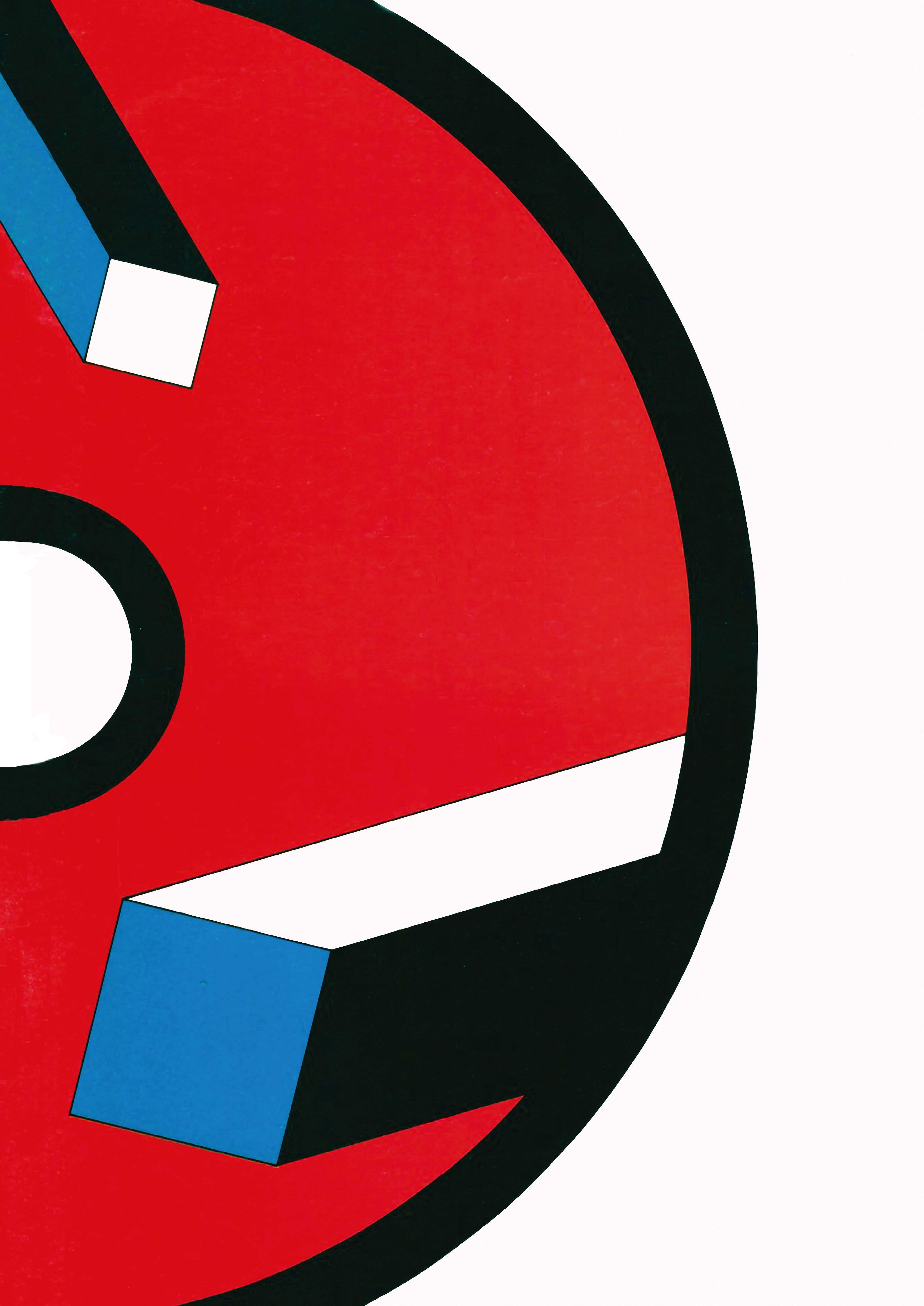

Post-War Design:
A collection of books and ephemeral material 1960s to present day
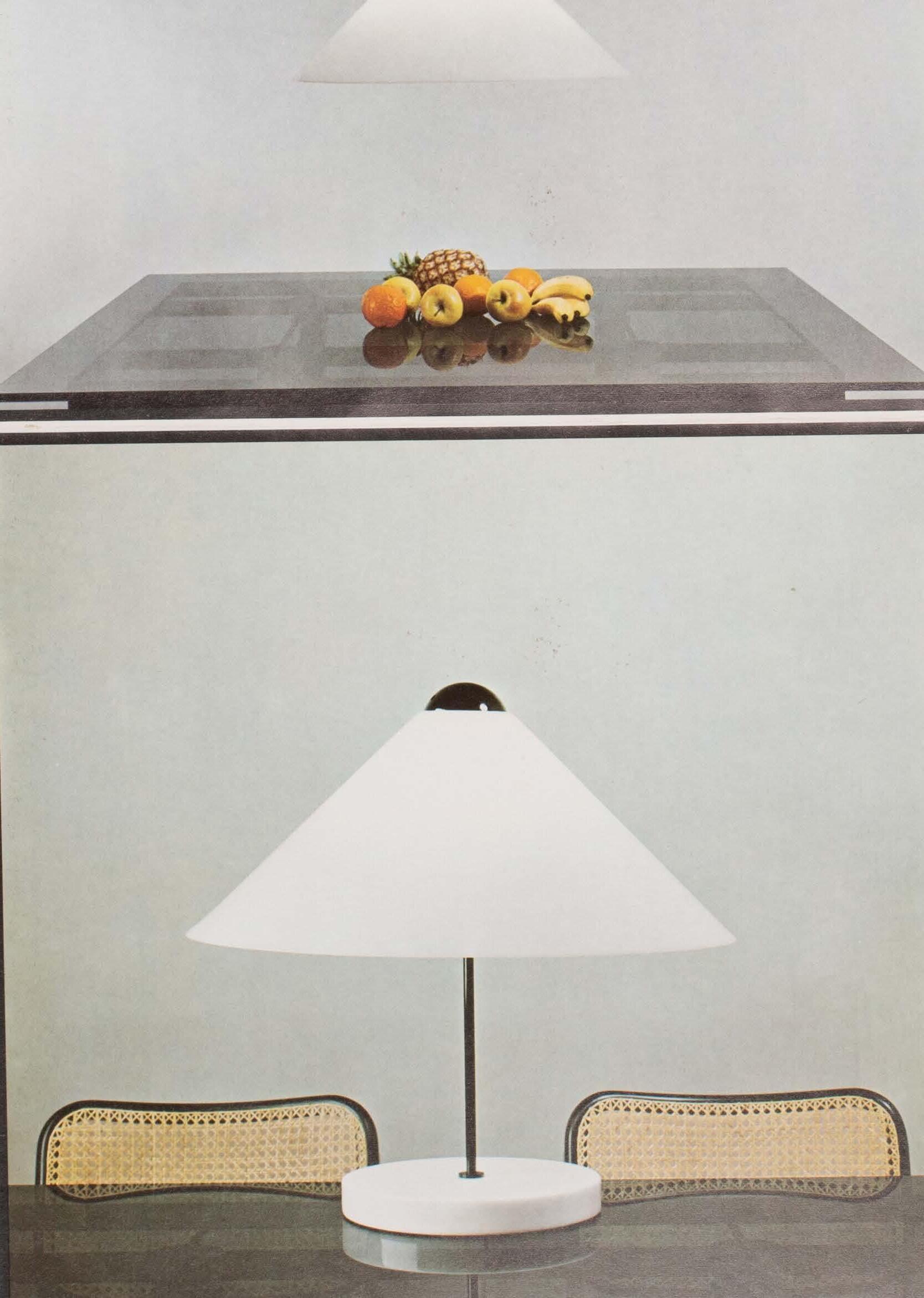
Post-War Design:
A collection of books and ephemeral material
October 2025 1960s to present day
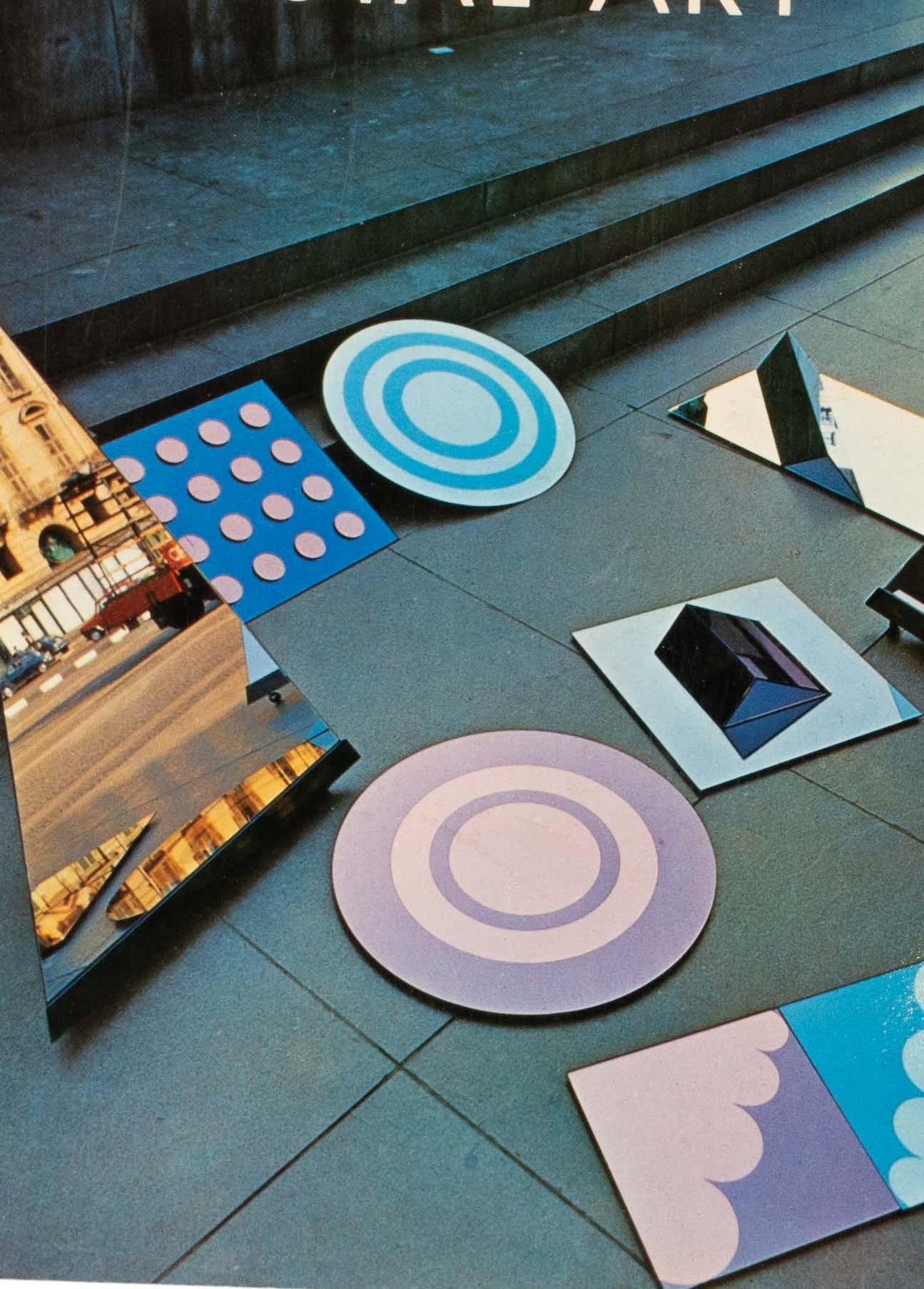
Sims Reed Rare Books
44 St James’s Place
London SW1A 1NS
email: info@simsreed.com
tel. +44 (0 ) 20 7930 5566
Image, left: no.56
Previous page: no.82
The twentieth century witnessed a profound shift in attitudes towards household goods, driven in part by a handful of innovative design companies whose work fundamentally redefined the relationship between product form, function and cultural expression. This extensive collection of design material – much of it ephemeral – highlights the contributions of seminal design companies – including Braun, Olivetti, Danese and Alessi - whose promotional offerings were often discarded but now serve as invaluable documents of design innovation. Whether product brochures, advertising campaigns, press kits, exhibition invitations, pattern books or price lists, together these provide a direct glimpse into the visual language and ideological underpinnings that guided some of the most influential design practices and practitioners in the latter half of the twentieth century.
Postmodern figures such as Alessandro Mendini (Studio Alchimia) and Ettore Sottsass are well represented in the collection (see Part One: Italy). As one of the most influential figures in post-war design, Sottsass was pivotal not only to Olivetti but also to the founding of Memphis Group, a collective that radically challenged modernist design conventions by creating playful and sculptural furniture that rejected minimalism in favour of a more eclectic aesthetic. His work with Olivetti, including the iconic Valentine typewriter (page 17) demonstrated his belief in merging technology with artistry, pushing the boundaries of what office equipment could be in terms of both function and visual appeal. The promotional materials – from typewriter brochures to colourful advertisements – embody the vibrant optimism of mid-century Italian design. By contrast, at Braun (see Part Two: Germany), Dieter Rams’ minimalist design philosophy of ‘less, but better’ permeated not only the company’s iconic products but also its printed ephemera. Braun’s product manuals, catalogues and advertisements emphasise clarity and ease of use, mirroring the functional elegance of its consumer electronics and serving to make even the most mundane instructional pamphlet a part of the user experience.
Among the rarer items offered are some extraordinary examples of postmodern design ephemera, from Cassina and Archizoom’s co-published newspaper ‘Operation Sit-In’ which takes the form of a comic strip (c.1975, cat. no. 45), the spiral-bound promotional book showcasing Shiro Kuramata’s ‘Progetti Compiuti’ for Cappellini (1986, cat. no. 42), the Memphis exhibition catalogue cum pattern sample book with striking designs by Nathalie du Pasquier and George James Sowden (1983, cat. no. 71) to the ‘BD: Ediciones de Diseño’ folder (c.1986, cat. no. 164) or the Ecart trade booklet recreating lost early twentieth century designs by Eileen Gray, Robert Mallet-Stevens, Mariano Fortuny, et al. (1970s, cat.no. 167). As a collection, the books and ephemera offered here form a rich archive of twentieth century design and reveal deep connections between industrial innovation and the evolving cultural landscape.
Part 1: Italy Studio Alchimia Alessi
Alessandro Mendini
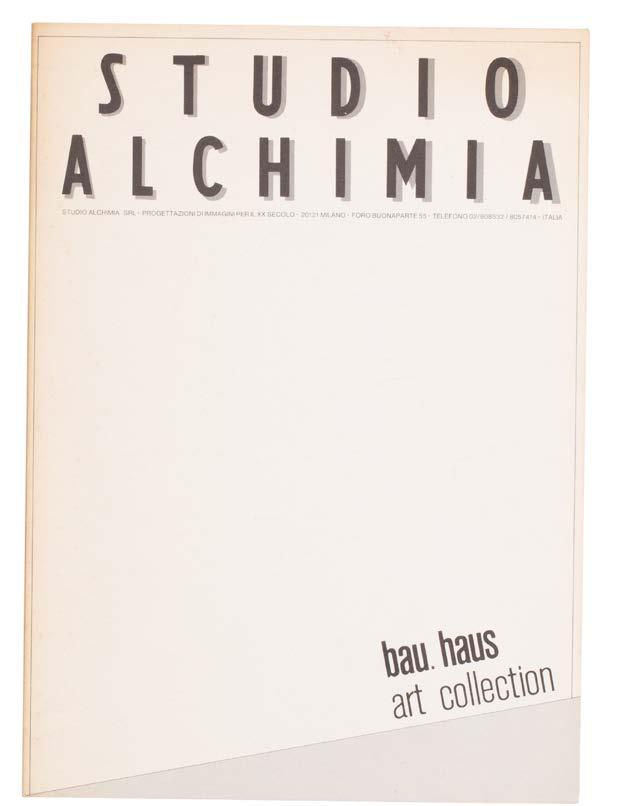
ALCHIMIA: (1). Studio Alchimia bau haus art collection. 1980–81. Milan. Studio Alchimia. 1981. 4to. Illustrated in colour and black & white. Wrappers. pp. 36. • Early Studio Alchimia catalogue designed by Bruno Gregori. Many important early works from the studio are featured. Includes works by Michele De Lucchi, Ettore Sottsass, Paola Navone, Alessandro Mendini, Andrea Branzi, UFO, Trix and Robert Haussmann and Daniela Puppi.
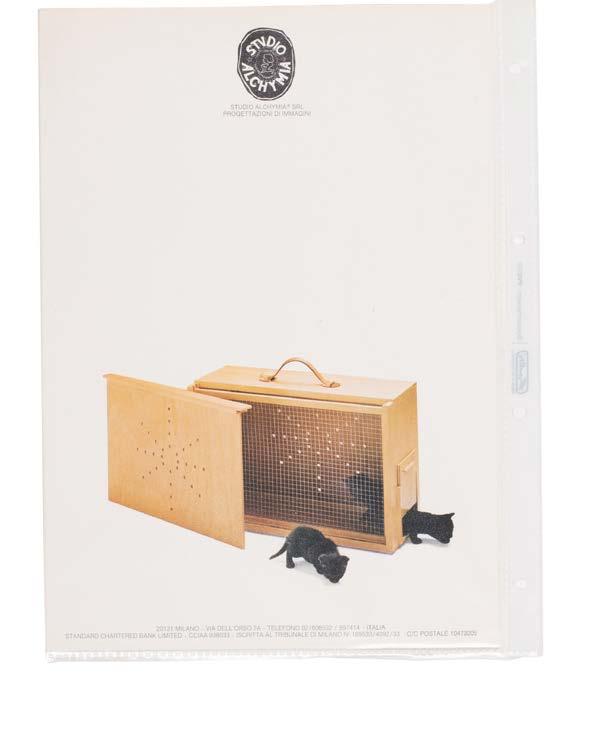
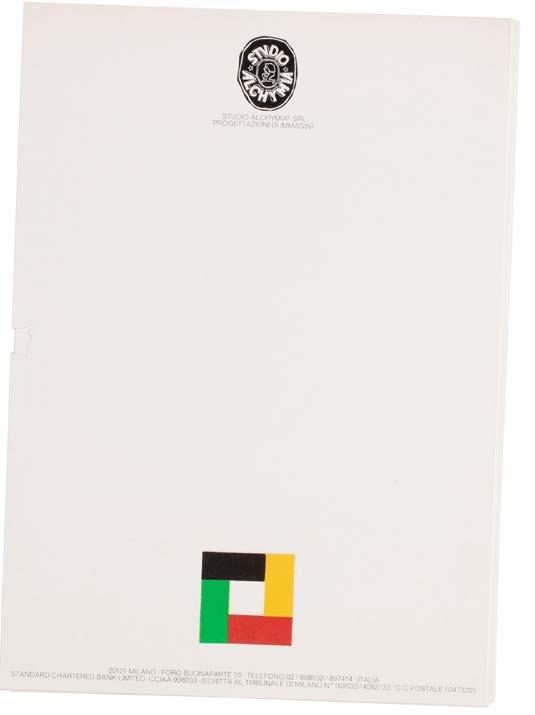
(6). Studio Alchymia. Progettazioni di Immagini. (18 loose sheets). Milan. Alchimia. (c.1978). 4to. Illustrated in colour. • Important pieces of Studio Alchimia ephemera, documenting the studio’s mission as a ‘project for the look of the twentieth century’. The studio’s name — ‘chosen as an ironic contrast to Modernism’s supposedly rational self-understanding’ (Vitra Design Museum) — was sometimes spelt with a ‘y’.

(11). Scarzella, Patricia, Paolo Portoghesi, (Intro). Il Bel Metallo. Storia dei Casalinghi Nobili Alessi. Milan. Arcadia Edizioni. 1985. 4to. Illustrated in black & white. Original publisher’s grey cloth-covered boards with label pasted to centre. pp.178. • Monograph from the ‘Progetto al Prodotto’ series.
This top section displays the main companies referenced on the page, along with:
Company founder(s) • Year
Some of the company’s key members and collaborators
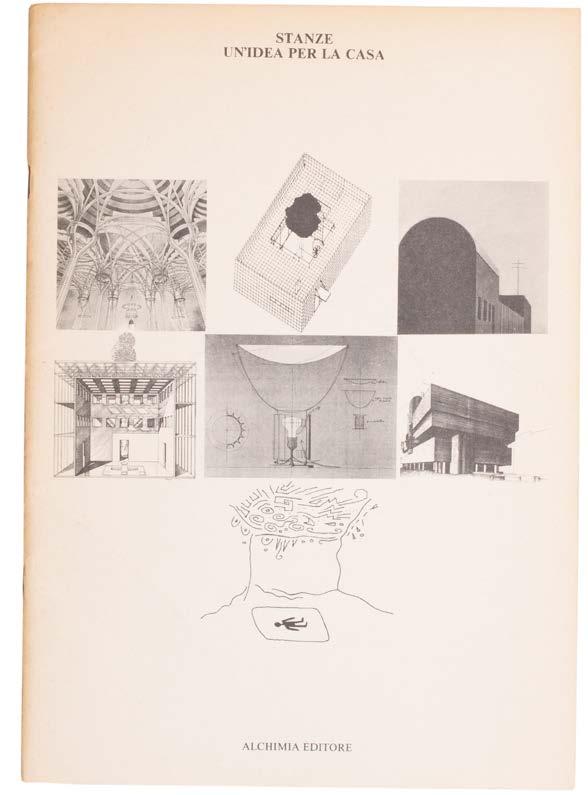
(2). (Alessandro Mendini, Fulvio Irace, et al.) Stanze: un’idea per la casa. Milan. Alchimia Editore. 1981. 4to. Illustrated in black & white. Stapled wrappers. pp. 24. • Exhibition catalogue / artist book for a conceptual design project at the Italian Cultural Institution, Warsaw. ‘Sono stati invitati a progettare le stanze della casa Arduino Cantafora, Achille Castiglioni, Costantino Dardi, Alessandro Mendini, Adolfo Natalini, Paolo Portoghesi, Franco Purini.’
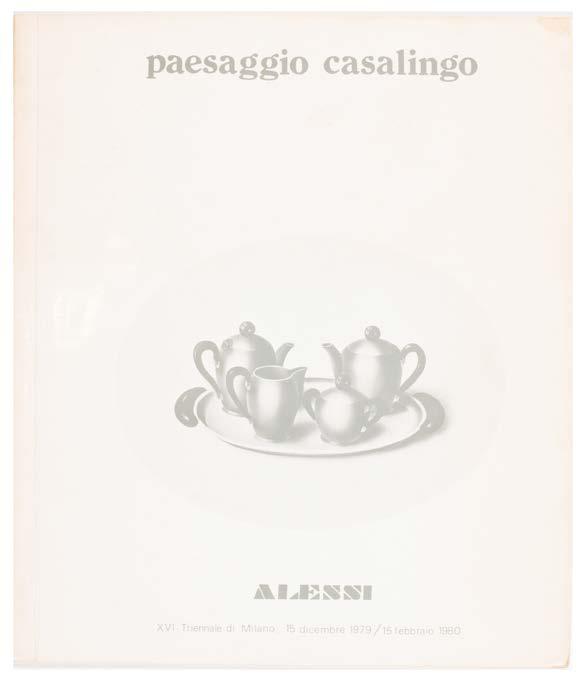
ALESSI (7). (Hollein, Hans. Scarzella, Patricia, et al.) Paesaggio Casalingo. La produzione Alessi nell’industria dei casalinghi dal 1921 al 1980. 1980 4to. Illustrated in black & white. Wrappers. pp.22. • Published on the occasion of the exhibition ‘Paesaggio Casalingo’ at the 16th Triennale di Milano at the Palazzo dell’Arte. The exhibition design was by the Viennese architect Hans Hollein. Text in English and Italian.
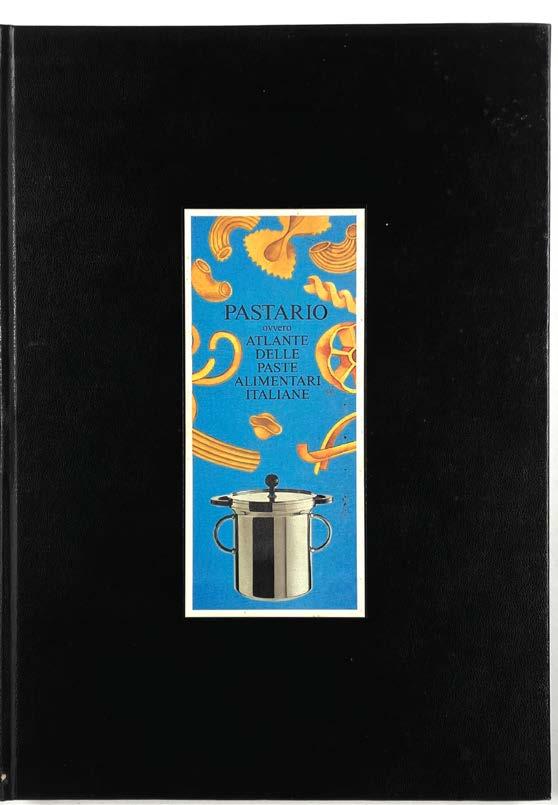
(12). (Simonetti, Gianni Emilio, et al.)
Pastario ovvero Atlante delle Paste Alimentari Italiane. Crusinallo. Alessi. 1985. 4to. Illustrated in colour. pp.86. • From the edition limited to 999 numbered copies. A well produced and richly illustrated catalogue documenting pasta shapes: ‘Primo tentativo di catalogazione della paste alimentari italiane, condotto sotto il patrocinio della Staatliche Hochschule für Bildende Künste, Frankfurt am Main.’
Alessandro Guerriero, Adriana
Guerriero, Bruno Gregori • 1976
Andrea Branzi
Arduino Cantafora
Achille Castiglioni
Costantino Dardi
Michele De Lucchi

(3). Architetture Estive. Sei Progetti di Architettura Contemporanea a cura di Franco Raggi. Milan. Alchimia. 1981 4to. Illustrated in colour and black & white. Stapled wrappers. pp.24. • Published on the occasion of the exhibition ‘Architetture Estive’, at the Assessorato alla Cultura del Comune di Rimini. With work by Andrea Branzi, Arduino Cantafora, Michele De Lucchi, Alessando Mendini / Studio Alchimia, Franco Raggi and Ettore Sottsass.

(8). (Mendini, Alessandro). Paesaggio Casalingo. Die Produktion Alessi in der Haushaltswarenindustrie von 1921 bis 1980. (Berlin). IDZ (Internationales Design Zentrum Berlin). 1981. 4to. Illustrated mostly in black & white. Wrappers. pp.170. • The book first appeared in Italian (see also cat. no. 7) and was reprinted on the occasion of the Alessi exhibition of household products held in February at the Internationales Design Zentrum, Berlin.
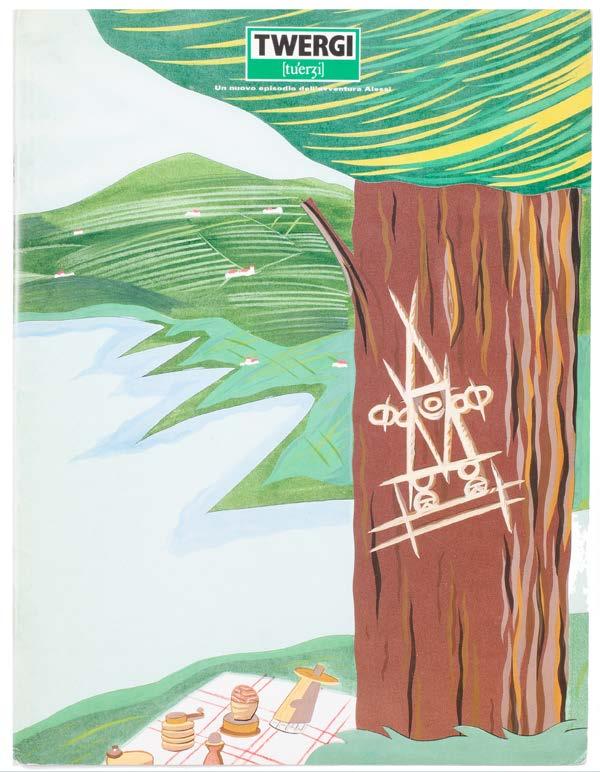
(13). (Alessi / Sottsass Associati). Twergi. Catalogo N.1 / 1989. Crusinallo. Alessi. 1989. 4to. Stapled wrappers. • ‘Un nuovo episodio dell’avventura Alessi.’ With two postcards inserted loose (one with Milton Glaser’s ‘Twergi’ sketch). ‘Twergi’ were humourous objects made from wood for the kitchen table. Also included is a photocopied sheet comprising text from Alberto Alessi, titled ‘Design in Italy today: News from Somewhere.’
Adolfo Natalini
Paola Navone
Paolo Portoghesi
Franco Purini
Ettore Sottsass

(4). (Mendini, Alessandro). Nuovo Alchima. (Press release folder). Milan. Alchimia. (1980s). 4to. Various forms and sizes. Loose in publisher’s press folder. Stapled. • A4 ‘Nuova Alchimia’ headed sheets (‘Furniture collection 1984–85, Technical catalogue’; Pressebericht (with duplicate); and ‘Es Ist Etwas Vom Zebra im Zabro’). With leporello card flyer for ‘La Légion Étrangère / Alessando Mendini (TRIBU)’ and card invitation to ‘Mobili Nuova

(9). Cibi e Riti - Essen und Ritual. Crusinallo. Alessi. 1982. 4to. Illustrated in black and white. Wrappers. pp.94. • Published in relation to the design seminar ‘Cibi e Riti’ held in Berlin, January 1981.
(10). (Mendini, Alessandro, Intro.) Fulvio Irace and Patricia Scarzella. Officina Alessi. Tea & Coffee Piazza. Shakespeare & Company. 1983. 4to. Illustrated mostly in black & white.
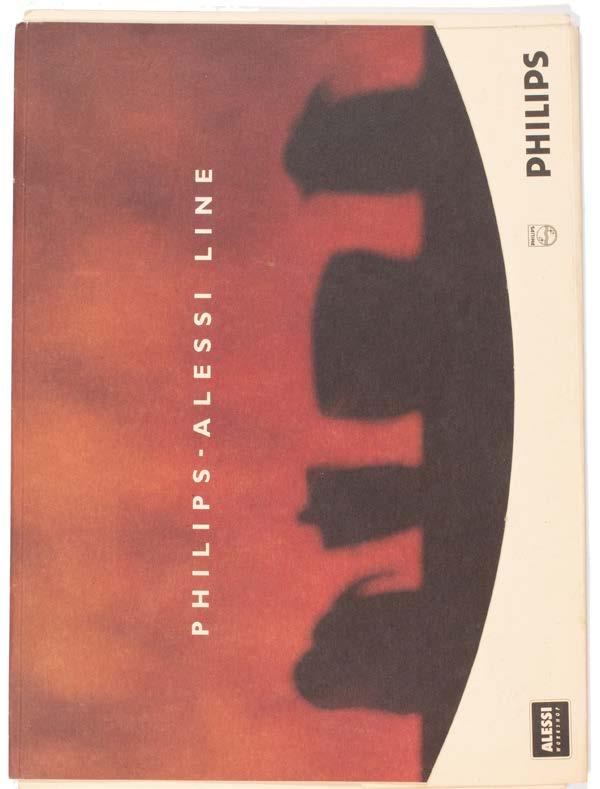
(14). (Philips - Alessi - Line). Press folder. Crusinallo. Alessi. 1994. 4to. With 3 colour slides. Loose in folder.
Giovanni Alessi • 1921
Joe Colombo
Achille Castiglioni
Alessandro Mendini
Ettore Sottsass
Philippe Starck
Michael Graves
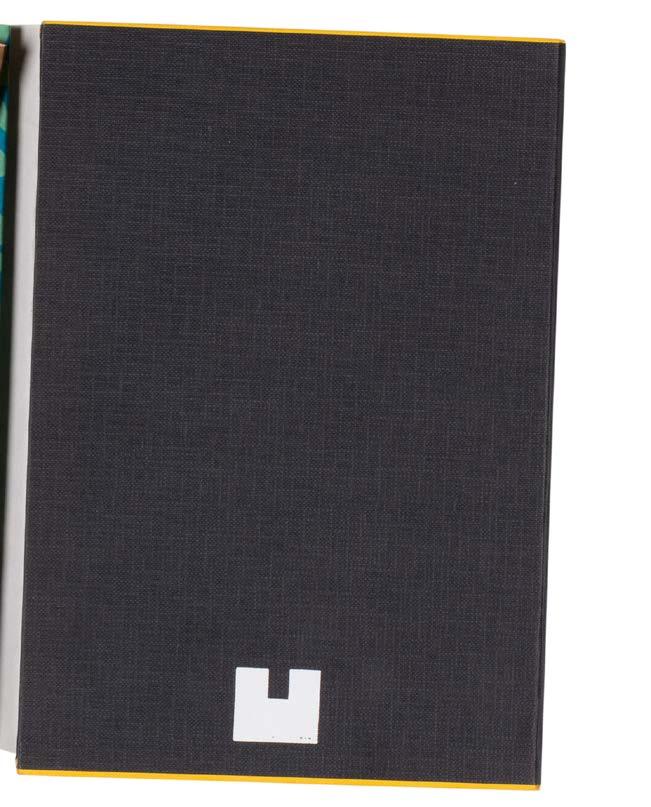
Alchimia’. Additional postcard (stamped and mailed) to an Artemide opening related to Mendini (Sidecar), 1992. (5). (Mendini, Alessandro). (Blank Notebooks). Milan. Alchimia. Undated. 4 vols. 4to. Original publisher’s patterned wrappers. • Four unused Alchimia notebooks housed within the original black Alchimia slipcase and a plastic Alchimia shopping bag.
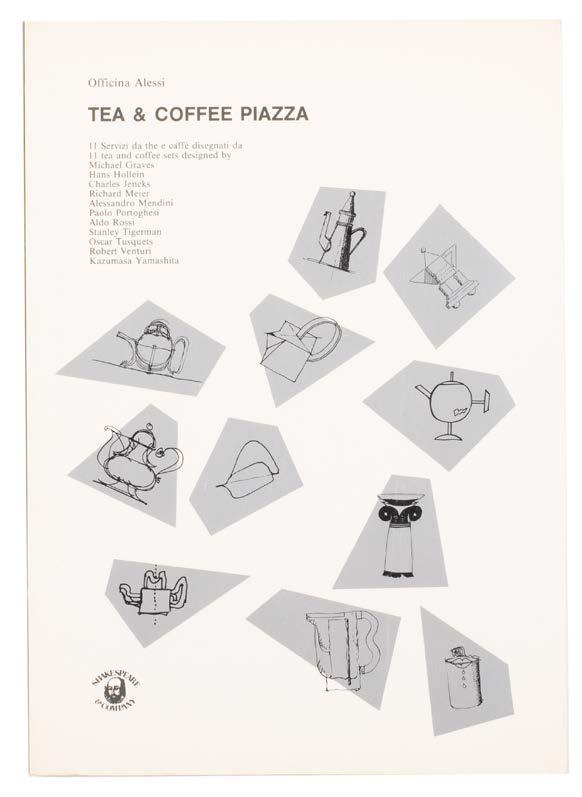
Glossy wrappers. pp.90. • Catalogue for the exhibition of the same title, which was on display at the former church of S. Carpoforo in via Formentini, Brera. ‘Tea and Coffee Piazza’ explains how each set – teapot, coffeepot, milk jug, sugar bowl, tray – is devised in terms of town-planning: the tray is a micromap of an inhabited city, an urbus-domus, each item seen as a microbuilding or micromonument.’ With a presentation from Fulvio Irace.
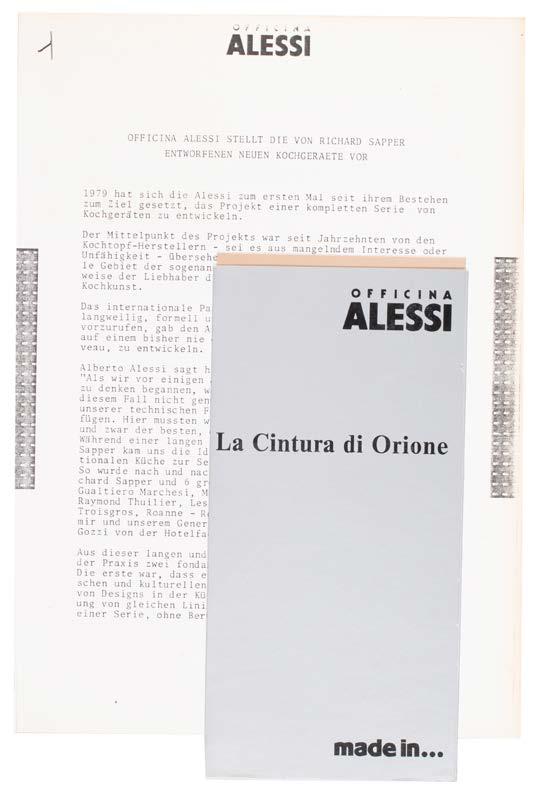
• ‘Philips von Alessi: Dream team für eine humanere Kuche.’ The PhilipsAlessi product line was the result of a collaboration between the Italian designer Alesandro Mendini, creative director at Philips, Stefano Marzano, and Alberto Alessi. (15). (Sapper, Richard). Officina Alessi. La Cintura di Orione. (Exhibition
Folded sheet. Illustrated in colour and black & white.
• With press announcement. ‘The project “La Cintura di Orione”, designed by Richard Sapper, dedicated to the private gourmet public, namely those enthusiasts of intelligent and creative cooking who are often led to use some borderline professional utensils because of their culinary passion.’ (Alessi.com).
flyer). Düsseldorf. (1980s).


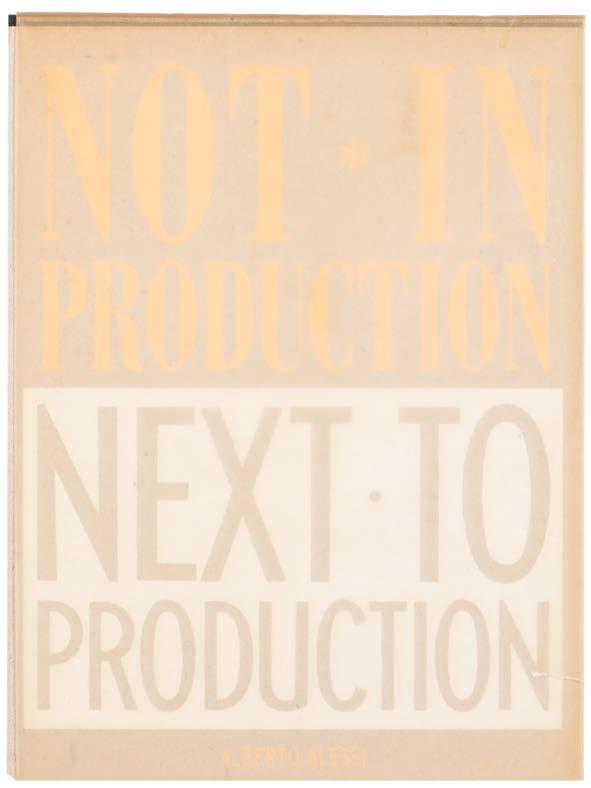
(Alessi, Alberto). Not In Production. Next to Production. Crusinallo. Alessi. 1988. 4to. Illustrated in colour and black & white on variously coloured paper sheets. Boards with glassine jacket. • This book is a catalogue of the exhibition held at the Officina Alessi showroom, (Milan, 1988). From the title page: ‘Prototypes and drawings of 57 designs never entered in the Alessi production catalogues (1921–87), plus some hints regarding the future’.
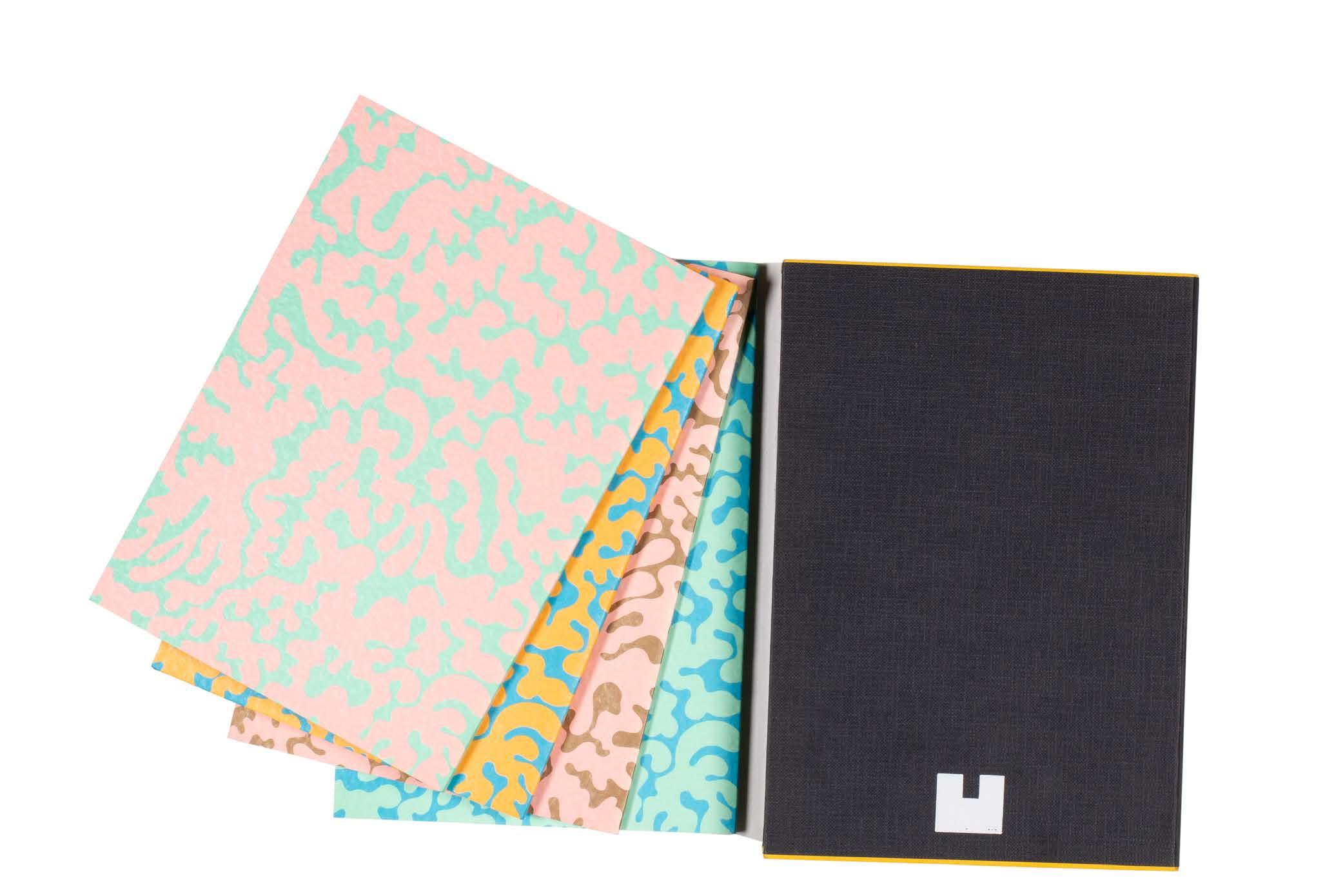
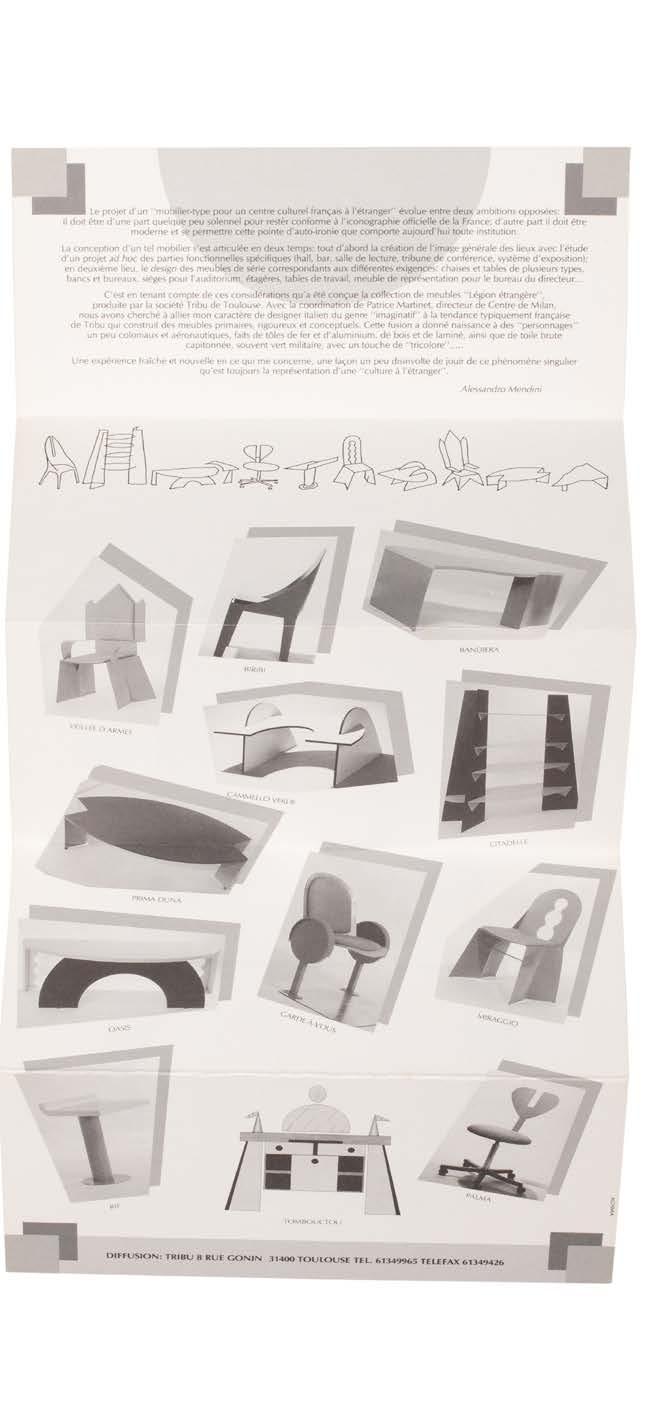

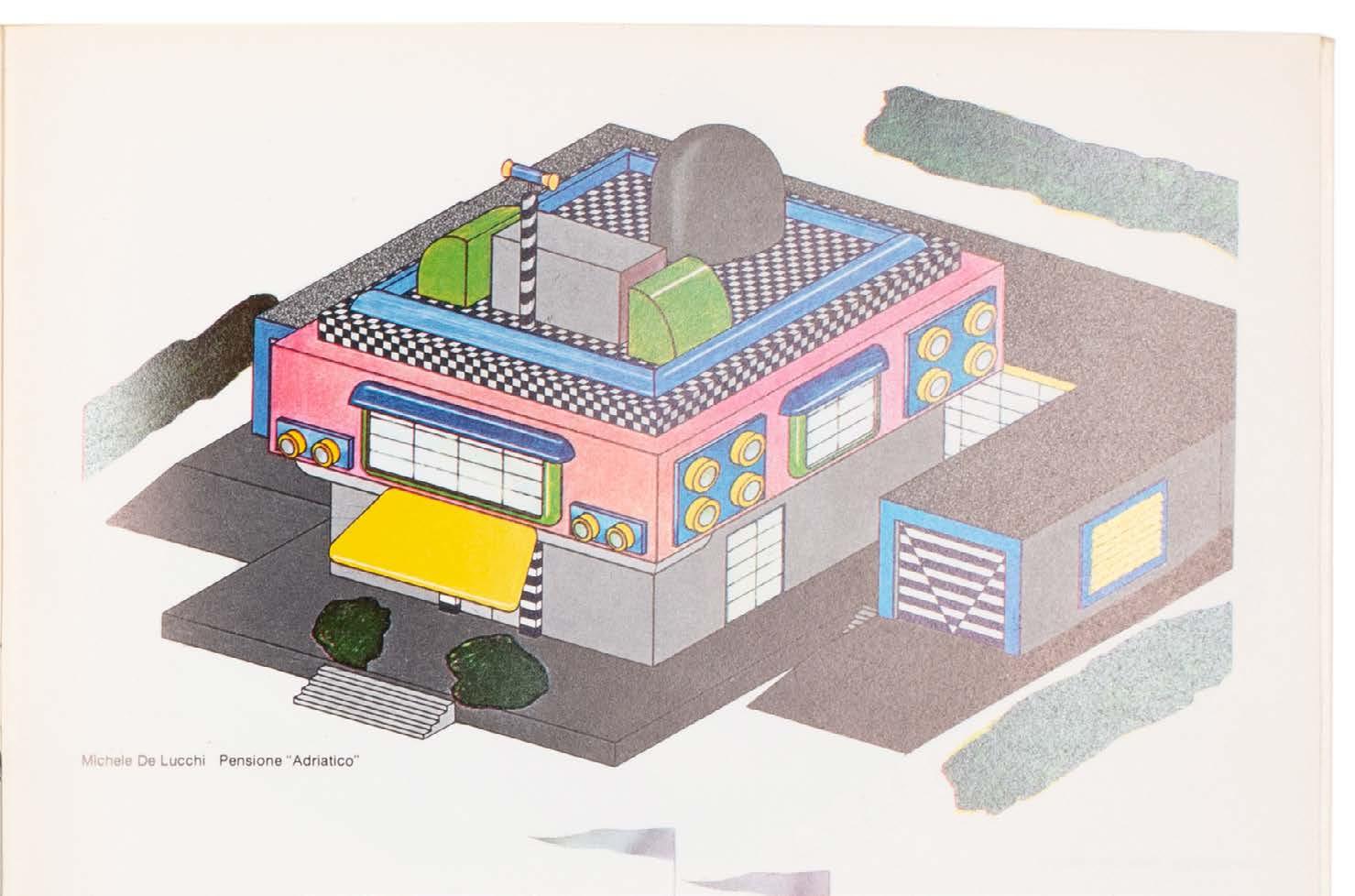

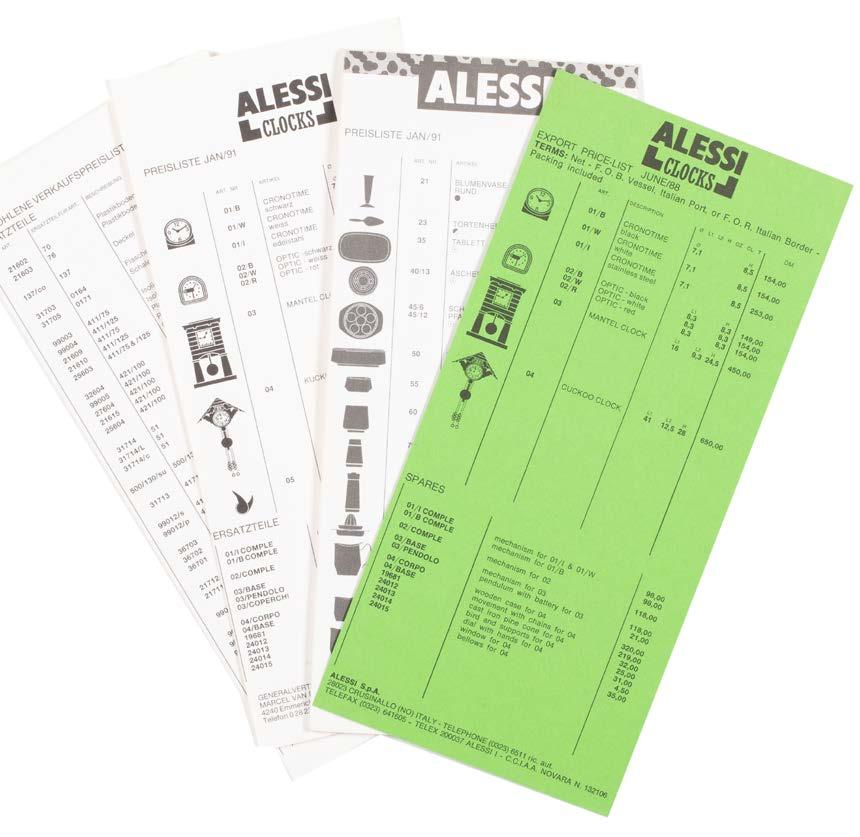
/ 1991

Alessandro and Alberto Alessi.
Laura). L’officina Alessi
L’atelier Alessi. Alberto Alessi e Alessandro Mendini: dieci anni di progetto, 1980–1990.
Alessi. 1989. 4to. Illustrated in colour and black & white. Wrappers. pp.282. • Texts by A.Alessi, A. Branzi, F. Burkhardt, A. Castiglioni, R. Dalisi, M. Graves, G. Guerini, A. Mendini, M. Morozzi, B. Pasini, A. Rossi, R. Sapper, E. Sottsass. Text in Italian and French.
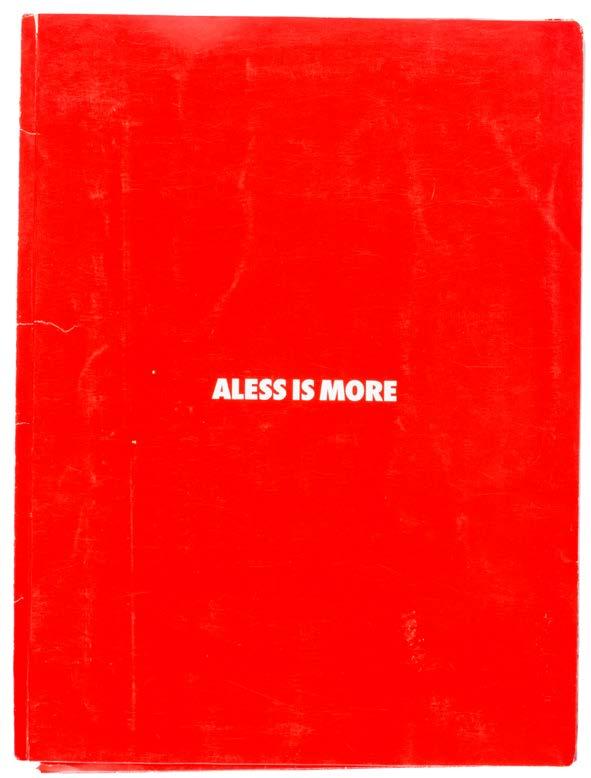
an
(16).
(17). (Colombo, Joe, Pio Manzù, Michael Graves). Alessi Clocks. 1966–1988. Crusinallo. Alessi. c.1988. 4to. Illustrated in colour. Stapled wrappers. pp.16. Text in English, French and Italian. • A brochure from Alessi featuring four designer clocks.
1988
. Leporello. Illustrated in black & white. • Items include clocks and kitchen equipment.
(Mendini,
Polinoro,
/
Crusinallo.
(20). Aless is More. (Press folder). Crusinallo. Alessi. Undated. Various formats and sizes. Loose in Alessi folder. • Various promotional Alessi items, including photocopied pages with annotations, product sheets and
‘Alessi Tea & Coffee Tables’ booklet.

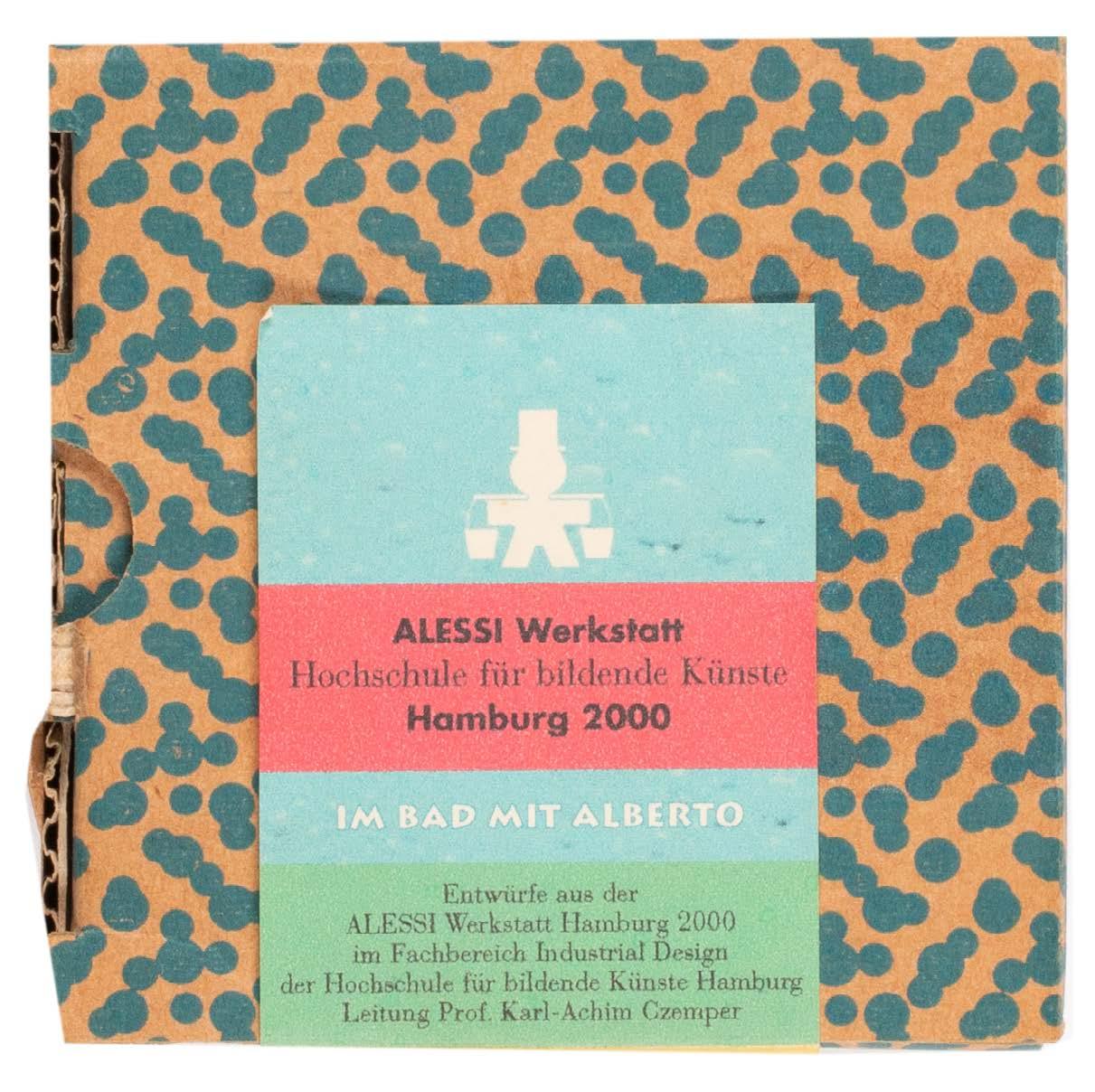
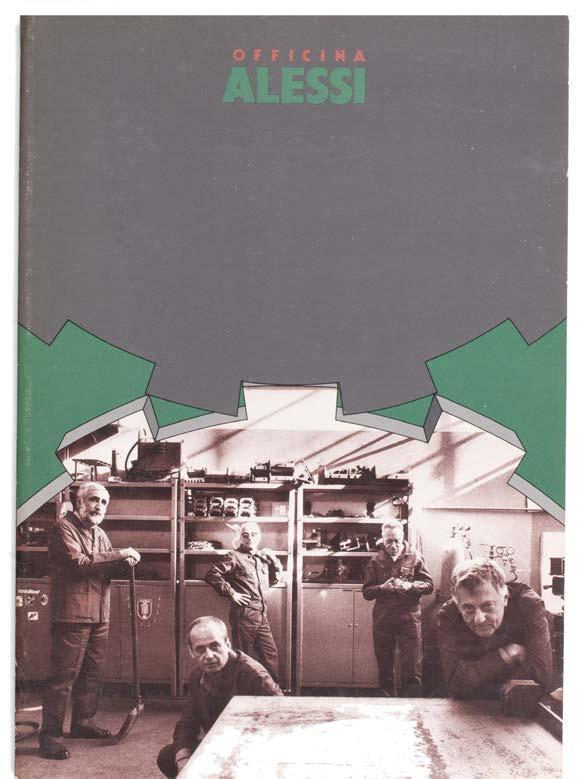
(21). Alessi tea and coffee sets. (6 original photographs). Undated. • Six monochrome photographs (each 128 × 178 mm) of Alessi tea and coffee sets by designers Aldo Rossi, Michael Graves, Richard Meier, Paolo Portoghesi and others. Each numbered and stamped to verso: ‘Aldo Ballo, fotografo, via Tristano Calco 2, 20123 Milano’. With Officina Alessi typed document (3 pages). Image: top of page.
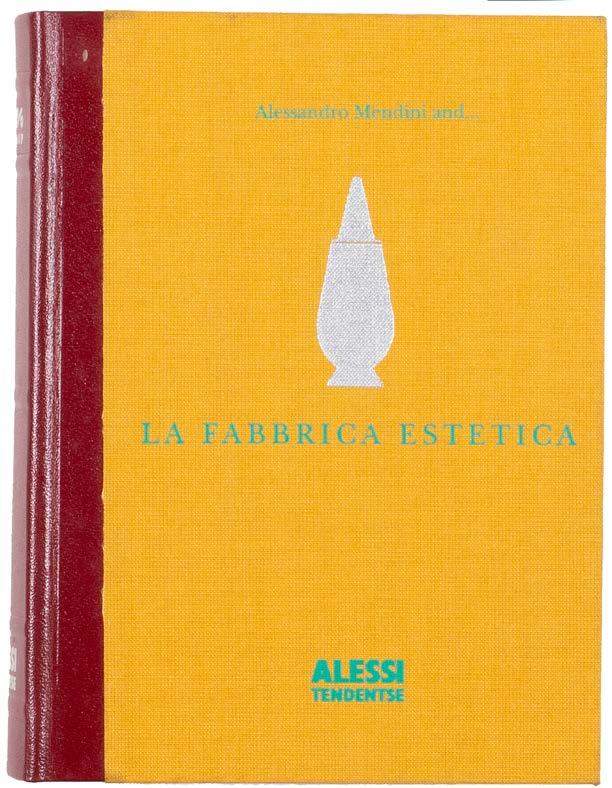
(22). Officina Alessi. Crusinallo. Alessi. 1990. 4to. Illustrated in colour. Wrappers. pp.92. • Text in English, German, French and Italian.
(23). Mendini, Alessandro. La Fabbrica Estetica. 100% Make-Up. Crusinallo. Alessi. 1992. 8vo. Illustrated in colour. Leather-backed cloth boards with silver foiling and printed titles, black slipcase. pp.456. • Text in English and Italian.
Pio Manzὺ
Richard Meier
Paolo Portoghesi
Richard Sapper
Marco Zanuso


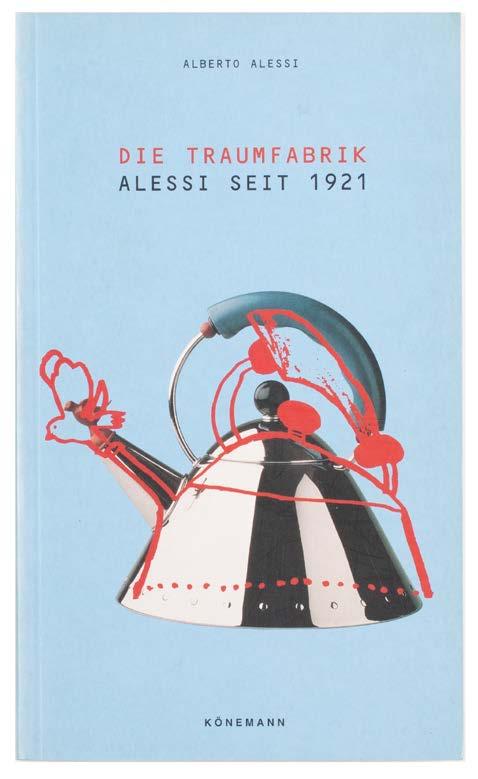
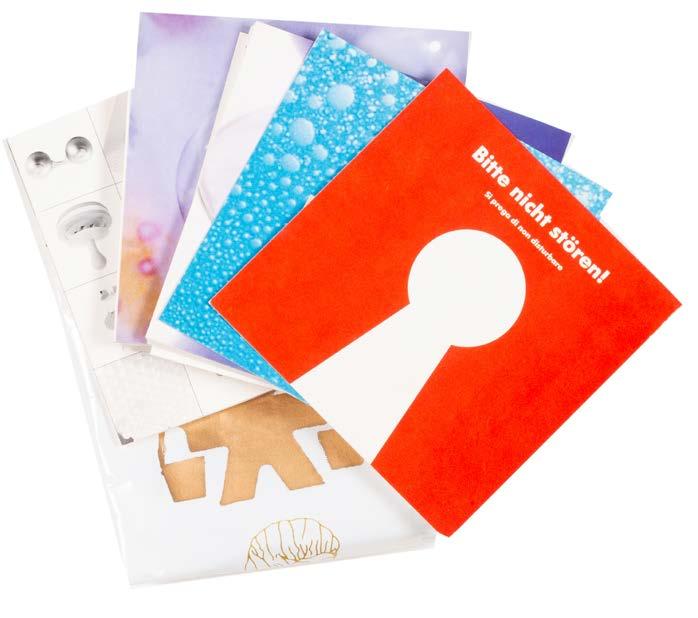
(24). Alessi, Alberto. Die Traumfabrik Alessi Seit 1921. Cologne. Electa / Alessi / Konemann. 1998. Tall 8vo. Illustrated in colour. Wrappers. pp.128. • Alessi monograph written by Alberto Alessi. The book details the company’s history, including the inspirations behind their iconic designs and the collaborations that have made them famous.
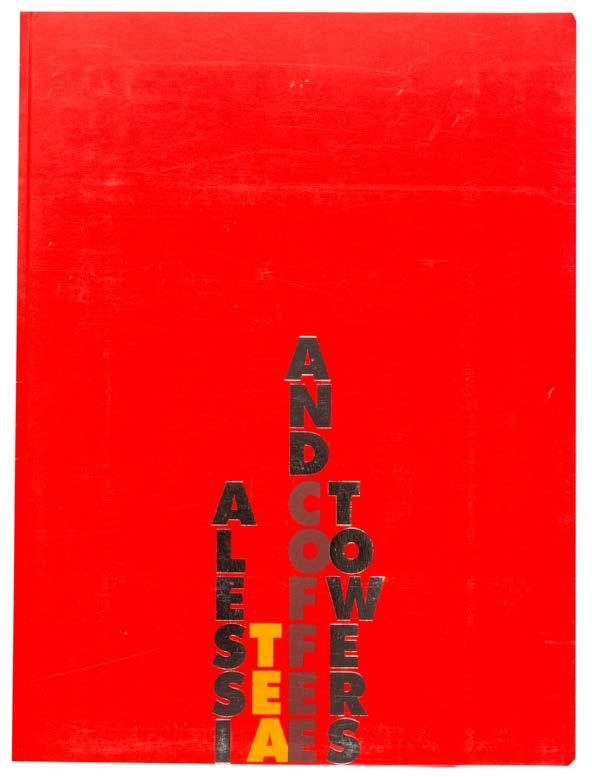
Text in German.
(25). Im Bad Mit Alberto. (Alessi Werkstatt. Hochschule für bildende Kunste. Hamburg 2000). Alessi. 2000 Small box (110 × 110 × 75 mm). Illustrated in colour. • Loose cards showcasing various bathroom-related designs; shower cap included, unopened (in its original wrapper). Boxed publication made on the occasion of the ‘Im Bad mit Alberto: Nel Bagno con Alberto’ exhibition at Stilwerk Hamburg (March 2000). Image: see also top half of page.
(26). Alessi: Tea and Coffee Towers. (Exhibition press folder). Crusinallo. Alessi. 2003. 4to. Illustrated in colour. Original publisher’s folder. • A metaproject by Alessandro Mendini. The exhibition ‘Tea and Coffee Towers’ was presented at the Palazzo della Triennale (Milan) from April–May 2003. 22 architects from 10 countries were involved, including David Chipperfield, Jean Nouvel, Vito Acconci, Zaha Hadid, Future Systems and Will Alsop.
Arflex Arteluce Artemide B&B Italia Bonacina
Aldo Bai, Pio Reggiani, Renato Teani, Carlo Barassi • 1947
Franco Albini
Achille Castiglioni
Marco Zanuso
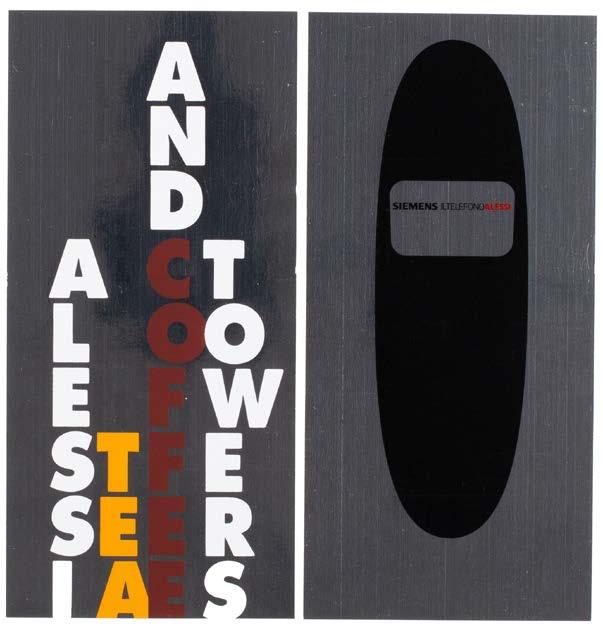
(27). Tea and Coffee Towers / Siemens Il Telefono Alessi. (Invitation card). Crusinallo. Alessi. 2003. Two cards. (210 × 100 mm). Coloured text and designs on silver paper. • Invitations in the original Alessi grey envelope for presentations at the Triennale of Milan, in 2003: ‘22 projects for tea and coffee sets’ (a metaproject by Alessandro Mendini) and ‘Siemens Il Telefono Alessi’, a new cordless telephone by Stefano Giovannoni.
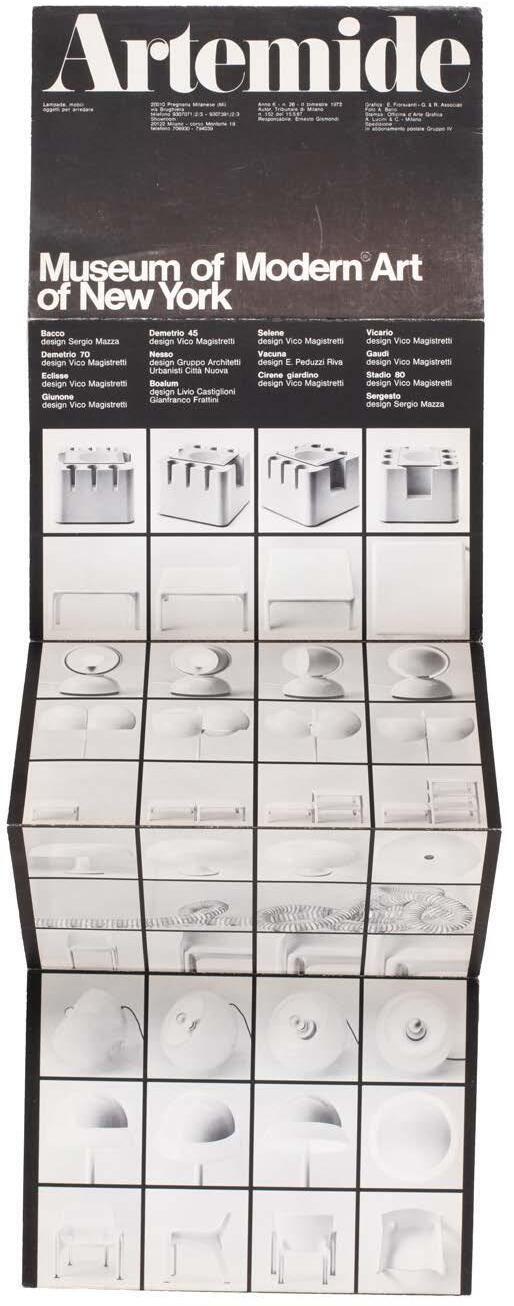
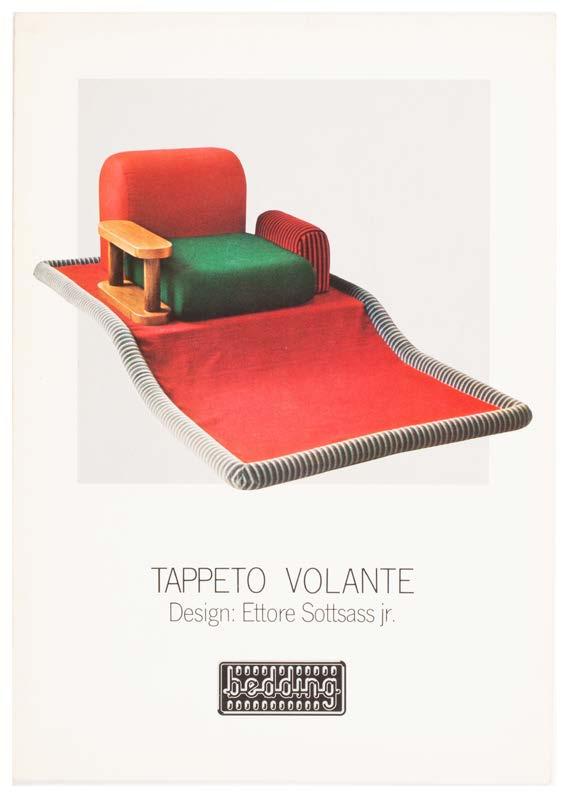
BEDDING BREVETTI: (36). Sottsass, Ettore. Tappeto Volante. Pistoia. Bedding. 1970s. 4to. • Sottsass designed the ‘Tappeto Volante’ (Flying Carpet) armchair for Bedding Brevetti in 1974. ‘The exotic, mystical world that (...) Sottsass found on a journey to India inspired his Flying Carpet chair. It is a fanciful creation whose elemental parts are a series of geometric volumes that are enhanced by a dramatic use of primal color and pattern.’ (MFAH, Houston).
Gino Sarfatti • 1939
Franco Albini
Cini Boeri
Carlo Mollino
Ico Parisi
Massimo Vignelli
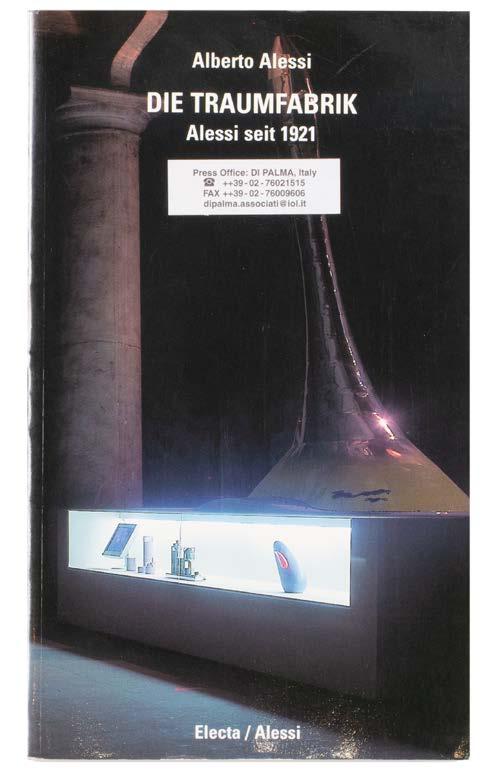
(28). Alessi, Alberto. Die Traumfabrik Alessi seit 1921. Milan. Alessi / Electa. 2003. Tall 8vo. Illustrated in colour. Glossy wrappers. pp.150. • Expanded edition of this Alessi monograph with text in German. (See also cat. no. 24).
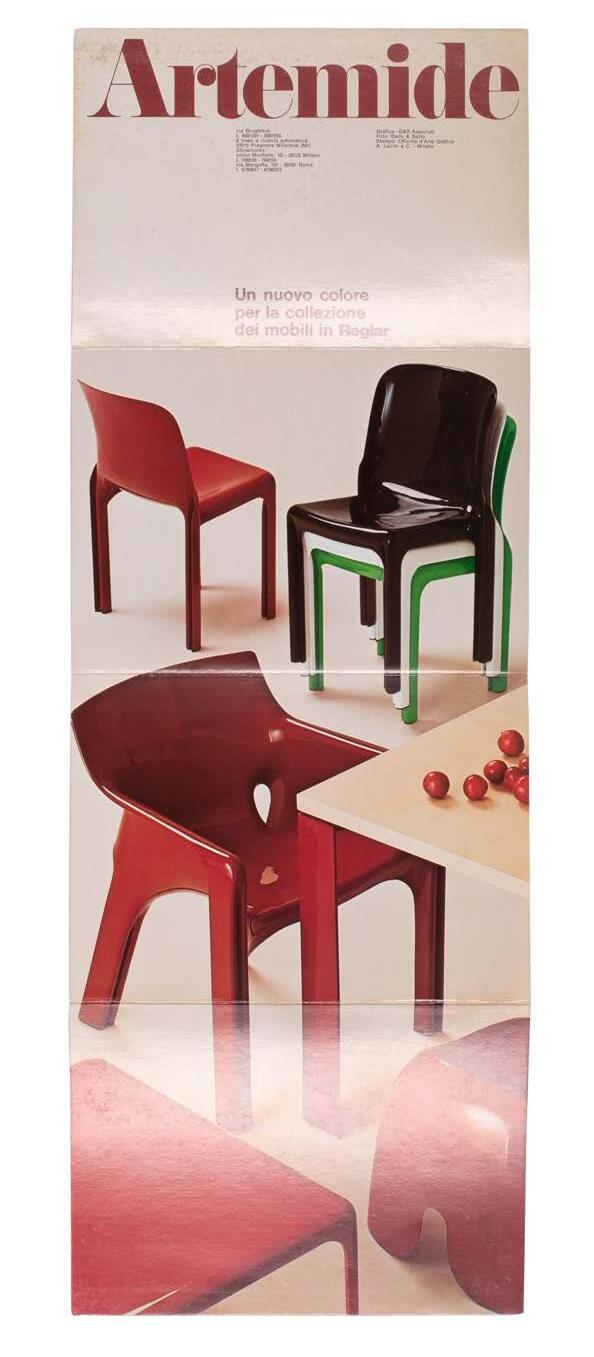

BONACINA: (37). (Sales brochure). Meda. Bonacina. 1972. 4to. Illustrated in colour. Hole-punched wrappers. pp.56. • Includes designs by Sottsass, De Pas, Lomazzi, D’Urbino, and others. Bonacina was founded as early as 1889 by 21-year old Giovanni Bonacina who began making rattan furniture in Lurago d’Erba, a hilly area located outside northern Milan. From 1951 Franco Albini took the company further by updating pre-existing designs.
Ernesto Gismondi, Sergio Mazza • 1960
Richard Sapper
Michele De Lucchi
Ettore Sottsass
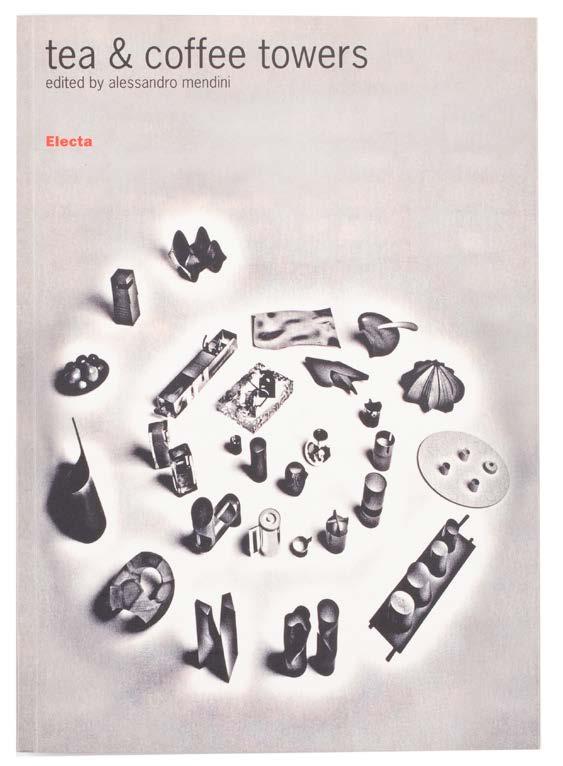
(29). Alessi. Tea and Coffee Towers. Milan. Mondadori Electa. 2003. 4to. Illustrated mostly in black & white. Wrappers. pp.190. • Monograph edited by Alessandro Mendini.
Piero Ambrogio Busnelli • 1966
Mario Bellini
Gaetano Pesce
Richard Sapper
Afra and Tobia Scarpa
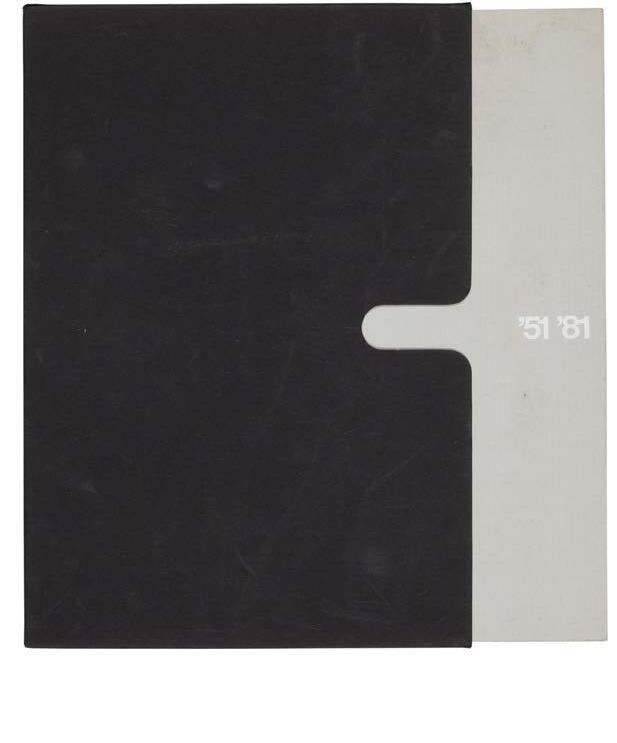
ARFLEX: (30). Baroni, Daniele, et al. ’51–’81. Milan. Arflex. 1981. 4to. Illustrated mostly in black & white. Paper covered boards, original black card slipcase. pp.68. • Publication celebrating 30 years of Arflex. With an invitation card to the 1983 Milan Italian Furniture Fair inserted loose. From modest beginnings in Milan’s Corso di Porta Vittoria, the Arflex company was presented to the public for the first time in 1951, at the IX Triennale in Milan.
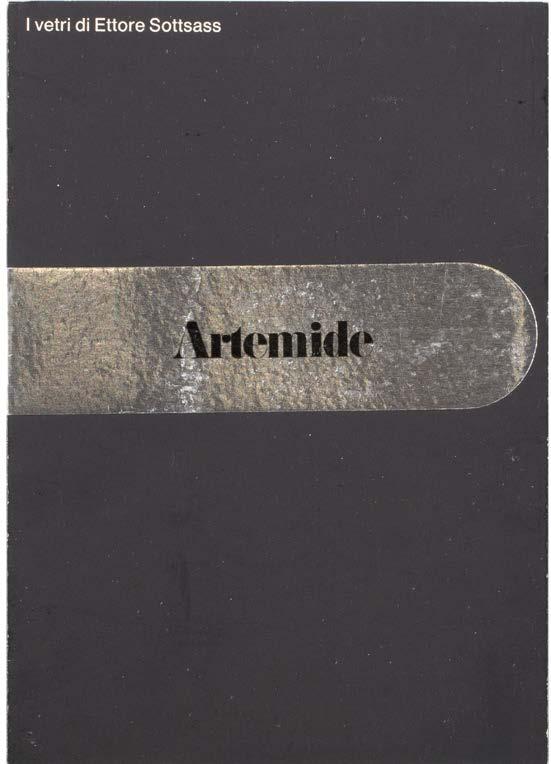
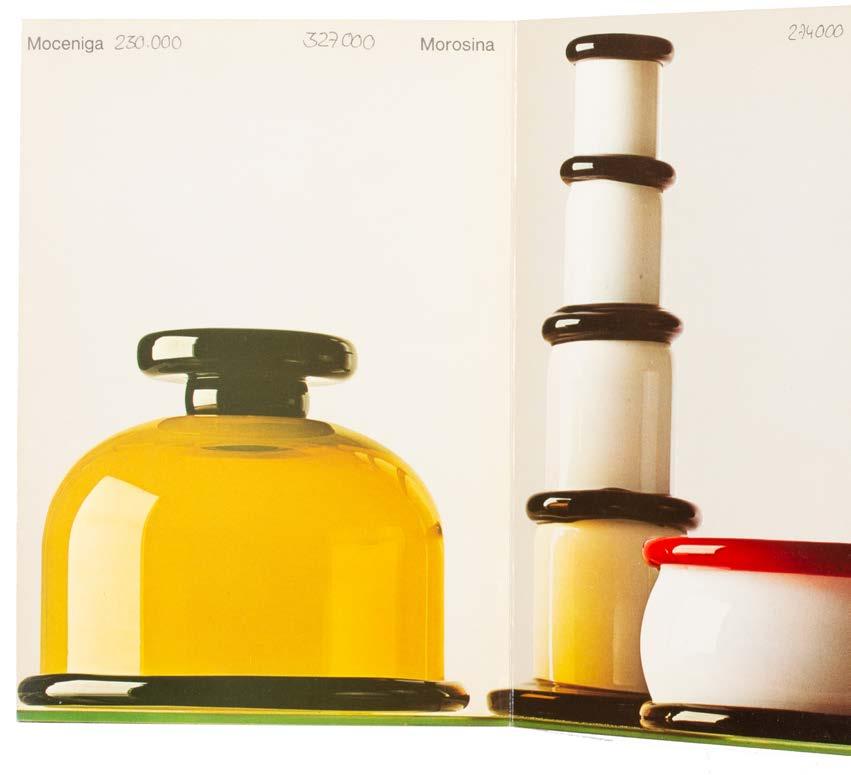
ARTEMIDE: (32). Artemide / Museum of Modern Art. (Promotional material). Milan. Artemide. 1972. Leporello. (150 × 893 mm, unfolded). Illustrated in black & white. pp.6. • Leporello publication showcasing ‘Lampade, mobili, oggetti per arredare’ shown at MoMA, New York. Image: left.
(33). Un nuovo colore per la collezione dei mobili in Reglar. Milan. Artemide. (1980s). Illustrated in colour, to both
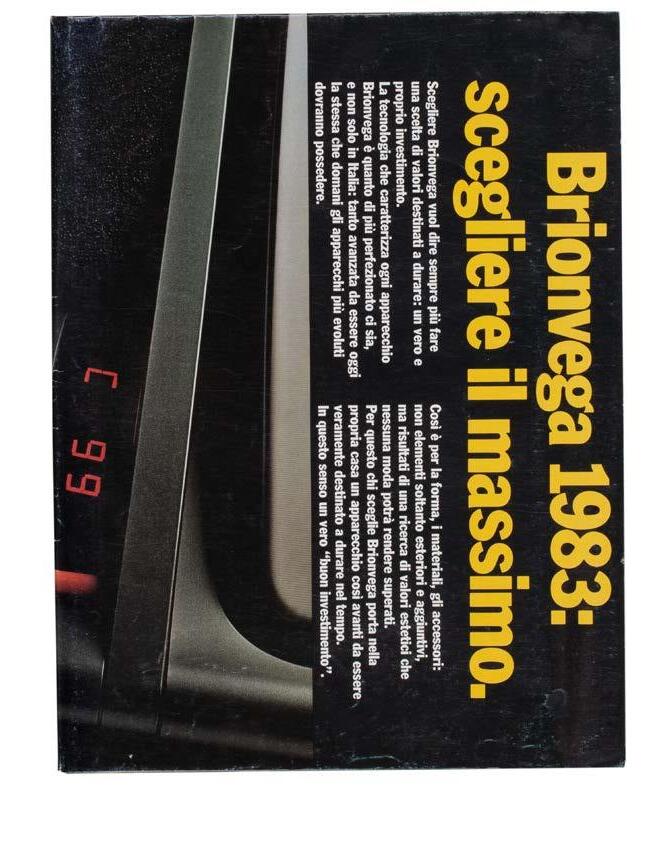
BRIONVEGA: (38). Brionvega 1983: scegliere il massimo. Milan. Brionvega. 1983. Folio. Illustrated in colour. pp.20. • The electrics company Brionvega was founded in Milan in 1945 by Giuseppe Brion. Known for manufacturing television sets and audio equipment, it made a large impact through its contribution to post-second world war technological and social advancement, also collaborating with well known industrial designers and architects.
Giovanni Bonacina • 1889
Paolo Lomazzi
Jonathan De Pas
Ettore Sottsass
Donato D’Urbino
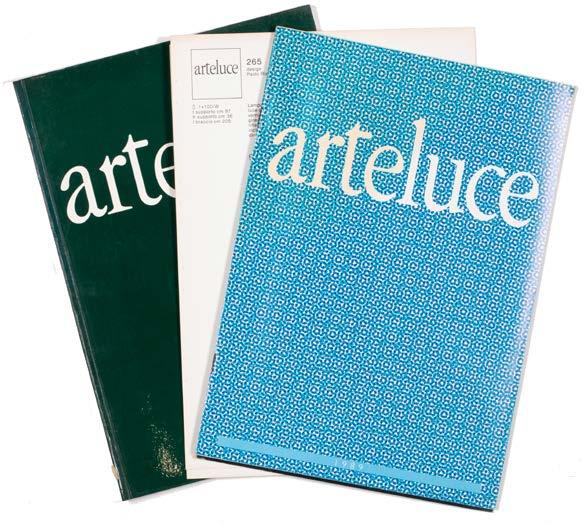
ARTELUCE: (31). Arteluce. (Five brochures). Brescia. Arteluce Undated. 4to. Illustrated in colour and black & white. Wrappers. • Brochures showcasing lighting designs by Cini Boeri and Gino Sarfatti. During the late 1950s until 1973, Arteluce collaborated with the most important Italian designers of the time. Sarfatti designed the lighting for Carlo Mollino’s Teatro Regio in Turin to wide acclaim.
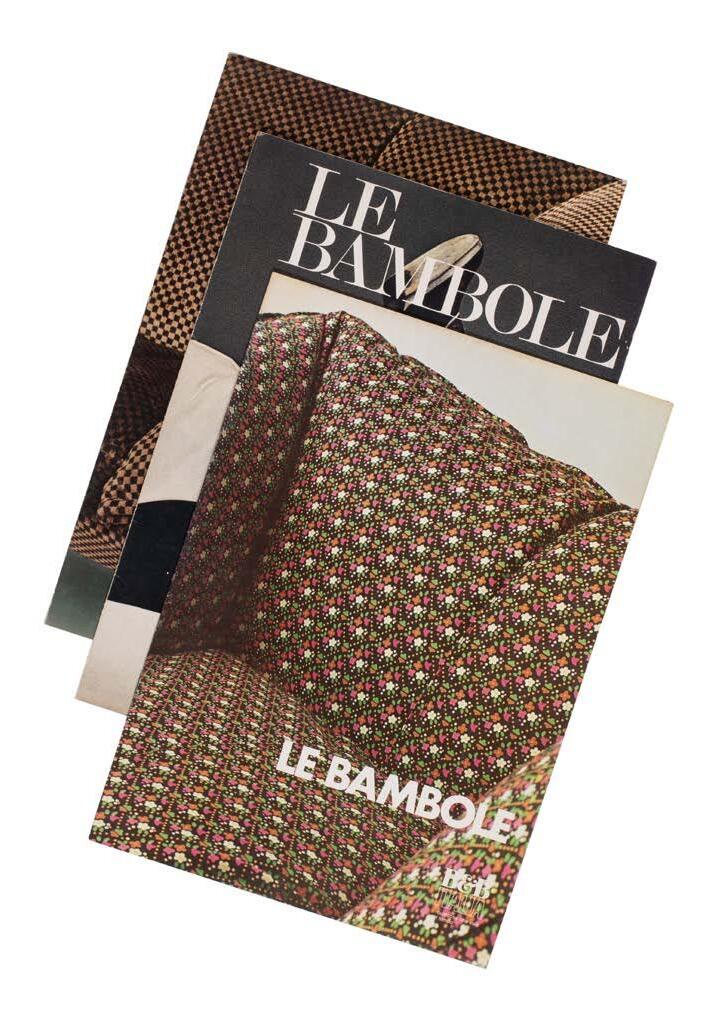
recto and verso. pp.8. • Artemide leporello showcasing a new coloured Reglar furniture range. With annotations in pen to one page. Image: left. (34). Sottsass, Ettore. I vetri di Ettore Sottsass. Milan. Artemide. Undated. Folded card, (210 × 150 mm).
• Leporello flyer for Sottsass glass works. With some annotations.
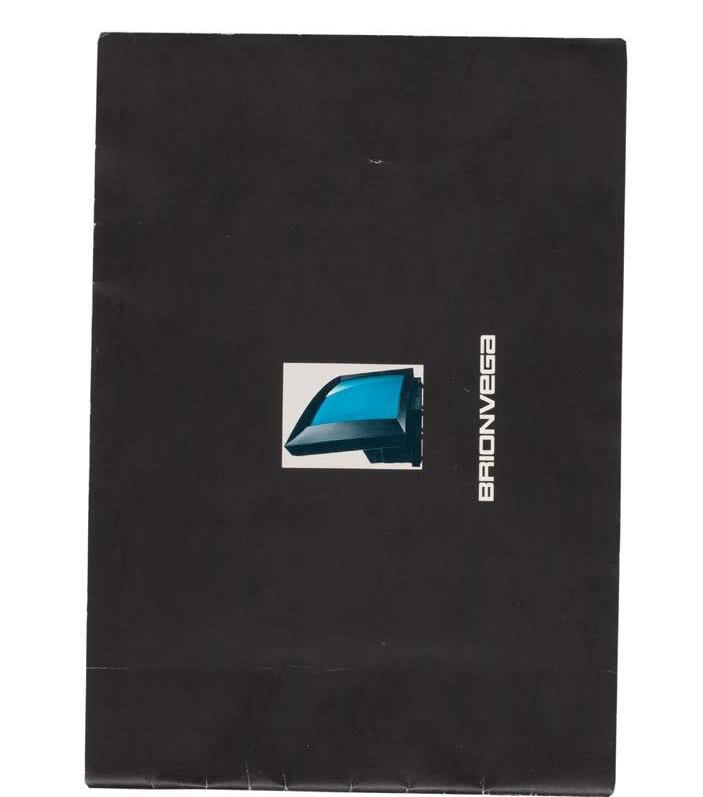
(39). Brionvega. Sales / product pack. Milan. Brionvega. Undated. 4to. Illustrated in colour. Loose as issued in Brionvega folder. • Products include: ‘algol ‘11’, ‘ts 502’, ‘black st 201 12’, ‘rr 127’, ‘fd 1102’, ‘volans 17’, ‘yades 23’, and ‘rr 126 fo/st’. Image: left hand page.
(40). Brionvega. Milan. Brionvega. Undated. Oblong 4to. Illustrated in colour. Stapled wrappers.
B&B ITALIA: (35). Bellini, Mario. Le Bambole. Le Stelle. (Three sales catalogues). Novedrate. B&B. (1970s). 4to. Illustrated in colour. • Sales brochures showcasing Mario Bellini’s new range of chairs, sofas and beds for B&B Italia. ‘The Bambole is a new concept of sitting.’

•
(41). Brionvega. Guida ragionata all’acquisto di un televisore a colori. Milan. Brionvega. Undated. Folio. Illustrated in colour. Stapled wrappers.
Guide to buying a color television.
Cappellini Cassina
Enrico Cappellini • 1946
Cini Boeri
Shiro Kuramata
Jasper Morrison
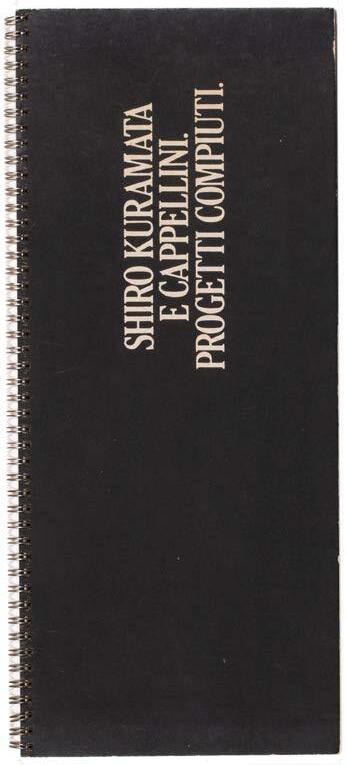
CAPPELLINI: (42). Shiro Kuramata e Cappellini. Progetti Compiuti. Carugo. Cappellini. 1986. Oblong 4to. Spiralbound boards. Illustrated in black & white. • Beautifully produced Kuramata publication from Cappellini on his chest of drawer designs, ‘progetti compiuti’. With a biography and introduction by Patrizia Scarzella. This celebrated design comprises various chests of drawers with curved and linear forms, initially designed in the 1970s.
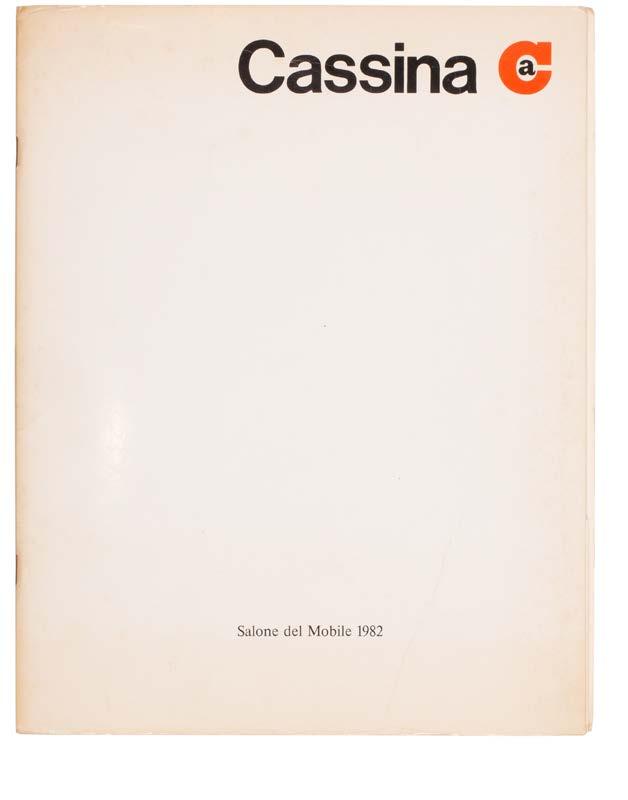
(49). Cassina. Salone del Mobile 1982. Milan. Cassina. 1982. 4to. Wrappers. • Cassina press folder for the Salone del Mobile, 1982. With text in French, English, German and Italian by Mario Bellini, Paolo Deganello, Piero De Martini, and information on a fabric collection by Jack Lenor Larsen. With booklet ‘Campagna Stampa 1979–80’. Additional colour slide.
Cesare Cassina, Umberto Cassina • 1927
Mario Bellini Paolo Deganello Piero De Martini
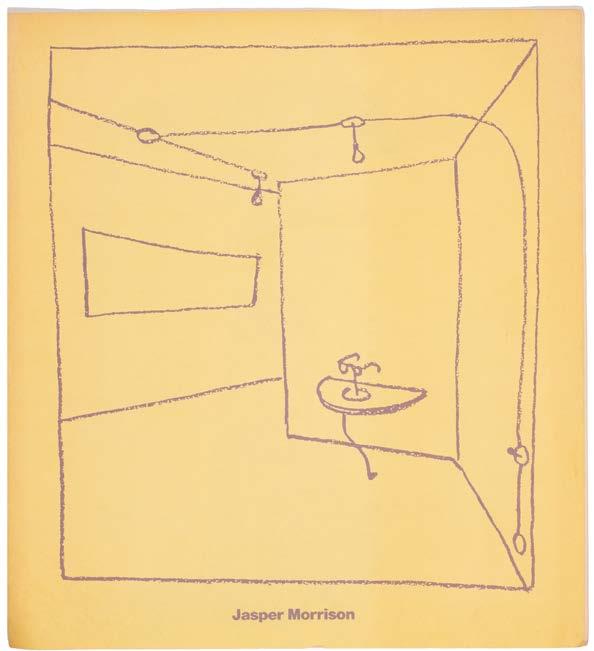
Forma e Funzione Cristal Art Danese Milano
1960s John L. Monk Joe Colombo
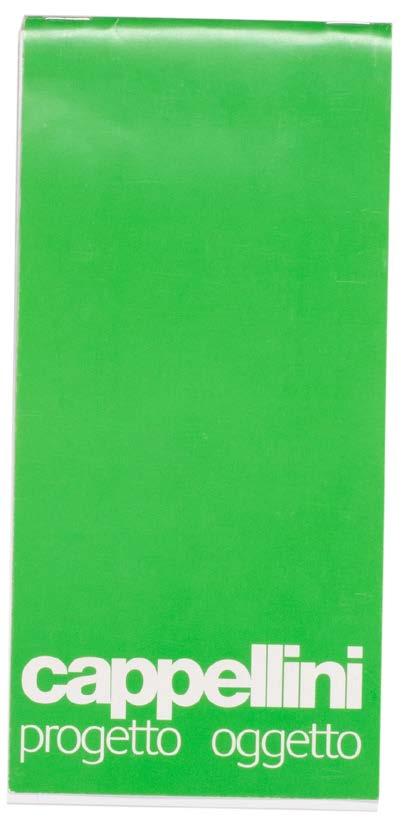
(43). Rinaldi, Rosa Maria. Jasper Morrison. Arosio. Cappellini. 1989. Folio. Illustrated in colour. Stapled wrappers. pp.8. • Early Jasper Morrison / Cappellini promotional piece.
(44). Cappellini. Progetto Oggetto. Arosio. Cappellini. 2000. Oblong 8vo. Illustrated in colour. Stapled wrappers. pp.40. • ‘A collection of small objects, necessary and not so necessary, for
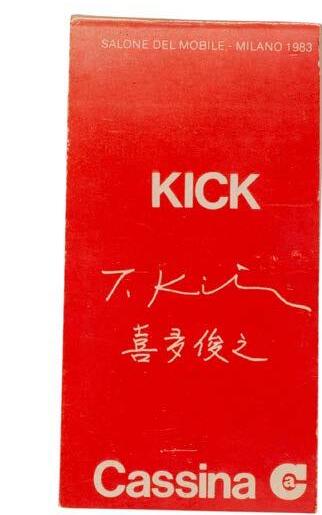
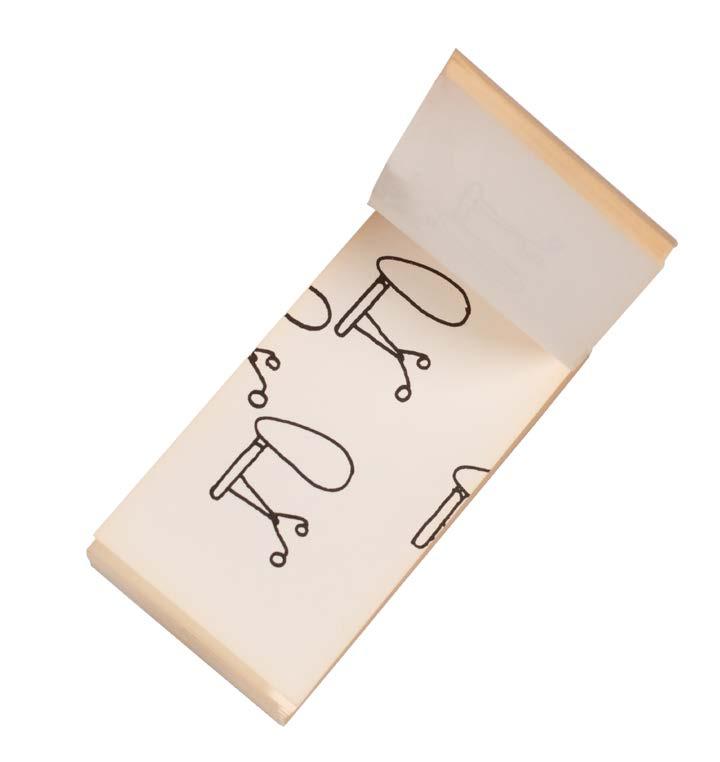
Illustrated in black & white. Wrappers.
• Cassina flip-book with playful line drawings of chairs and stools. Published on the occasion of the Salone del Mobile, Milan, 1983. The ‘Kick Table’ was designed in 1983 by Japanese designer Toshiyuki Kita. Its adjustable height and pivoting top, offering flexibility in modern living spaces.

FORMA E FUNZIONE: (55). Favata, Ignazia, et al. Forma e funzione. (1970s) 4to. Illustrated in black and white. Wrappers. pp.20. • ‘At the last Triennale in Milan, the Spot model, a small low-voltage spotlight, was presented. This model was designed by John L. Monk. This American designer also heads the company’s development department and has made a significant contribution to the series production of Joe Colombo’s models. With these

models, shown in the catalogue, Forma e Funzione wants to start massproducing a series of as yet unfinished objects by the designer, who died in 1971.’ (From the final leaf).
CRISTAL ART: (56). (Superstudio, Giuseppe Raimondi, Piero Gilardi et al.) Cristal Art. (Sales catalogue). Turin. Cristal Art. (1970s). Square 4to. Wrappers. pp.44. • In 1969, Cristal Art, with Giuseppe Raimondi as art
Giuseppe Donna, Giovanni Donna • 1944
Superstudio Giuseppe Raimondi Piero Gilardi
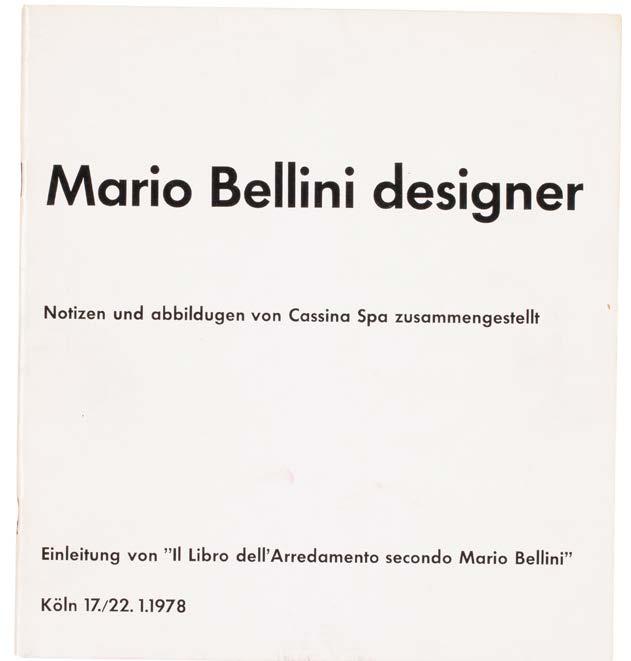
CASSINA: (45). Aeo: Archizoom Cassina. Präsentieren in Zusammenarbeit. Operation Sit-In. Archizoom-Cassina. c.1975. Folio. Illustrated in colour. Stapled wrappers. • The iconic Cassina/ Archizoom co-published newsprint publication in the form of a comic strip, advertising Paolo Deganello’s AEO armchair. With large folded poster loose within (‘Wo Kann Ich Das Aeo Hinstellen?’), with index printed verso. Further images and description on p.12.

Opuscolo Collezione Cassina. Milan. Cassina. 1985. 4to. Illustrated in colour. Glossy wrappers. pp.108.
• The second edition of this Cassina monograph on their designers. Chapters on Gio Ponti, Gianfranco Frattini, Vico Magistretti, Afra and Tobia Scarpa, Mario Bellini, Piero De Martini, Archizoom / Paolo Deganello, Gaetano Pesce, Toshiyuki Kita and Massimo Morozzi. Additional sheets related to Cassina inserted loose.
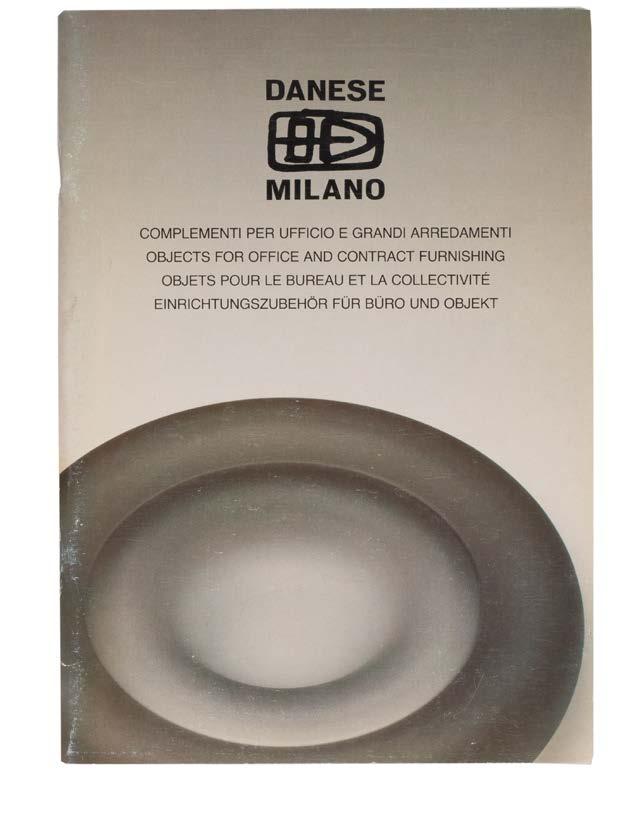
director, started producing a collection of crystal pieces and mirrors for furnishing.’ (From the introduction). With an additional flyer inserted loose.
DANESE MILANO: (57). Danese Milano. Complementi per Ufficio e Grandi Arredamenti. Milan. Danese. (1970s). 4to. Illustrated in colour. Stapled wrappers. pp.34. • Bruno Danese catalogue showcasing the designs of Enzo Mari and Bruno Munari. Danese
(46). Mario Bellini designer. Notizen und abbildugen von Cassina Spa zusammengestellt. Einleitung von ‘Il Libro dell’Arredamento secondo Mario Bellini’. Milan. Cassina. 1978. 4to. Illustrated in black & white. Stapled wrappers. pp.36. • Bellini monograph compiled by Cassina.
(47). Cassina. Milan. Cassina. 1979. 4to. Illustrated in colour. Red glossy wrappers. pp.96. • Cassina monograph
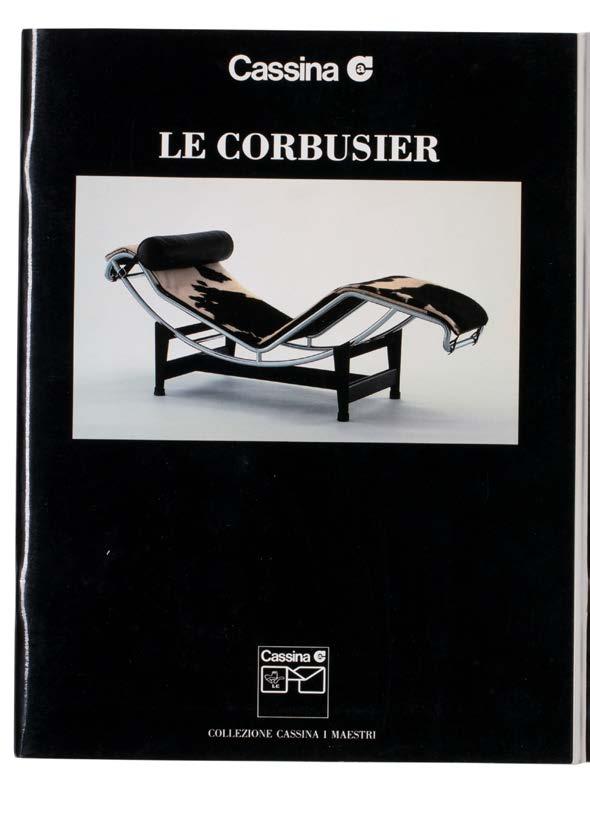
(52). Cassina I Maestri. Le Corbusier. Milan. Cassina. 1987. 4to. Illustrated in colour. Stapled wrappers. pp.40.
• Cassina-Corbusier sales brochure. ‘Cassina I Maestri’ was launched to honor and reissue iconic designs by the great masters.
(53). Cassina I Maestri. Charles R. Mackintosh. Milan. Cassina. 1988. 4to. Illustrated in colour. Stapled wrappers. pp.40. • Cassina brochure for their
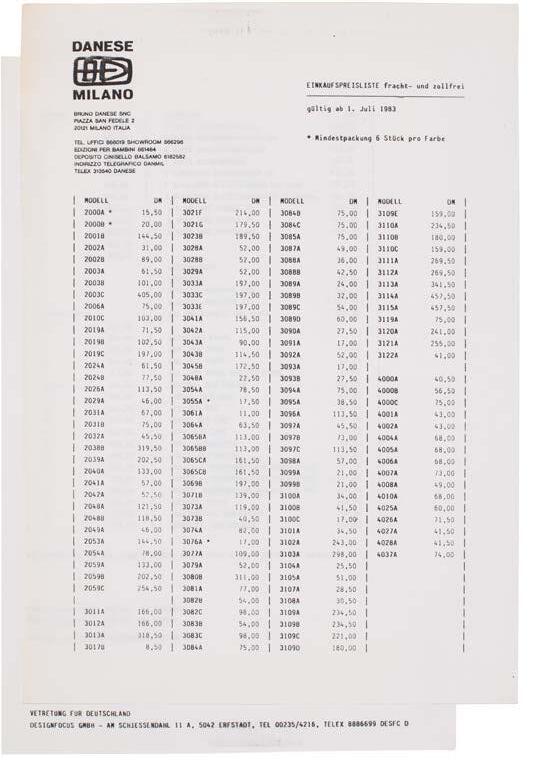
Milano was renowned for its minimalist, functional home and office accessories that fuse art and industrial design through collaborations with iconic artists and designers.
• 1957
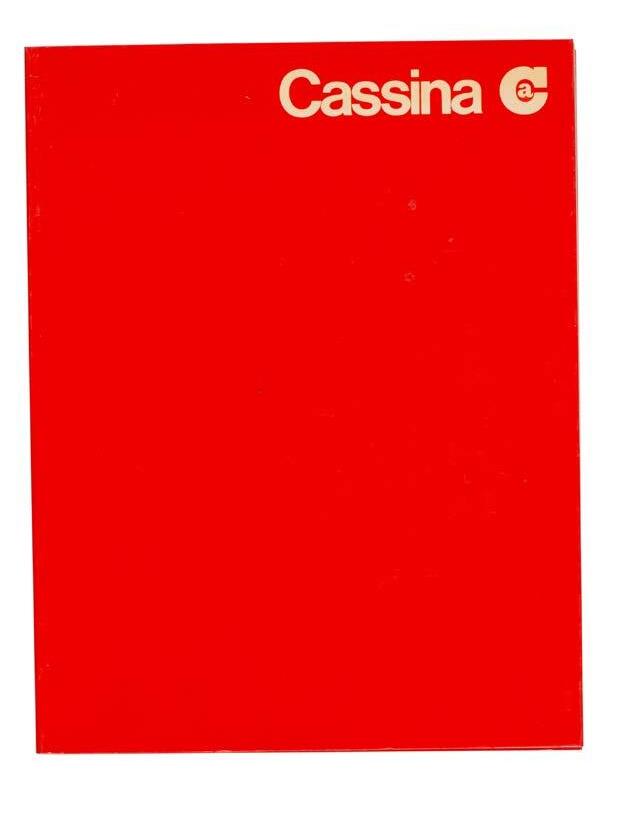
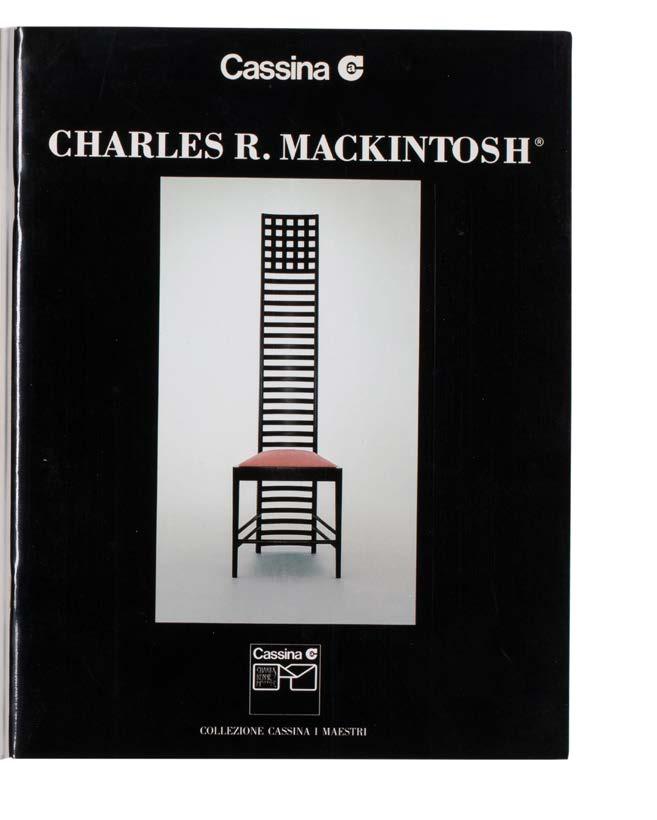
reissue of designs by Charles Rennie Mackintosh.
(54). Cassina. Incontri. Einladung zum Eröffnungsfest 20./21. Baar-Sihlbrugg. Teo Jakob. 2004. 4to. Single folded sheet. Illustrated in colour. pp.4. • Foldout poster invitation / flyer to the exhibition ‘Cassina Incontri’, from Teo Jakob. Image: p.11.
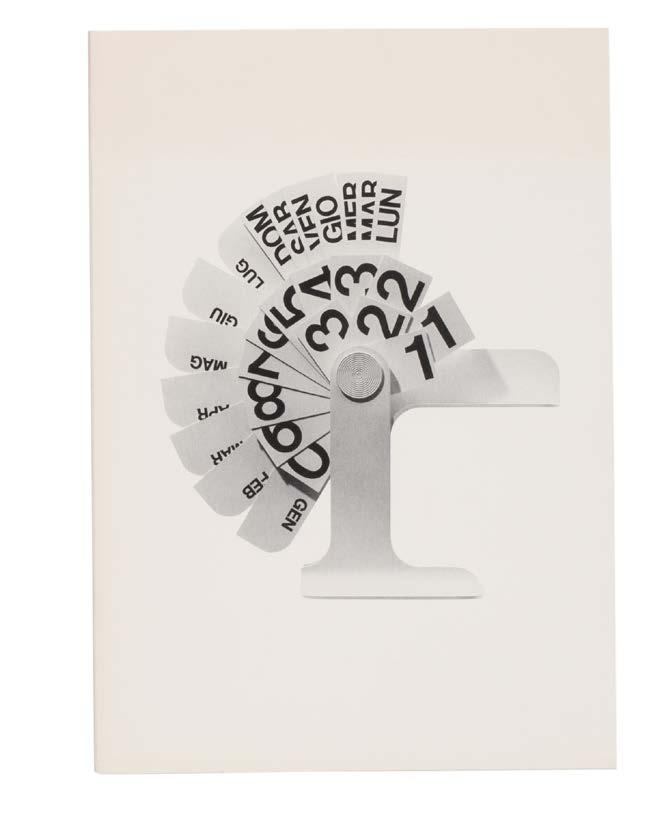
(58). Danese Milano. Einkaufspreisliste. Juli 1983. Milan. Danese. 1983. Two sheets. • Danese price list. (59). Danese, Editeur de Design Italien, Milan. 1957–1991. (Invitation card). Lausanne. MUDAC (The Museum of Contemporary Design and Applied Arts). 2005. Folded card (210 × 148 mm).
• The card illustrates Enzo Mari’s ‘Timor’ perpetual calendar, 1967. The sleek, flip-style display with bold typography, made from durable ABS plastic and lithographed PVC cards remains an iconic example of modern Italian design.
on their designers: Gio Ponti, Vico Magistretti, Tobia Scarpa, Mario Bellini, Piero De Maetini and Paolo Deganello. (48). Vico Magistretti. Vent’anni, venti sedie. Milan. Studio Marconi. 1980. Square 12mo. Illustrated in black & white. Wrappers. pp.22. • Studio Marconi / Cassina publication: twenty chairs for twenty years. Image: p.11.
Bruno Danese, Jacqueline Vodoz
Bruno Munari Enzo Mari
FLOS Fontana Arte Francesconi
Dino Gavina, Cesare Cassina • 1962
Achille Castiglioni
Fabio Lombardo
Tobia Scarpa
Gio Ponti, Liugi Fontana • 1932
Ettore Sottsass


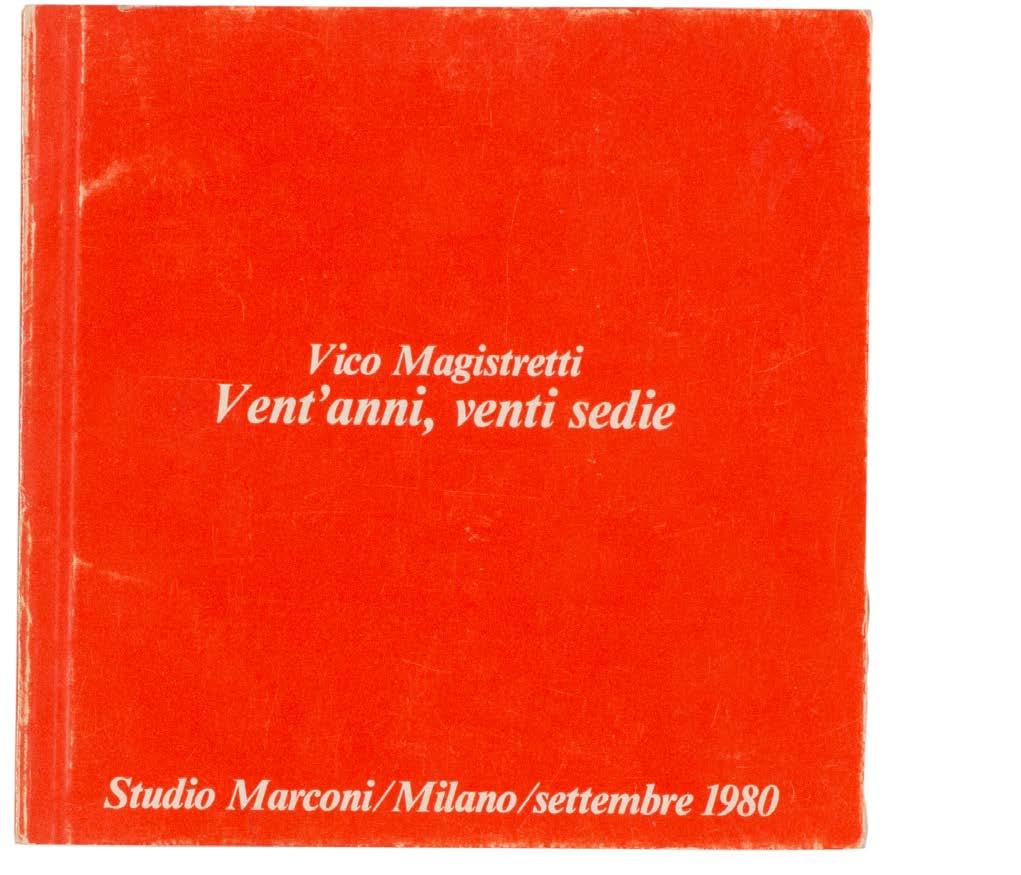


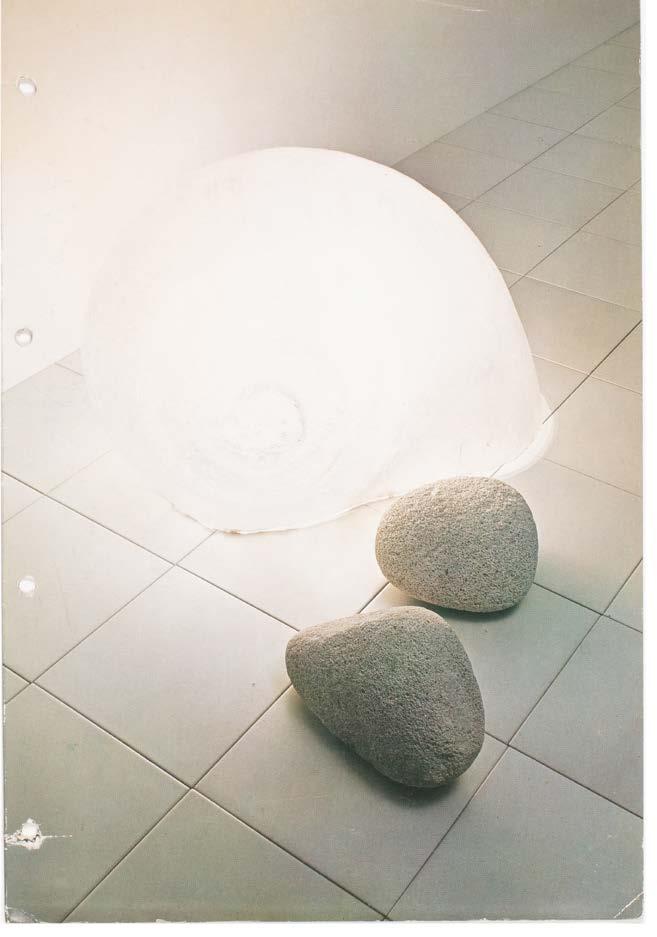
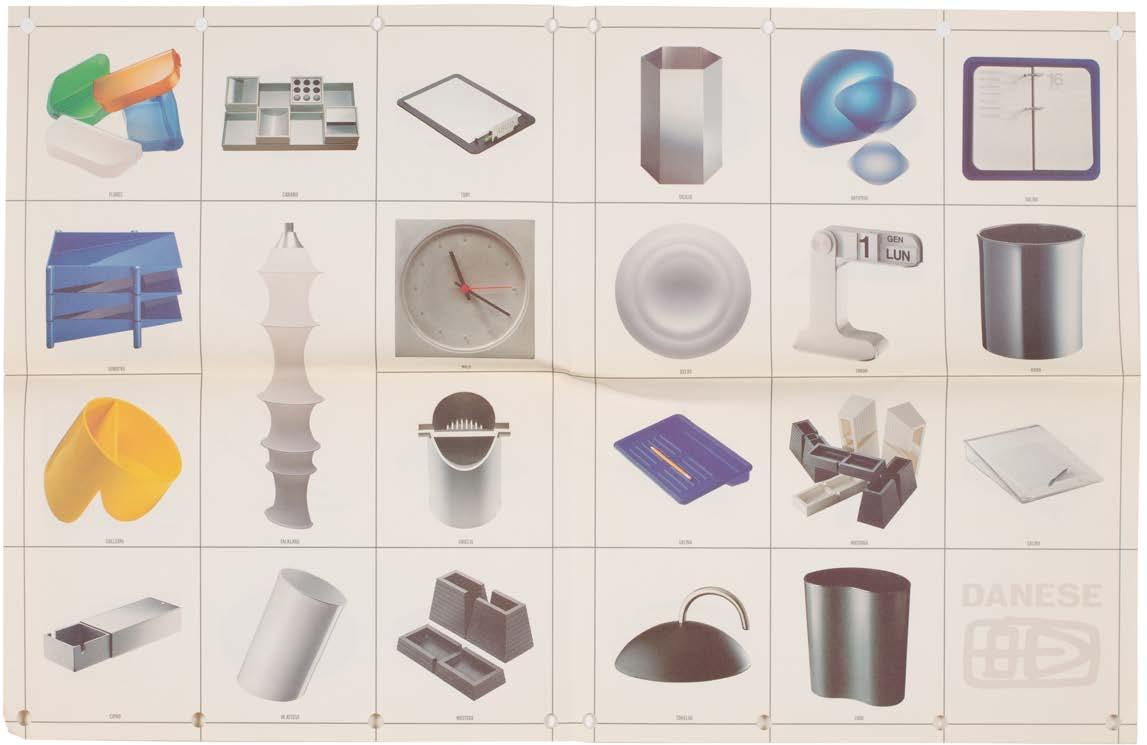
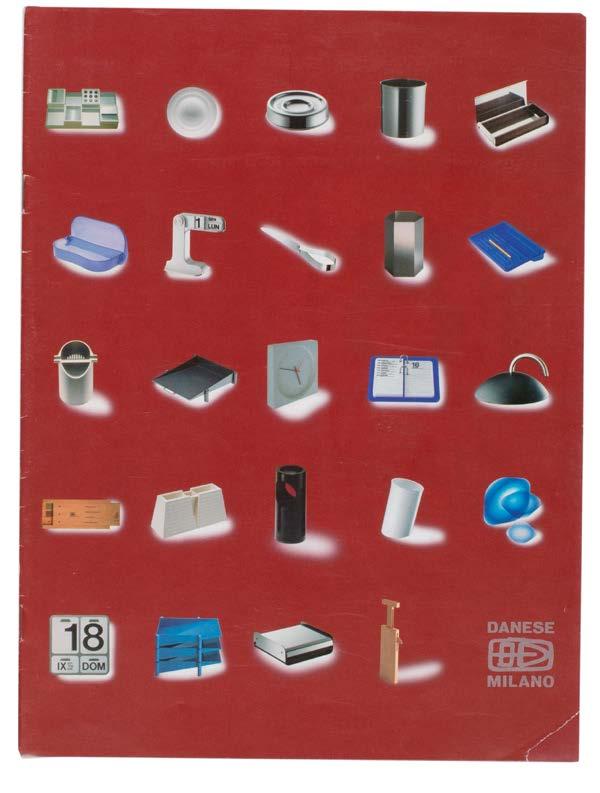
(60). Alias. Danese Milano. Bergamo. Alias. 1990s. 4to. Illustrated in colour. Stapled wrappers. • Danese Milano was bought by Alias in 1994.
(61). Alias. Danese Milano. Bergamo. Alias. (1990s). Large 4to. Illustrated in colour. pp.4. • Product sheet.
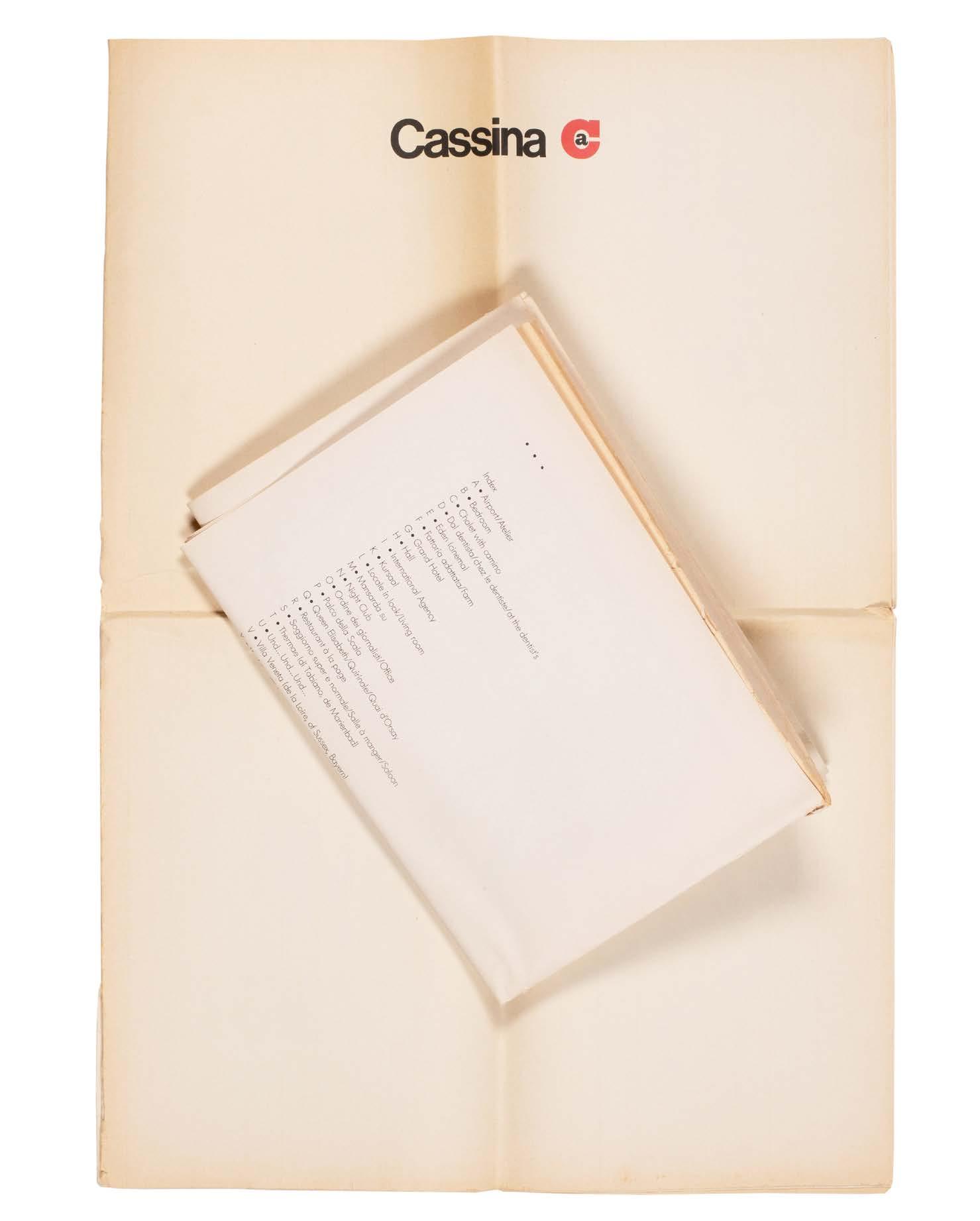
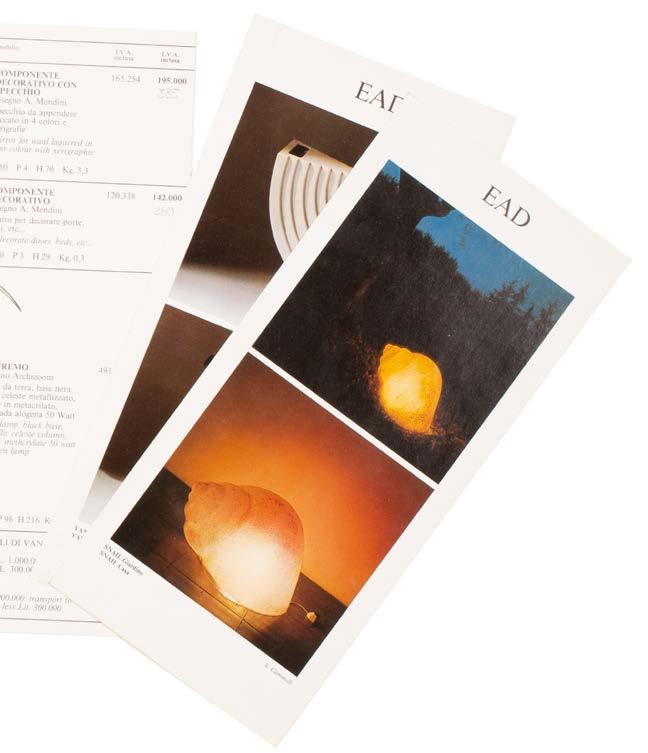
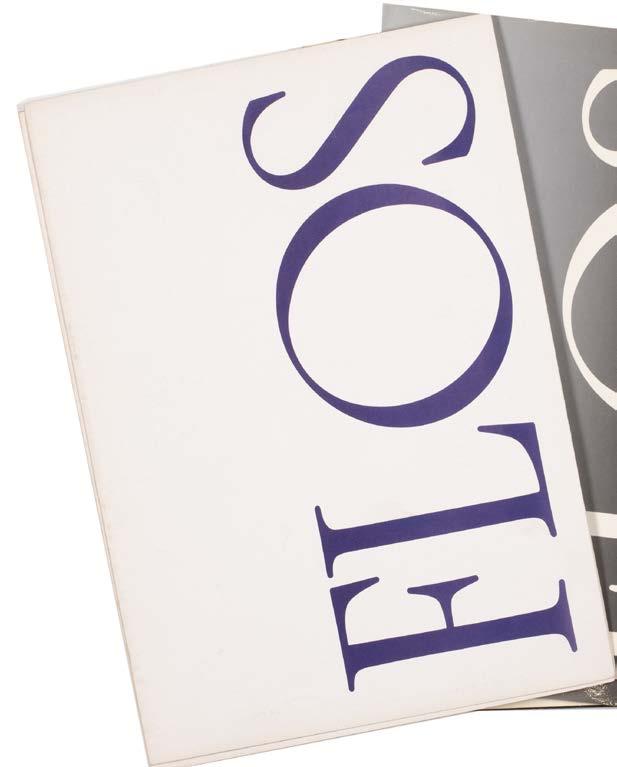
EAD ( Edizioni Arte Design): (62). Camilli & Sottsass. EAD. Listino Prezzi. Pistoia. EAD. 1982. 8vo. • Promotes designs by Sergio Camilli (Snail) and Ettore Sottsass (Yantra 31 and 28), with others. ‘Sottsass designed approximately thirty pieces for the ‘Yantra’ series, including vases, ashtrays, boxes, and bowls. The Sanskrit term yantra denotes a mystical diagram comprising nine interlocking triangles...’ (Metmuseum.org).
FLOS: (63). Castiglioni, Scarpa, Lombardo, et al. FLOS. (12 brochures). 1970s–1980s. 4to. Illustrated in colour. Wrappers. • Includes Preisliste 1982; folded brochures for ‘Bibip’, ‘Ipotenusa’, ‘Frisbi’, and ‘Tamburo’ designs; flyers for ‘Portacenere / Portaombrelli’, ‘Parentesi’ and ‘Chiara’ and a leporello brochure titled ‘apparacchi per ‘l’illuminazione.’ FLOS (founded 1962) pushed the boundaries of lighting technology and aesthetics.

ARTE:
FRANCESCONI: (65). Camilli, Sergio. Snail. (Promotional leaflet). Brescia: Francesconi. 4to. • Camilli’s ‘Snail’ design combined organic forms and innovative lighting solutions, partially by being made from semi-transparent fiberglass. Image: top of page.
FONTANA
(64). Ettore Sottsass. 2679 2663 Oggetti. Fontana Arte. (1980s). 4to.
Part 1 Cassina — Archizoom:
AEO: Archizoom Cassina. Präsentieren in Zusammenarbeit. Operation Sit-In
This large format Cassina-Archizoom co-published newspaper was a playful and engaging way to promote Paolo Deganello’s iconic AEO armchair. The chair was designed for Archizoom Associati in 1973 (Deganello founded Archizoom in 1966 together with Andrea Branzi, Gilberto Corretti and Massimo Morozzi) and was an unorthodox interpretation of the modern armchair, notable for its distinctive shape, use of materials and radical versatility. The chair was initially delivered in pieces to allow the customer to assemble it themselves and was also available in a vast array of upholstery options and combinations. One could also join the chair units together in various formations (‘Und jetzt machen wir mal einen schonen kreis’ (And now let’s make a circle)), making it appropriate for a range of spaces from domestic to corporate use.
The comic strip, where the AEO chair is our central character and thus animated by speech bubbles, is prefaced ‘Diese sind die dartsteller unserer story, einer story, in der sie gut sitzen konnen’ (These are the actors of our story, a story in which you can sit comfortably). The fold-out poster (titled ‘Wo kann ich das AEO hinstellen? (Where can I put the AEO?)) measures 965 × 670 mm. To the poster’s verso is an alphabetical index with each letter corresponding to a place illustrated overleaf (A: Airport/Atelier, B: Bedroom, C: Chalet with camino, etc).
‘The quintessence of functionality and versatility, AEO is thus typical of a Cassina piece, since it can be taken apart and washed, while being light and comfortable, the perfect partner for any space and style.’ (Cassina.com).
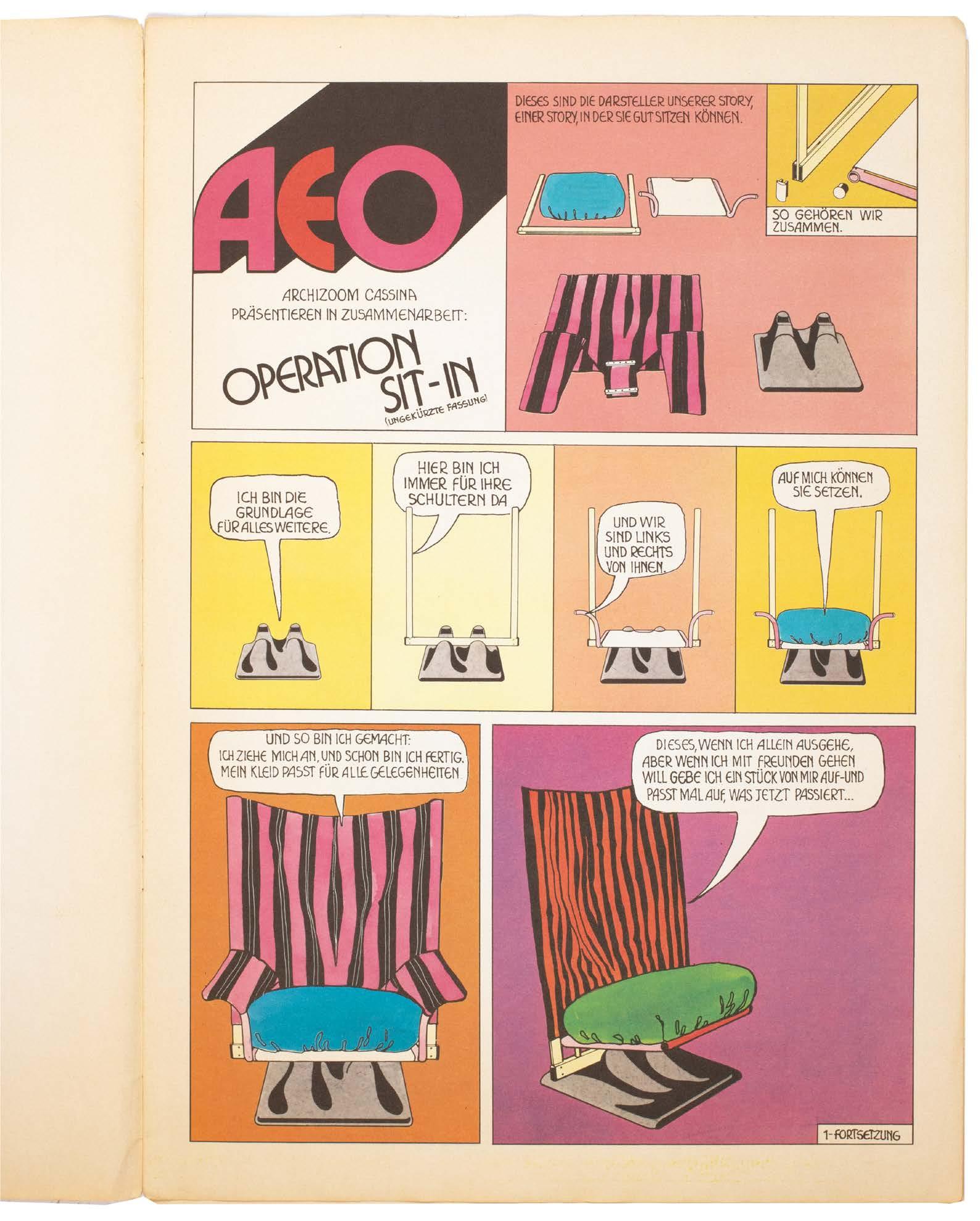
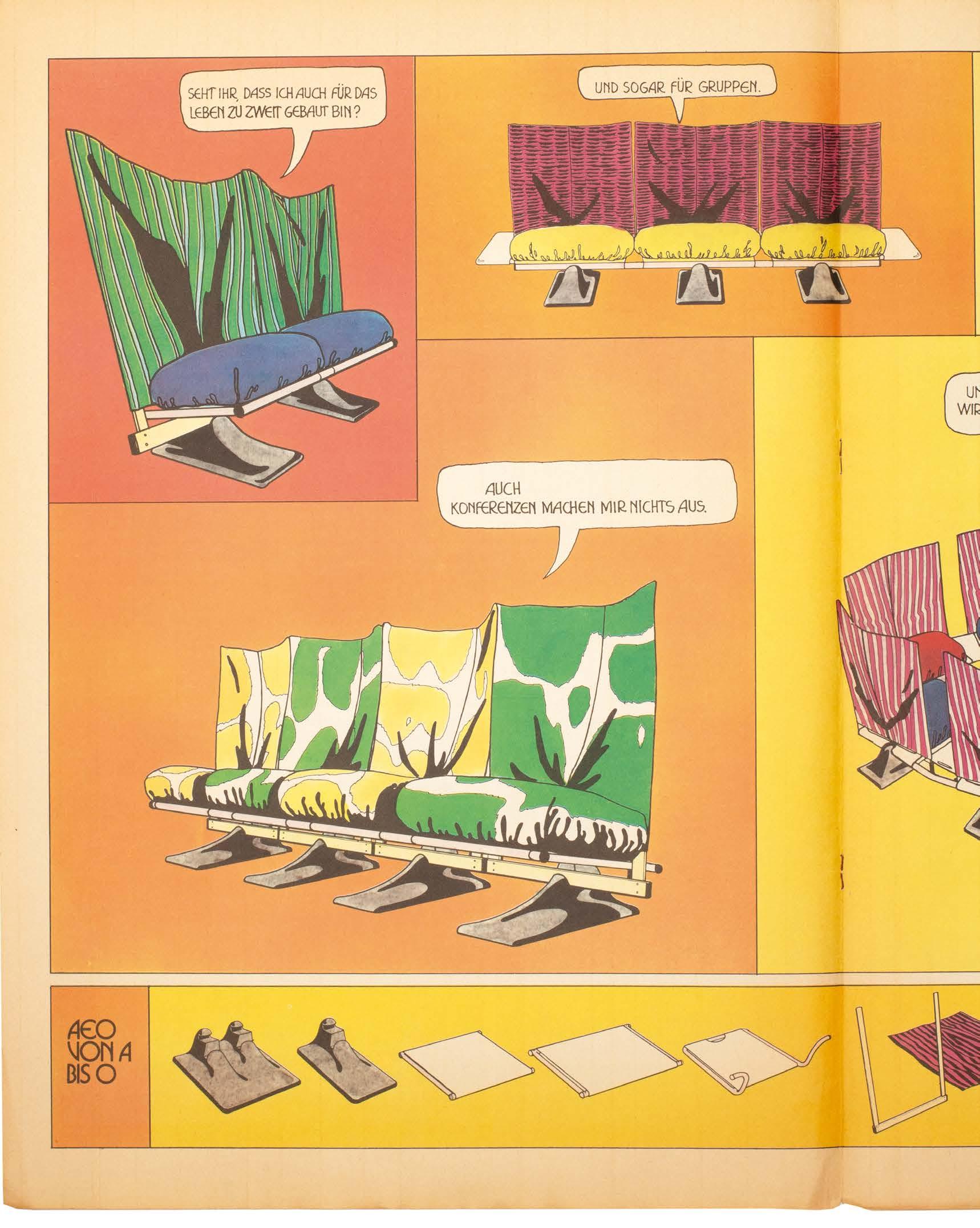
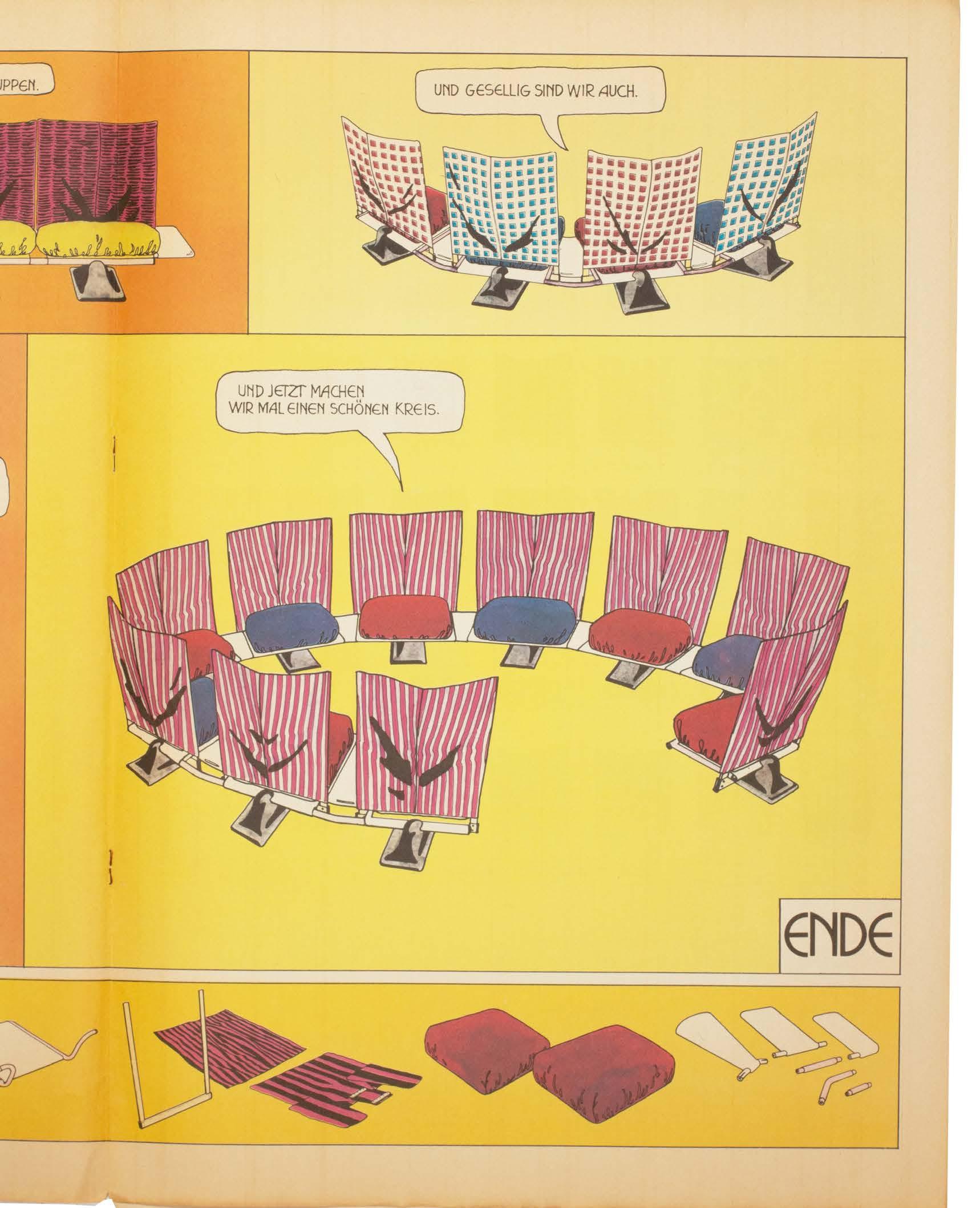
Right hand page, clockwise from top left: no.73, no.32/33, no.66
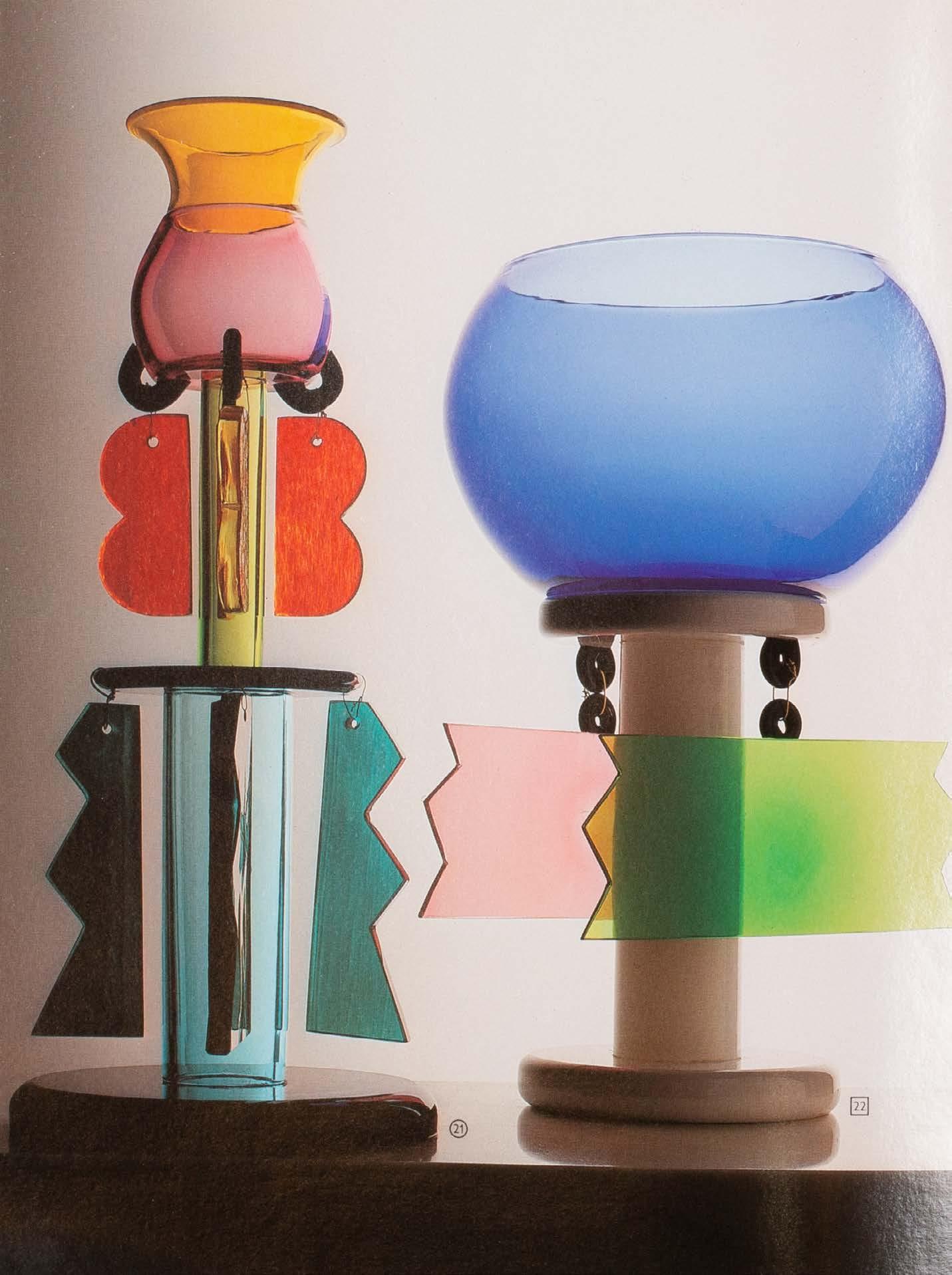
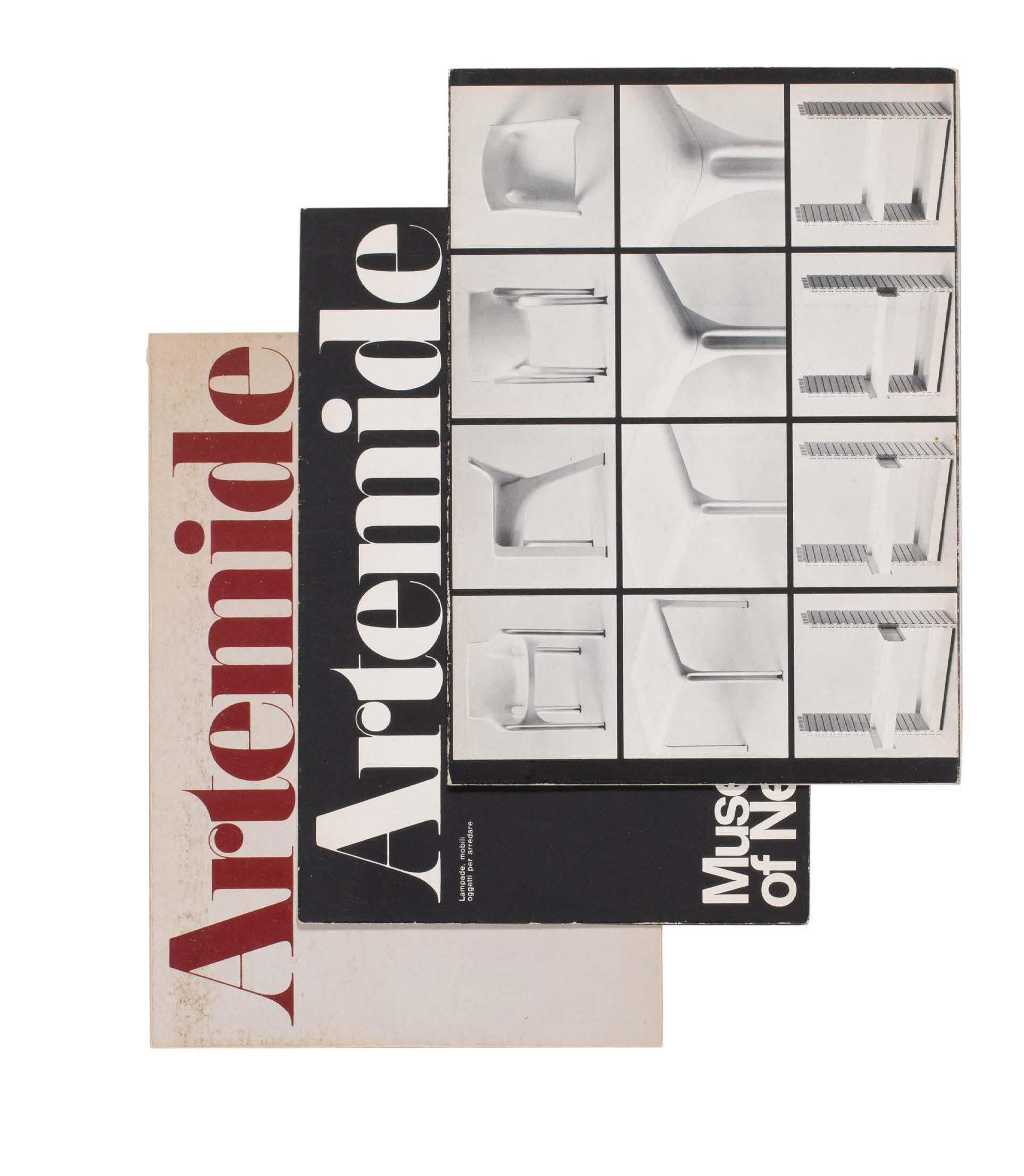
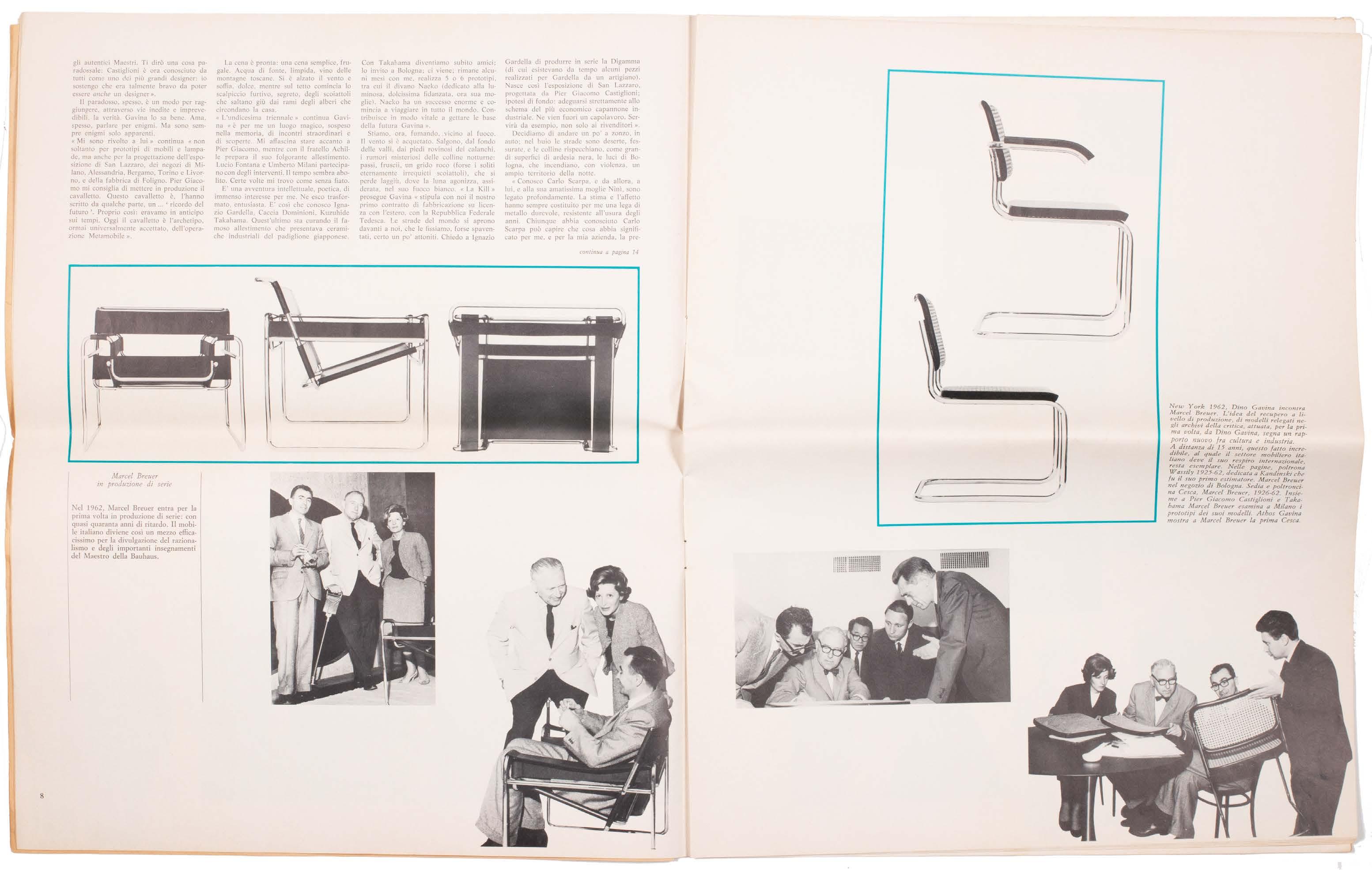
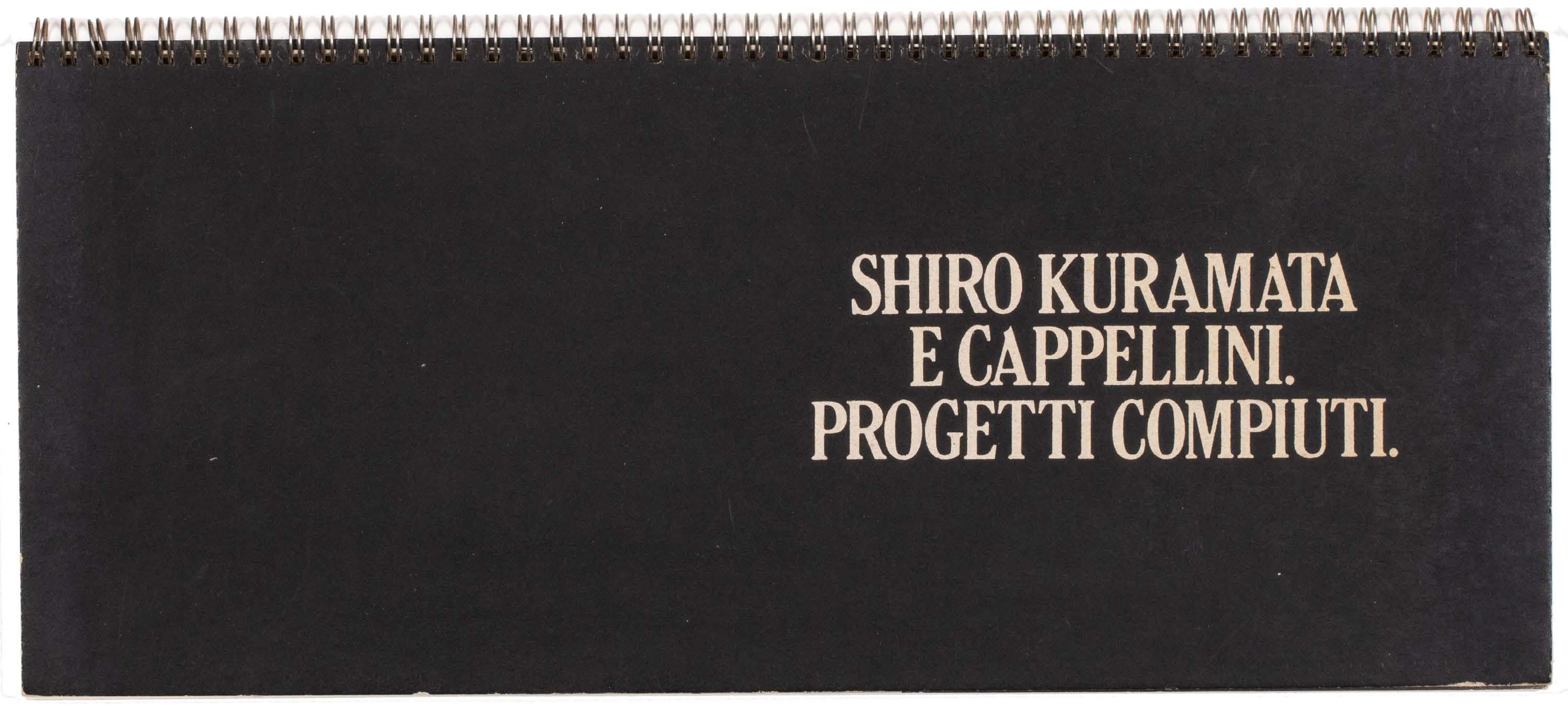
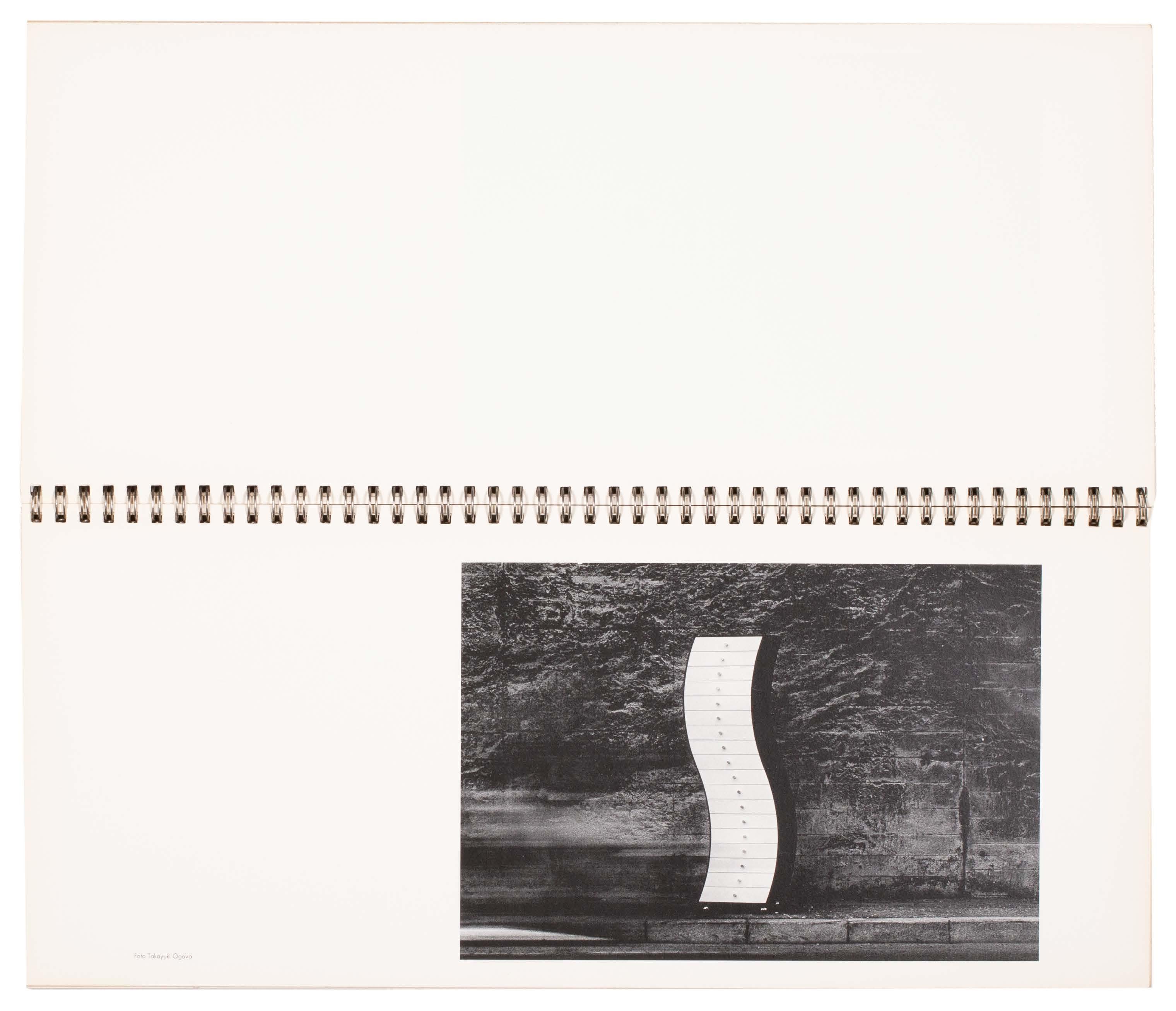
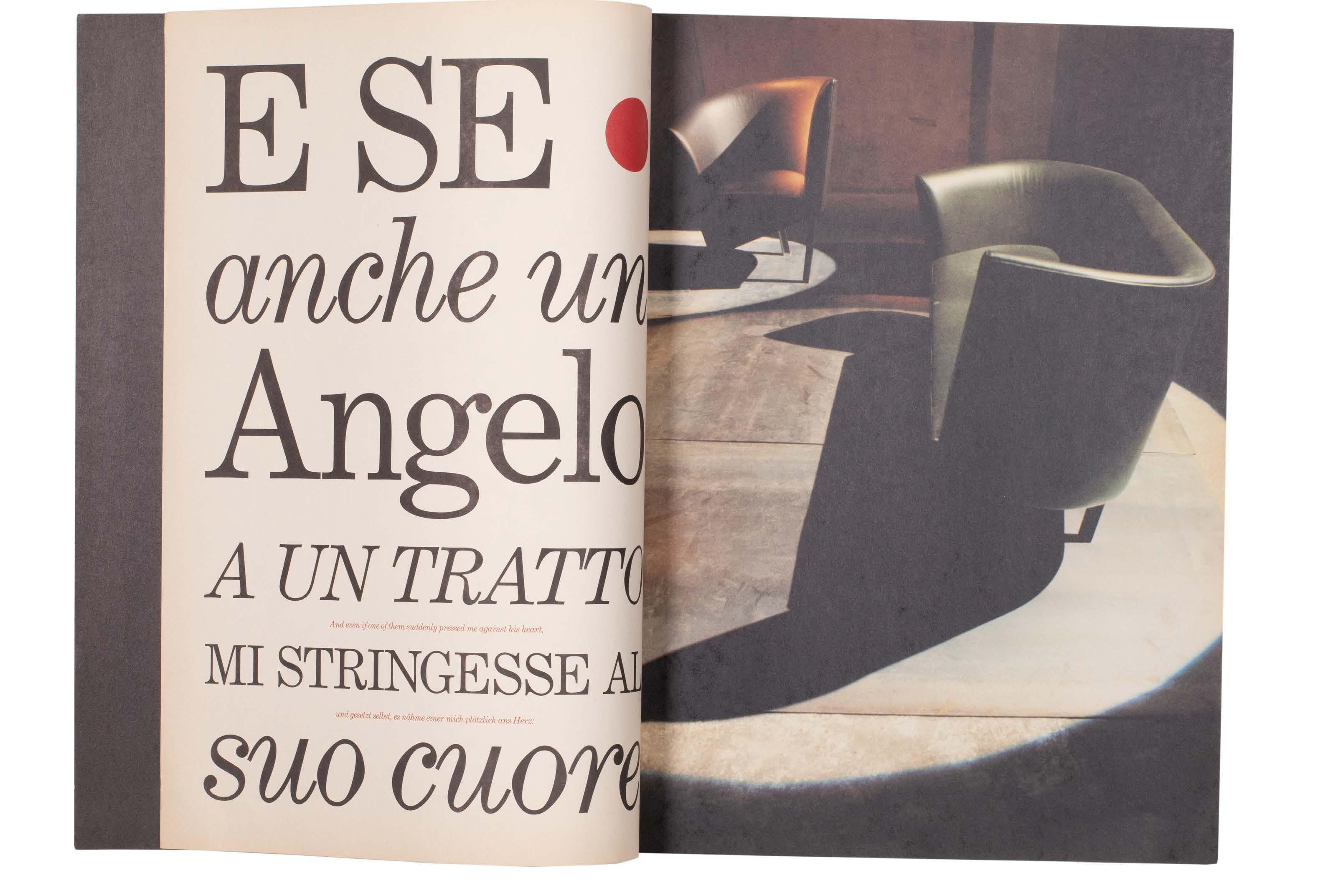


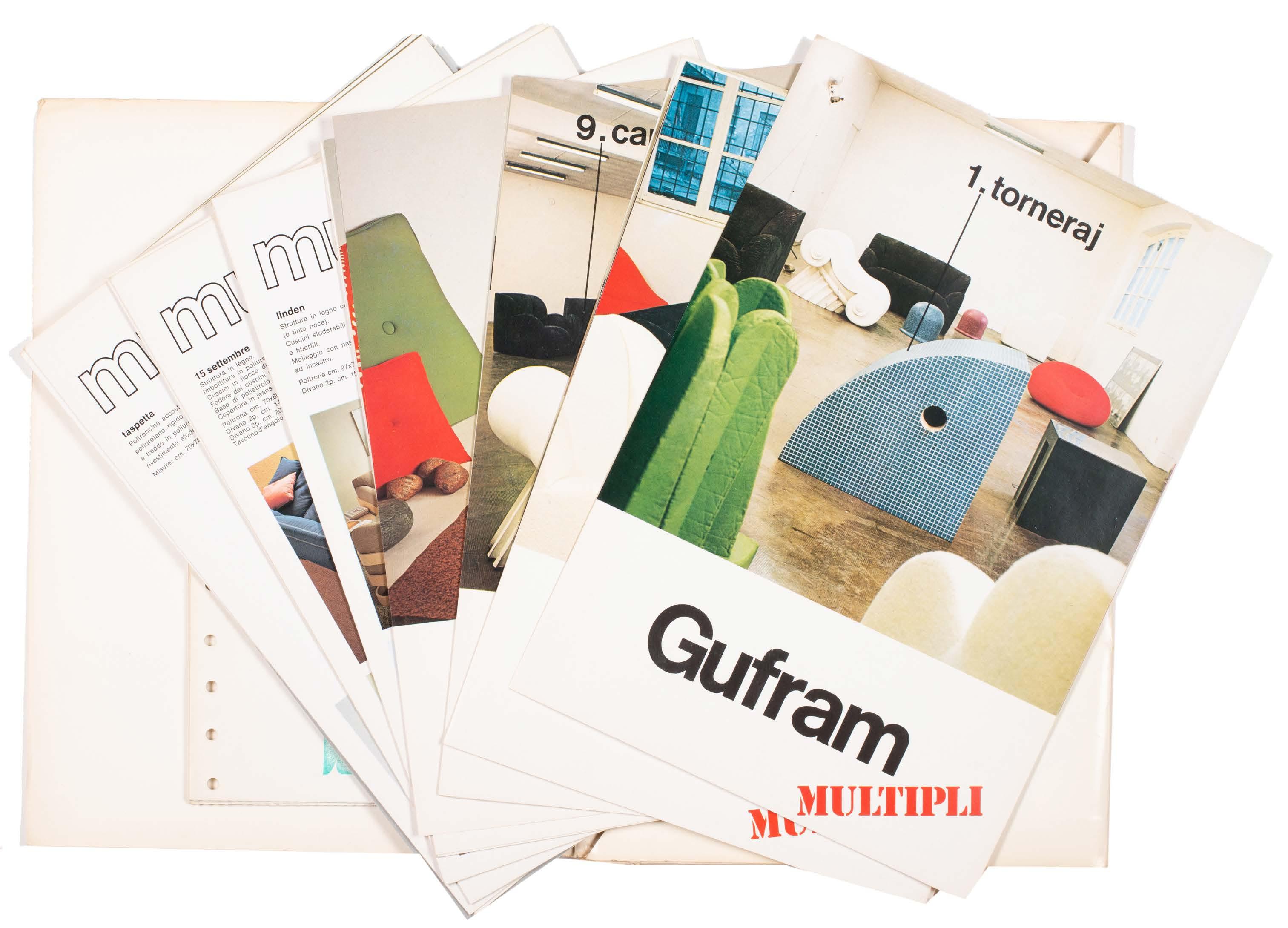
This page: no.67 Right hand page: no.78 (top), no.80 (bottom)
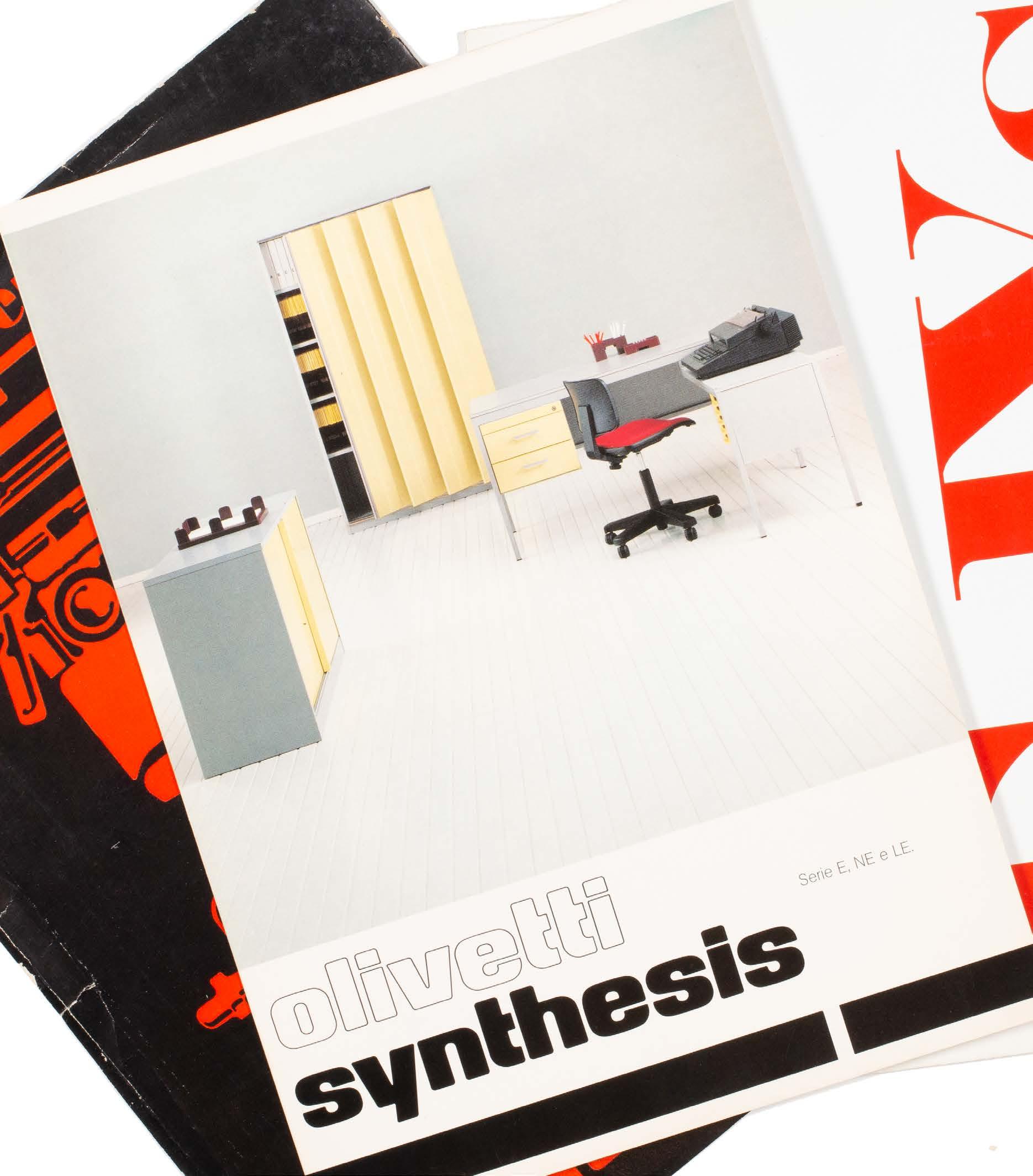
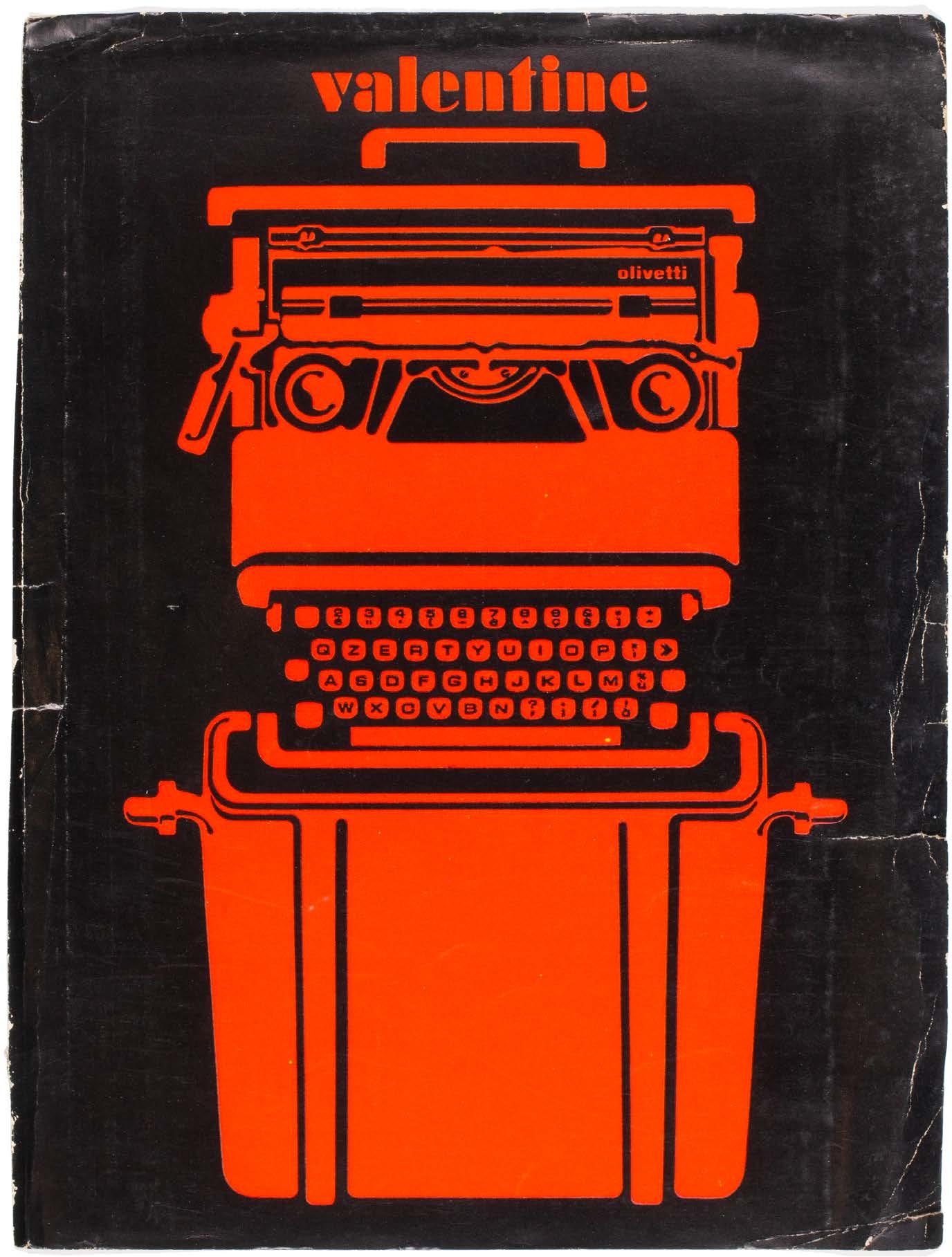

Gavina SpA Gufram
Dino Gavina • 1960

GAVINA S pA : (66). Dino Gavina. 1955–1975. Il potere agli oggetti. Edizioni Centro Duchamp. (1970s). Folio. Illustrated in black & white with decorative green frames. Stapled wrappers. pp.32 plus insert. • Project by the graphic designer Michele Provinciali who did a number of projects with Gavina, including publications and exhibition identities. With the insert on different coloured paper presenting the text in English.

GUFRAM: (67). multiGufram. (Product folder). Turin. Gufram. 1960s. 4to. Illustrated in colour. White folder. • Approx. 20 documents loose in the original ‘multi-Gufram’ folder. Includes product sheets and leporello publications for ‘torneraj’. Designs include chairs, sofas (incl. the iconic ‘Bocca’), beds and the ‘cactus’ – all of which challenged the seriousness of modernist rationalism with irreverent, pop-inspired furniture.
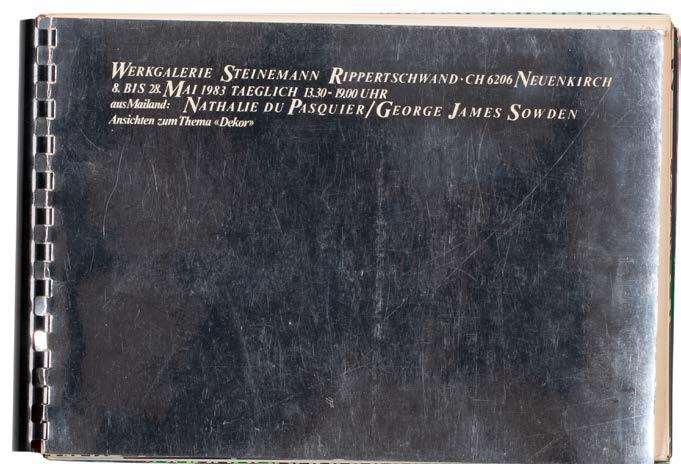
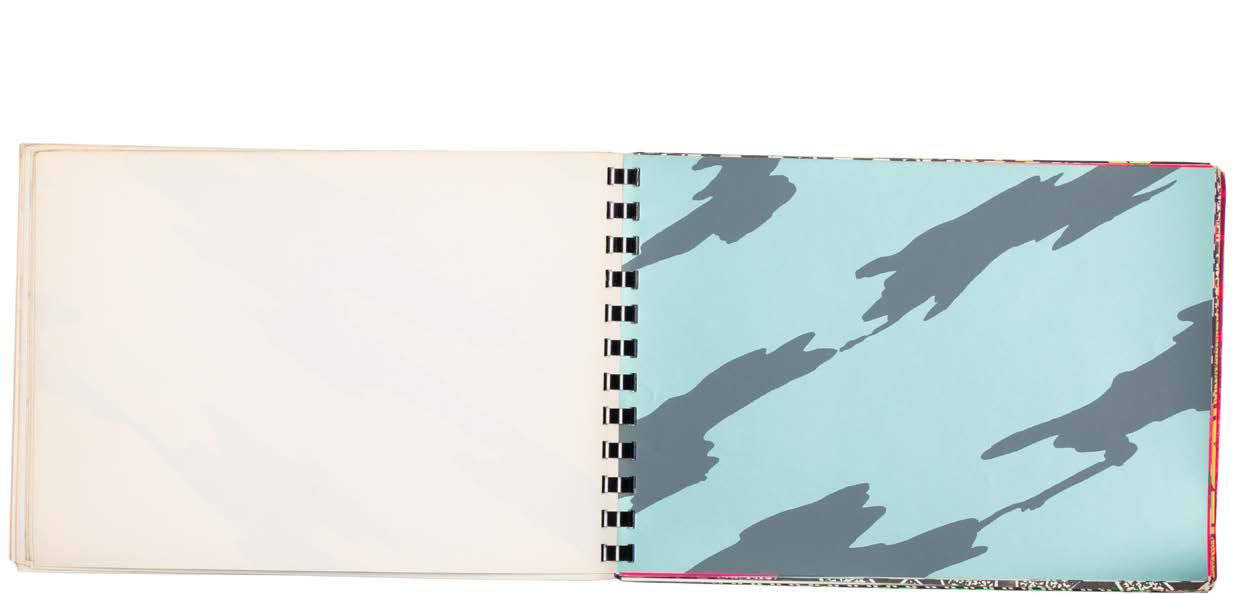
(71). Natalie du Pasqiuer and George James Sowden with Jan Burney and Barbara Radice. Ansichten zum Thema ‘Dekor’. Nathalie du Pasquier / George James Sowden. Rippertschwand. Werkgalerie Steinemann. 1983. Oblong 4to. Illustrated in colour and black & white. Silver ring-bound wrappers. pp.18; 100 leaves. • Catalogue of strong coloured patterns on paper by George James Sowden and Natalie du Pasquier, exhibited at Werkgalerie
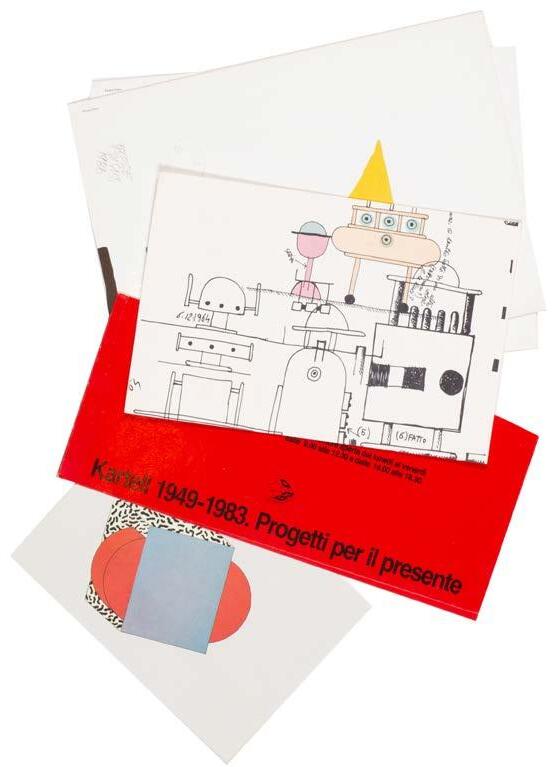
(75). Ettore Sottsass. (15 invitation cards and ephemeral pieces). Various. (1980s–1990s). Various formats and sizes. • 13 items, with some duplicates. Included is a press folder including a large exhibition poster from IKON, Galerie für Design-Zeichnungen (Frankfurt am Main) to ‘Ettore Sottsass: Drawings over 4 decades’, with monochrome photograph (see image no. 75a); the invitation to the exhibition ‘Ettore Sottsass & Marco Zanini
Gugliermetto Fratelli Mobile • 1960
Ceretti / Derossi
Riccardo Rosso
Giorgio De Ferrari
Roberto Lazzeroni

MARCATRÉ : (68). (Product folder). Marcatré. Milan. 1970s–1980s. 4to. Loose in Marcatré folder. • 16 documents advertising Marcatré products, including a ‘Catalogo dei Componeti’, ‘Listio dei Componeti’ (Il Pianeta Ufficio, Sistema di Arredamento per Uffici), a price list (‘I Sedili per Ufficio di Archizoom Associati’, 1977) and an invitation (to ‘Quartiere Fiera Milano’, September 1983). Marcatré was a highly influential and experimental collective.

Steinemann (titled ‘Ansichten zum Thema ‘Dekor’” (Views on the Theme of ‘Decor’), in May 1983. From the edition limited to c.50 copies. Sowden and Pasquier were founding members of Memphis. Contains black & white images of the exhibition alongside many leaves of their designs (88 in total). These patterns became iconic pieces of postmodern design. Also included is an introductory text by Jan Burney and Barbara Radice. Images: pp.20–23.
(72). Columbia 1985. Modello Depositato. Milan. Sottsass Associati. 1985. 4to. Black plastic moulded boards. • Diary from Sottsass Associati. This copy with previous owner’s annotations and pasted clippings. Complete with graph paper and pen to the front. With the original ‘Columbia’ packing box. Sottsass designs for Columbia include the ‘Dual Power Calulator’ manufactured by Nava Milano.
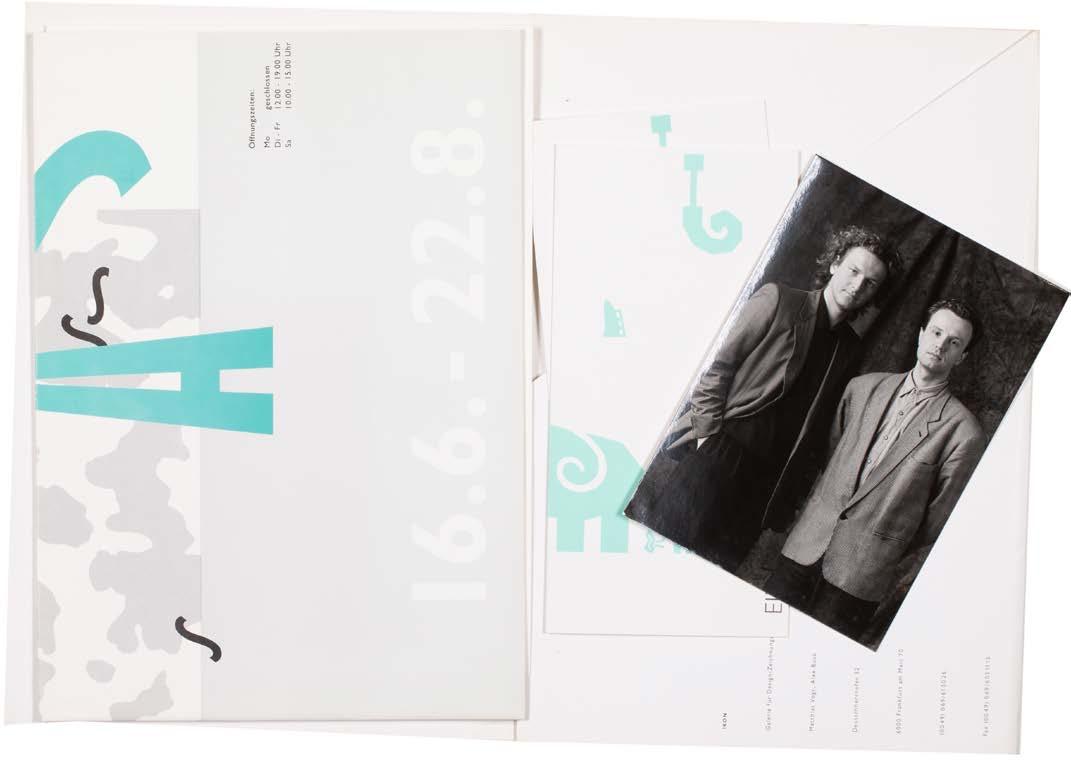
dernières créations de verre pour Memphis’ (Galerie Yves Gastou, 1987); a Poltronova card (stamped and mailed) which advertised the exhibition ‘Sibilla di Ettore Sottsass Jr.’ (1994); ‘La Casa Europea’ folded flyer with insert, advertising Ettore Sottsass ‘Vivere la Casa Europea’, (1990); postcard invitation to ‘Ettore Sottsass / Italy: The New Domestic Landscape’ at Galerie Ulrich Fiedler (1998); an invitation to an exhibition of Kartell products (including
Marcatré Memphis
Rodrigo Rodriquez • 1970s
Archizoom Associati
Mario Bellini
Achille Castiglioni
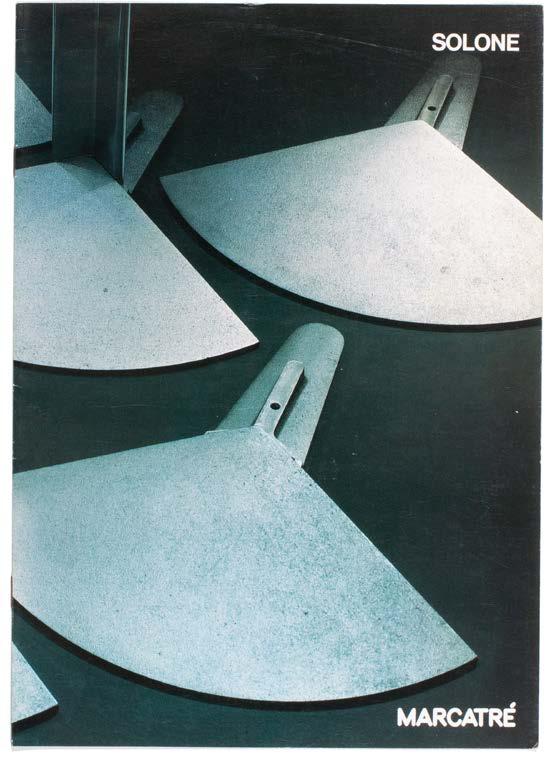
(69). Castiglioni, Achille. Solone di Achille Castiglioni. (Product sheet). Marcatré. Milan. 1982. 4to. Illustrated in colour. • ‘Solone’ (1982) is a modular office furniture system conceived by Achille Castiglioni for Marcatré. These designs were intended to foster an emotional and social environment for individuals working in open office contexts—spaces that encouraged interaction and collective engagement rather than isolation.
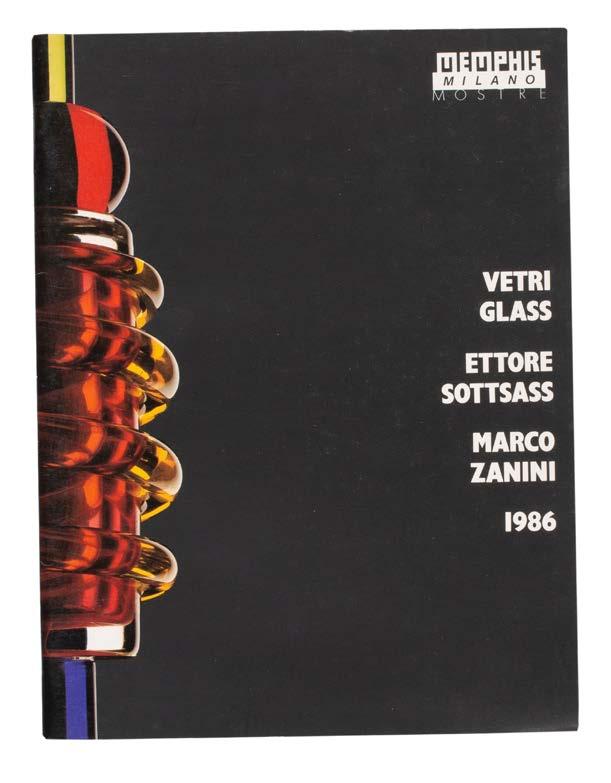
(73). Memphis Milano. Vetri. Ettore Sottsass. Marco Zanini. Milan. Memphis. 1986. 4to. Illustrated in colour. Stapled wrappers. pp.28. • Richly illustrated catalogue of 34 glass works by Sottsass and Zanini. “Don’t be surprised then if some of the glass is glued together to allow a little more speed rather than melted together according to custom. And what difference does it make? Isn’t glue-culture an invention exactly like the culture of glass?” (Intro., Ettore Sottsass).
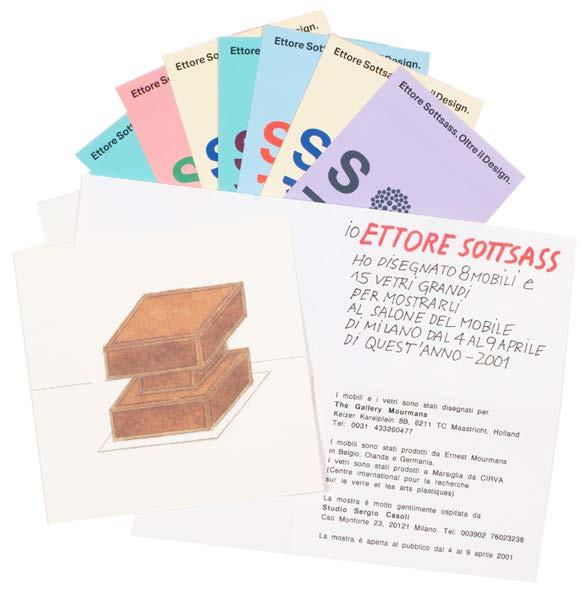
Ettore Sottsass 1980
Matteo Thun
Michele De Lucchi
Nathalie du Pasquier
George James Sowden
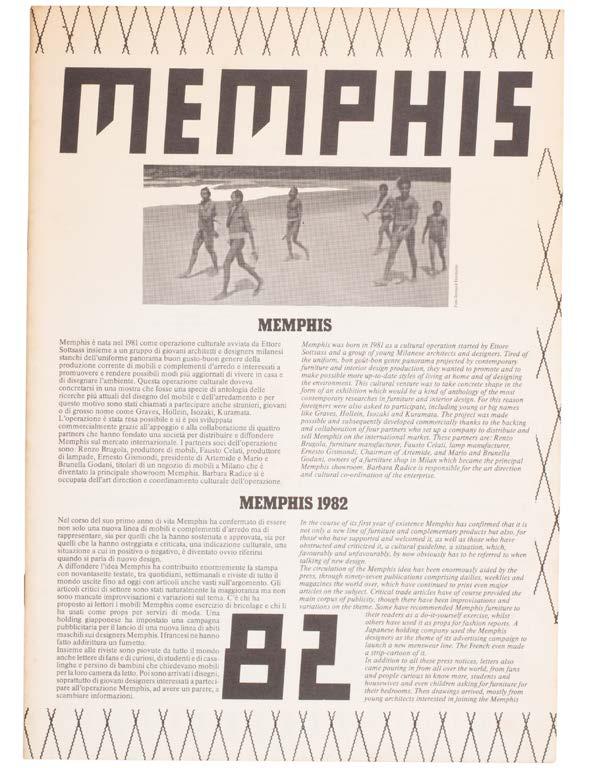
MEMPHIS: (70). Memphis 1982. (Sottsass Associati). 1982. 4to. Illustrated in black and white. Stapled wrappers. pp.12. • Memphis overview from Sottsass Associati, with interviews and texts by Emilio Ambrasz, Andrea Branzi, Daniela Morera, Karl Largerfeld and others. Sottsass Associati was founded by Sottsass in 1981 to allow for more structured commercial and architectural work while Memphis remained more experimental.
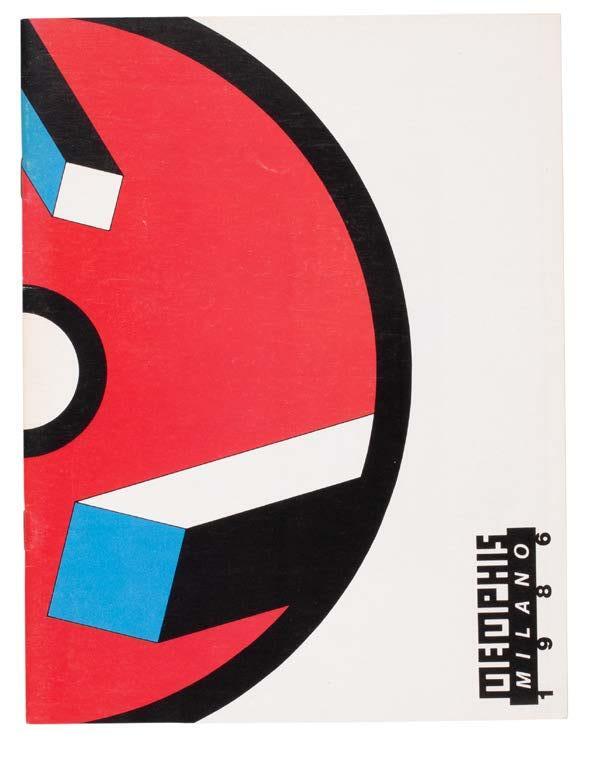
(74). Memphis Milano 1986. Milan. Memphis. 1986. 4to. Illustrated in colour. Stapled wrappers. pp.16. • The original stores and stockists catalogue from 1986, designed by Christopher Radl and Maria Marta Rey Rosa for Sottsass Associati. Designers include George James Sowden, Nathalie Du Pasquier, Peter Shire, Marco Zanini, Aldo Cibic, Cesare Ongaro, Michele De Lucchi and Martine Bedin.
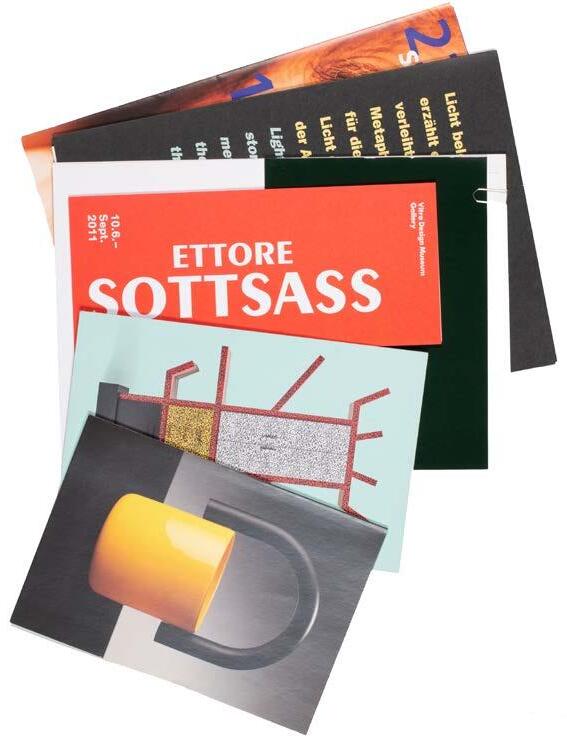
designs by Aulenti and Sottsass), 1984; Fontana Arte catalogue showcasing designs by Aulenti and Sottsass, and others; an issue of ‘Domus’ magazine, (settembre, 1981) and the card slipcase for the Sottsass t-shirt ‘Pane rosa, 1981’ (t-shirt not present).
(76). Ettore Sottsass. (25 invitation cards and ephemeral pieces). Various. 2000–22. Various formats and sizes. • 25 items, including some duplicates. Included is the invitation to the 2002 Vitra Design Museum Berlin exhibition ‘Cartier Design Рeine Inszenierung von Ettore Sottsass’; the exhibition guide to Vitra Design Museum Gallery’s ‘Ettore Sottsass enamels’ exhibition (2011); 10 postcards from ‘Ettore Sottsass. Oltre il Design.’ (2017–18) at Abbazia
di Valserena; the Centre Pompidou exhibition guide to ‘Ettore Sottsass, l’objet magique’ (2022); the folded paper invitation to Ettore Sottsass at the Salone del Mobile; and a MUDAC (Museum of Contemporary Design and Applied Arts, Lausanne, Switzerland) card for the 2011–12 exhibition ‘Ettore Sottsass et Pierre Charpin En Verre et Contre Tout’. Pierre Charpin worked for a time at Sottsass Associati, during the 1990s.
Mirabili Olivetti Oluce Pallucco Poggi Carlo
Sergio Camilli • 1986
Ettore Sottsass
Adolfo Natalini
Alessandro Mendini
Paolo Portoghese
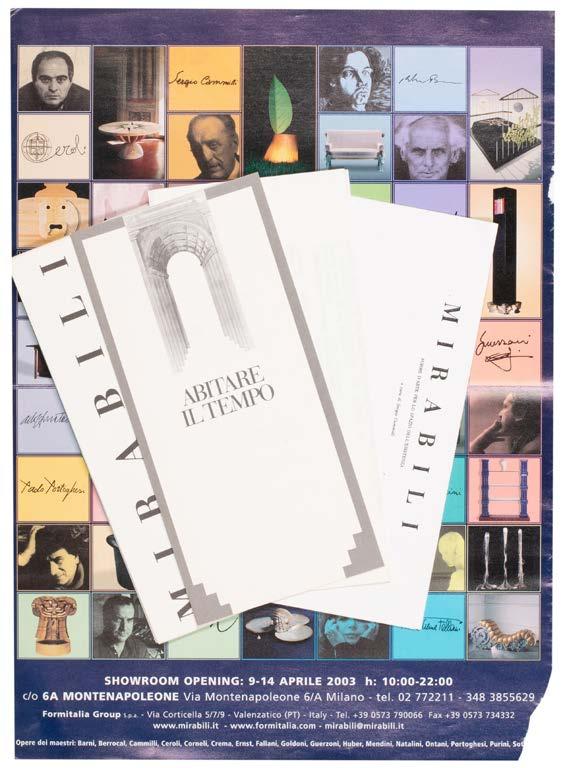
MIRABILI. ( Poltronova): (77). Camilli, Sergio. Mirabili. (4 invitations and ephemeral pieces). Mirabili. 1988–2003. Various formats and sizes.
• Includes an invitation to the exhibition ‘Abitare il Tempo’ (Verona, 1988); ‘Mirabili. Forme d’Arte per lo Spazio dell’Esistenza’, a Collection Mirabili leaflet advertising designs by Bartolini, Sottsass, Natalini, Mendini and others (curated by Sergio Camilli); a cutout magazine page announcing the
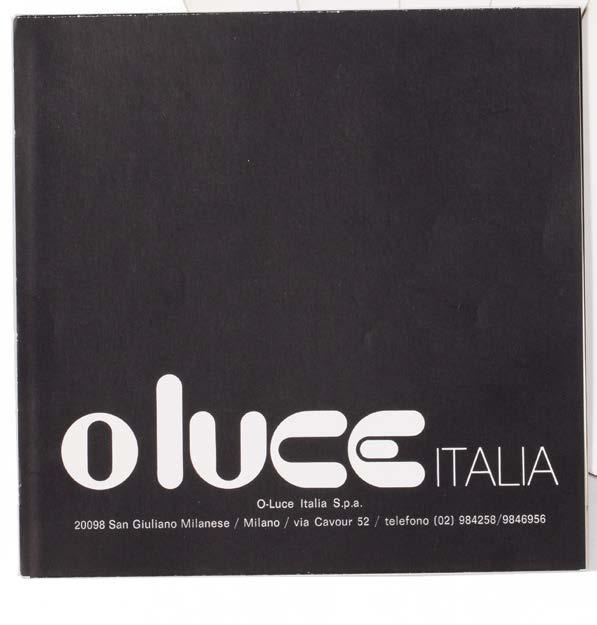
OLUCE: (82). (Five sales leaflets). Milan. Oluce. (c.1960s–1970s). Leporello. Square 4to. Illustrated in colour and black & white. • The leaflets showcase: ‘Serie Adim’ (Magistretti), ‘Serie Coup’ (Colombo), ‘Serie Atollo’ (Magistretti), ‘Serie Linz’ (Magistretti), ‘Serie Spider’ (Colombo) and ‘Serie Snow’ (Magistretti). Joe Colombo’s works are among the most iconic designs associated with Oluce. His ‘Spider’ won the Compasso d’Oro in 1965.
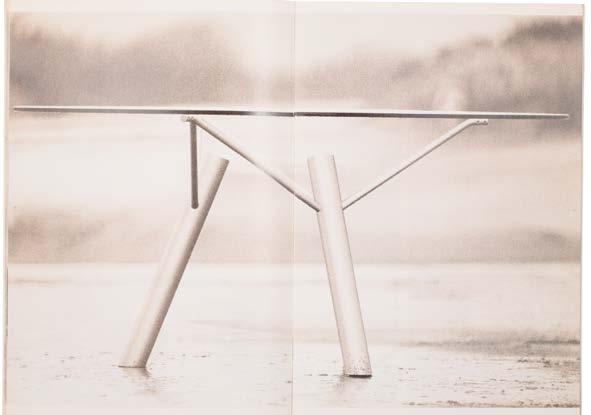
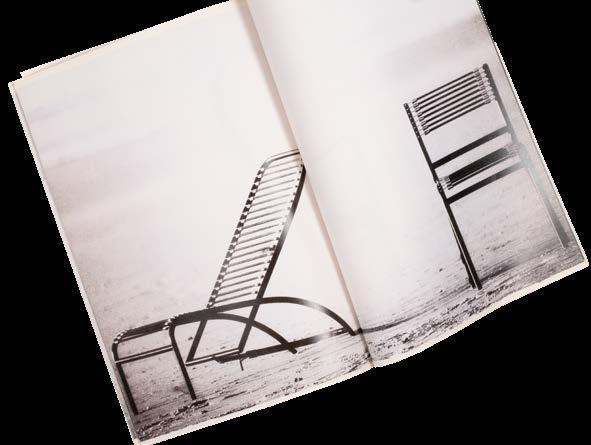
(88). (Two catalogues). Rome. Pallucco. 1986; 1987. Folio. lllustrated in black & white. White wrappers with embossed titles. pp. 34; pp.48. • Radical furniture. Two Pallucco catalogues showcasing Peter Lindbergh’s photography of designs by Robert Mallet-Stevens, Shiro Kuramata, Rei Kawakubo, Laura di Lorenzo and others. The campaign was shot in Le Touquet in 1986 and 1987. The connection between design and fashion photography is keenly felt.
Camillo Olivetti • 1908
Ettore Sottsass
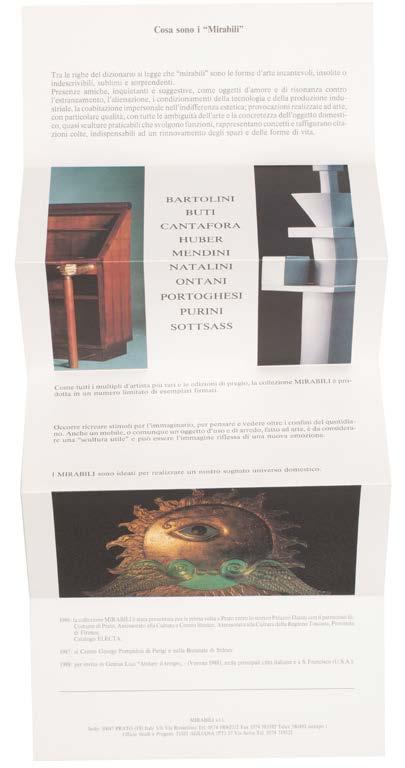
showroom opening of ‘Mirabili, Arte d’Abitare’. ‘Tra le righe dizionario si legge che “mirabili” sono le forme d’arte incantevoli, insolite o indescrivibili, sublimi e sorprendenti. Presenze amiche, inquietanti e suggestive, come effetti d’amore e di risonanza contro l’estraneamento, l’alienazione, i condizionamenti della tecnologia e della produzione industriale, la coabitazione impersonale nell’indifferenza estetica’... (From the flyer).
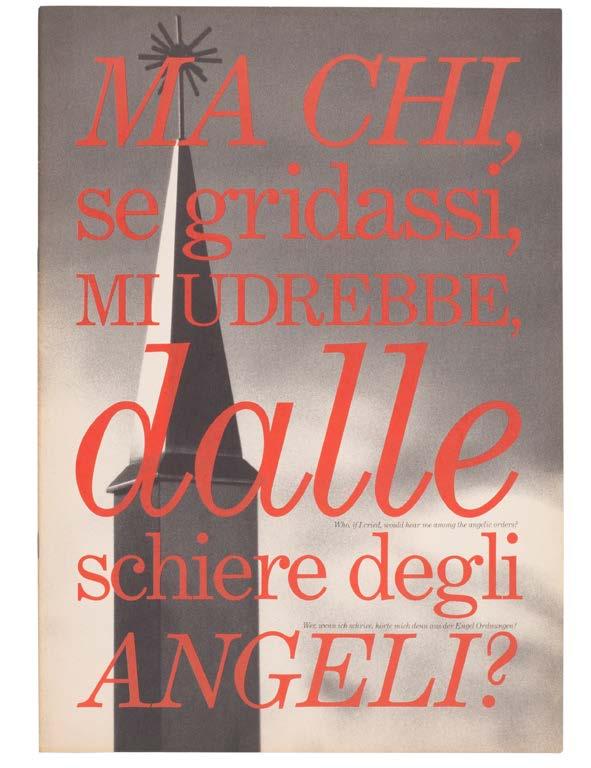
PALLUCCO: (83). Pallucco. (Ma chi, se gridassi, ni uderebbe dalle schiere degli angeli?). Rome. Pallucco. 1988. Folio. Illustrated in colour. Stapled wrappers. pp.16. • Promotional Pallucco magazine, with poetry by Rainer Maria Rilke. (84). Pallucco, Mattatoio. (Milan, September 1989). Treviso. Pallucco. 1989. 4to. With 4 colour slides. Portfolio with embossed titles. pp.6. • Press folder with colour slides for the

Giuseppe Ostuni • 1945
Joe Colombo
Vico Magistretti
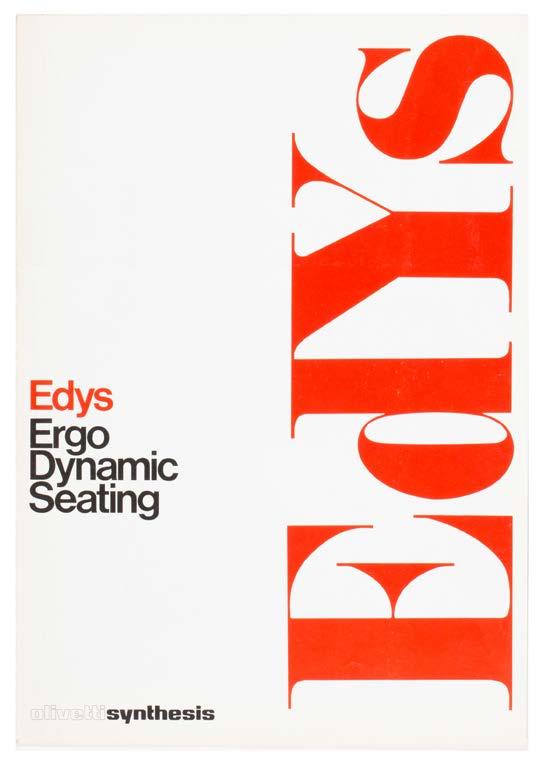
OLIVETTI: (78). Sottsass, Ettore. Serie E, NE e LE. / Edys Ergo Dynamic Seating / (Cedit). (Three brochures). Olivetti & Cedit. (1970s–1980s). Various formats and sizes. • The ‘Edys Ergo Dynamic Seating’ brochure unfolds to a large poster.
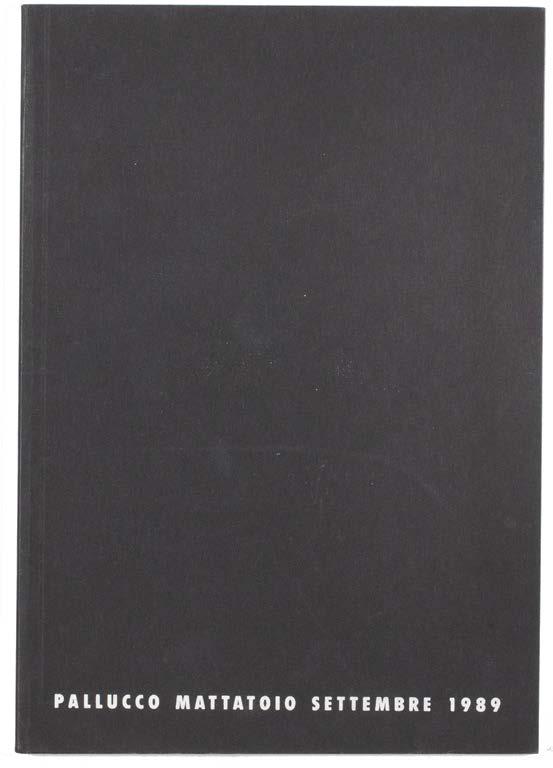
‘Lilly of the Wind’, ‘Hero’s Muscles’, ‘L’Angelo Necessario’ and ‘Forte Ponte’ (all designs by Paolo Pallucco and Mireille Rivier). Not pictured. With: (85) Pallucco, Paolo. Pallucco Mattatoio Settembre 1989. Pallucco. 1989. 4to. Illustrated in black & white. Wrappers. • 1989/90s collections book, beautifully produced with black & white photographs by Carlo Lavatori and scenography by Peter Pabst. ‘Pallucco Slaughterhouse 1989’ was innovative
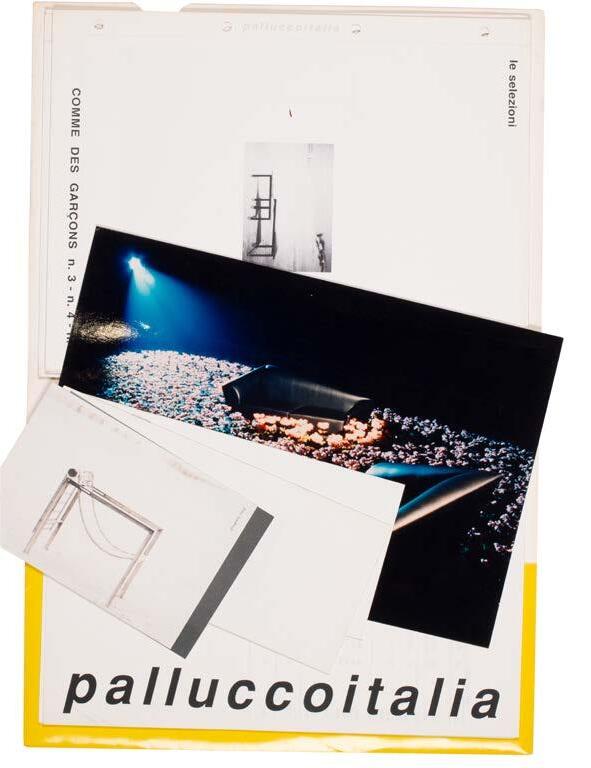
Paolo Pallucco • 1980
Shiro Kuramata
Rei Kawakubo
Robert Mallet-Stevens
Mireille Rivier
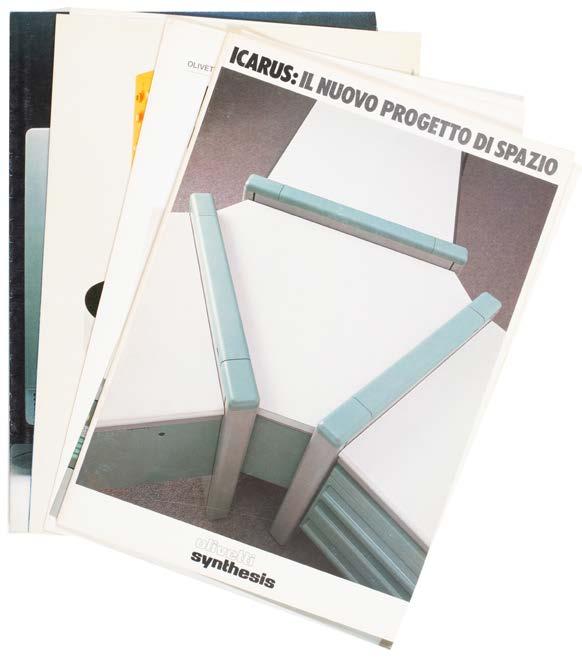
OLIVETTI SYNTHESIS : (79). (5 sales brochures). Ivrea. Olivetti. Undated. • Brochures include: ‘Icarus. Il Nuovo Progetti di Spazio’, ‘Arp /Synthesis’ (personal computer), ‘Olivetti Divisumma 18’ (elettronica portatile scrivente’), ‘Olivetti Copia 7035’ and ‘Arredamenti metallici serie Synthesis 45.’
(80). Orgatec. (Cologne 1990 Press Folder). Ivrea. Olivetti. 1990. 4to. Illustrated in colour and black & white.

in its transformation of an abandoned slaughterhouse in which to display Pallucco’s furniture designs outside the main Milan fair (Fuori Salone).
(86). (Two press folders). Rome. Pallucco. (1980s). 4to. Loose in folders.
• Information packets for the ‘Lizie’ chair (designed by Regis Protiere) and the ‘Extensible Library’ by Fra’Dolcino. Also included is a sheet with a company profile and product leaflet.
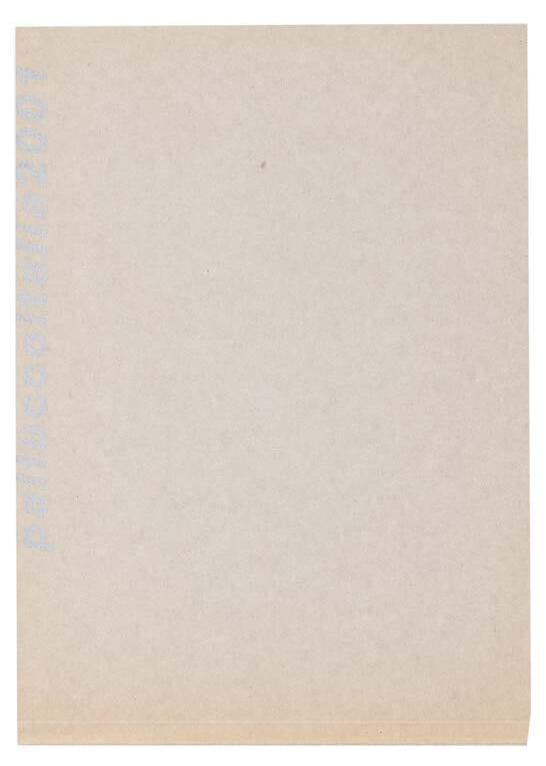
Carlo (family) • (1940s)
Franco Albini
Franca Helg
Ugo La Pietra
Vico Magistretti
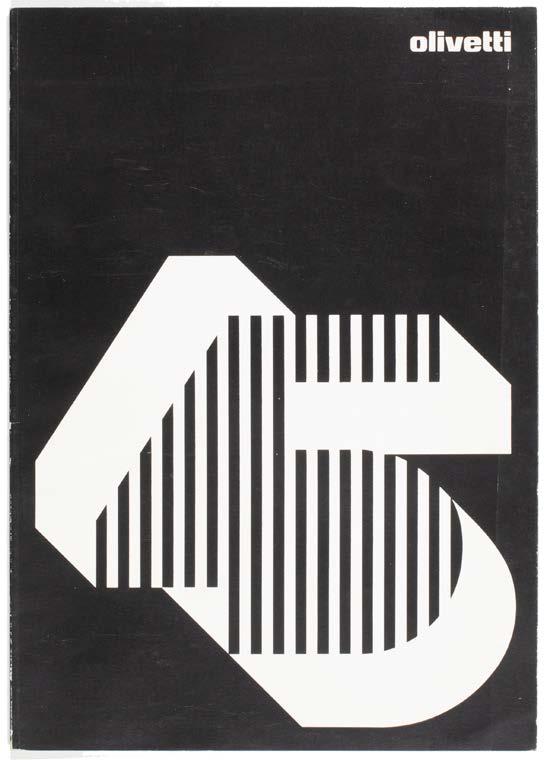
• A4 stapled sheets, sheet displaying ‘Schriftmuster Typenräder’ and sales brochures including ‘Schreiben im Buro mit Olivetti’, ‘Datenichtesystem Olivetti TCV 280’, and the ‘ATS TTW’ model. Text in German. Image: p.17. (81). Olivetti Synthesis 45. Ivrea. Olivetti. 4to. Illustrated in colour. pp.24. • Olivetti’s office furniture systems.
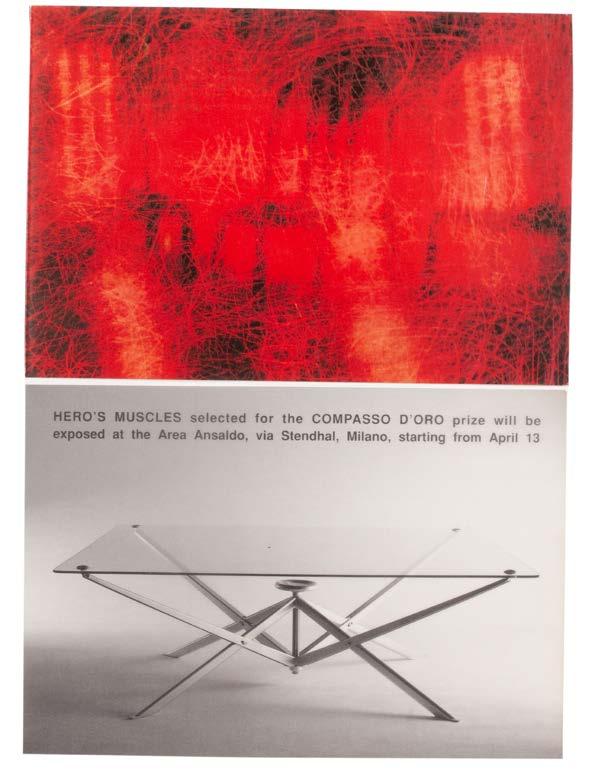
(87). (Invitation card). Treviso Pallucco. 1980s / 1890s. Folded card, (220 × 150 mm). lllustrated in colour and black & white. • Invitation to the Salone Internazionale del Mobile. With insert regarding ‘Hero’s Muscles’, a striking coffee table designed in 1989 by Paolo Pallucco and Mireille Rivier with a distinctive steel base structure supporting a glass table top, both strong and graceful looking. It was selected for the Compasso d’Oro prize.
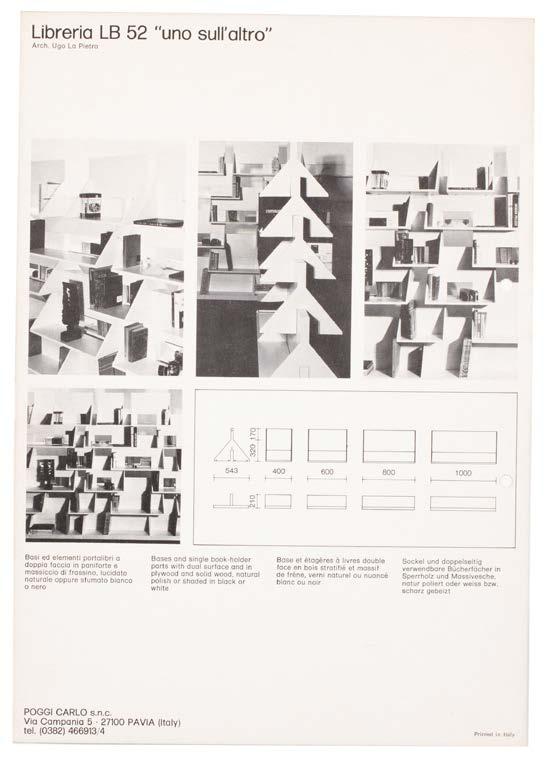
(89). Robert Mallet-Stevens, Rei Kawakubo, Comme des Garcons et al. Pallucco ‘90. Treviso. Pallucco. (1990s). Square 4to. Illustrated in black & white. Black wrappers with blind embossed titles. pp.92 • In the early 1980s, Pallucco encountered the radical work of Rei Kawakubo, founder of Comme des Garçons. Captivated by her avantgarde aesthetic, he began producing all the furniture she designed for her brand’s boutiques.
(90). (Press folder). (1990s). Various formats and sizes. Yellow folder. • Contains Pallucco postcards, one original colour photograph, product sheets, price lists and various other promotional Pallucco material. Comme des Garçons material also included (one sheet is titled ‘le selezioni n.3n.4 - n.5.’). These creations show Rei Kawakubo’s signature aesthetic: austere forms that are minimalist, sculptural and industrial.
(91). Pallucco, Paolo. Pallucco Italia 2001. Treviso. Pallucco. 2001. Oblong 8vo. Illustrated in colour. Card wrappers with titles in silver to edge. pp.120. • 2001 catalogue from Pallucco, showcasing floor lamps, chairs, sofas, storage cabinets, etc.
POGGI CARLO: (92). Libreria LB 52 ‘uno sull’altro’.
(Product sheet). Poggi Carlo. 1970s. 4to. Illustrated in black & white. • Single product sheet showcasing a design by Ugo La Pietra for ‘bases and single bookholder parts with dual surface and in plywood and solid wood, natural polish or shaded in black and white.’ Poggi Carlo collaborated with designers such as Franco Albini, Franca Helg, Vico Magistretti and Afra and Tobia Scarpa.
About the Exhibition: Views on the Theme of “Decor”
We made the first preparations for this exhibition almost two years ago. We intended to bring some of the spirit of optimism of the ‘Milanese designers’ to Rippertschwand in Neuenkirch and thus convey to our Swiss colleagues and our visitors some of the joy these people enjoy designing.
The design of the 1980s experienced a turning point. Our exhibition will document this. The title already suggests it. ‘Decor’ is back. The two designer personalities from Milan, Nathalie du Pasquier and George James Sowden, present their views on the theme of decoration. The result is astonishing. Its origins cannot be denied. It is a sign of our times: youthful, fresh, and at times quite unusual. It is a sign of its creators, George James Sowden and Nathalie du Pasquier.
She was born on February 14, 1957, in Bordeaux. After traveling in Africa, Australia, and India from 1975 to 1977, she came to Italy. She first lived in Rome and then moved to Milan, where she began working as a textile designer. Her textile designs
were created by ‘Memphis’ and are part of the 1981 and 1982 collections. The strong, impressive design style is already evident in these works. No wonder her work was also part of a collection by Ungaro and other fashion royalty. She is currently working for Fiorucci.
George James Sowden was born in an industrial city in the north of England, in Leeds, on June 4, 1942. He studied architecture at the Gloucestershire College of Art from 1960 to 1964 and from 1966 to 1968. In 1970, he moved to Milan. Olivetti hired him as a consultant. Here, he worked with Ettore Sottsass. His field of work is computer design. He created some furniture for the ‘Memphis’ collections of 1981 and 1982. He also works for various industries. His work has been shown in various countries around the world. We are friends with Nathalie du Pasquier and George James Sowden. I met George James Sowden in Milan ten years ago. I am delighted to be able to present their work to you here.
English translation of the catalogue introduction by Tina Steinemann and Brigitte Steinemann Reis.

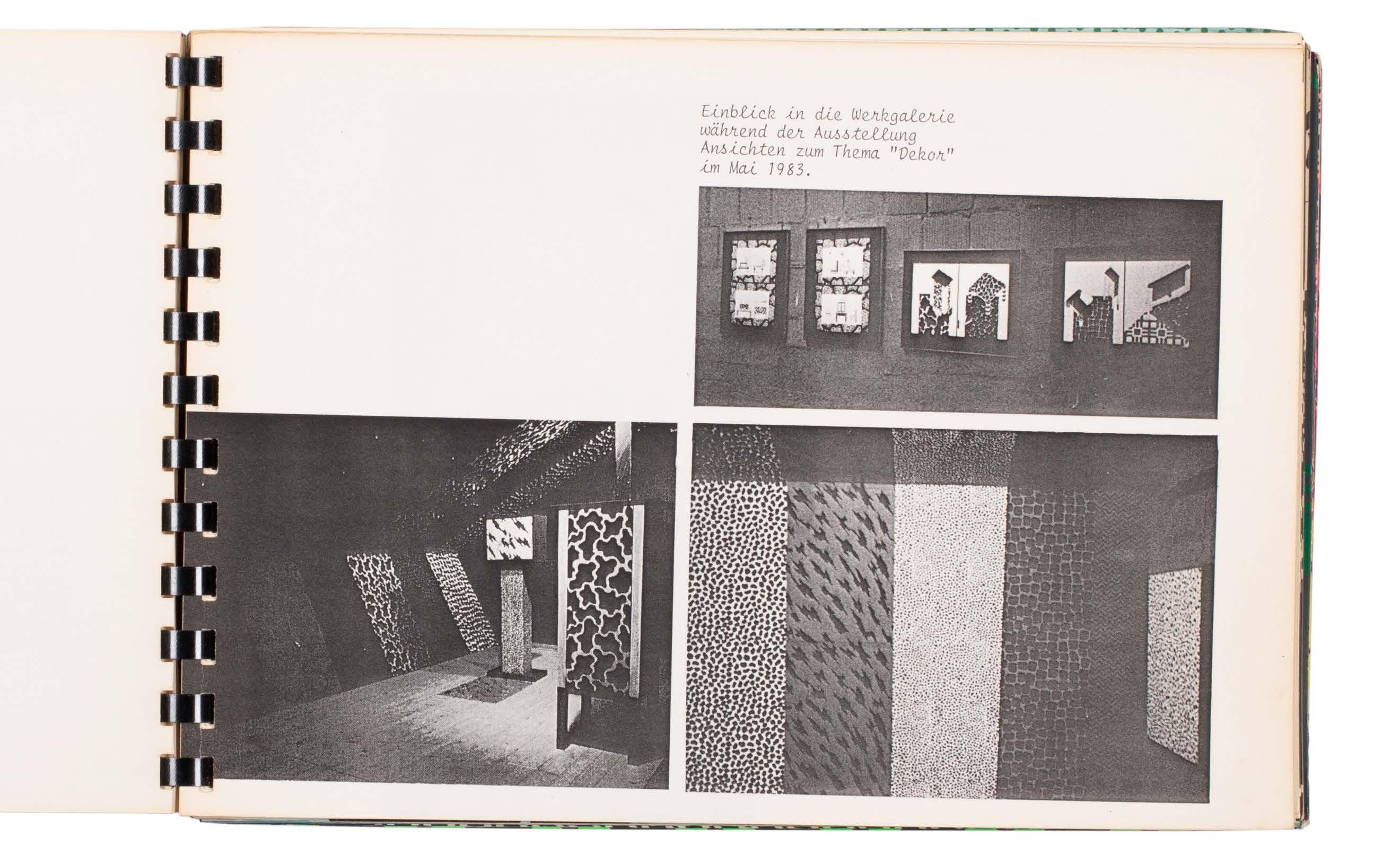
Right: Natalie du Pasquier in the Werkgalerie Steinemann with one of her prototypes (May 1983).
Below: Exhibition installation at Werkgalerie Steinemann (1983).
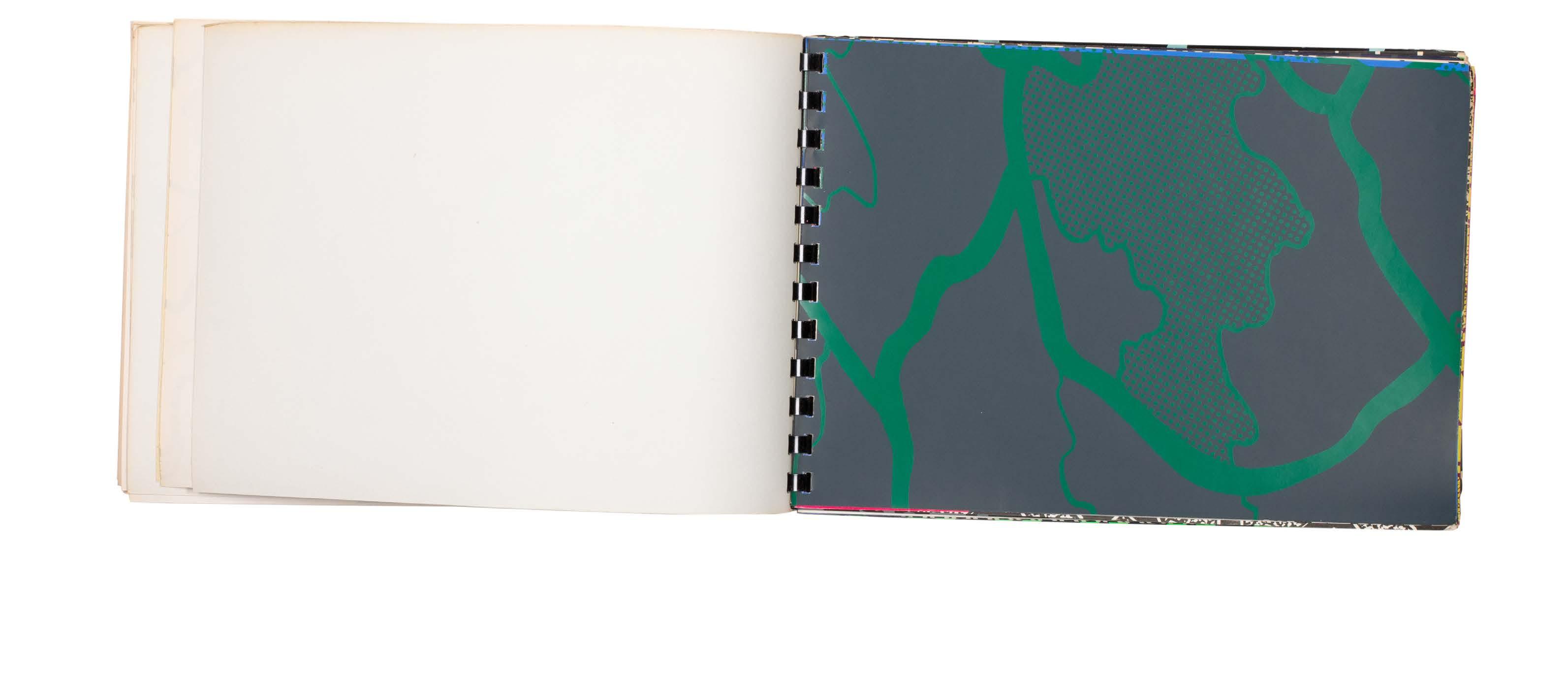
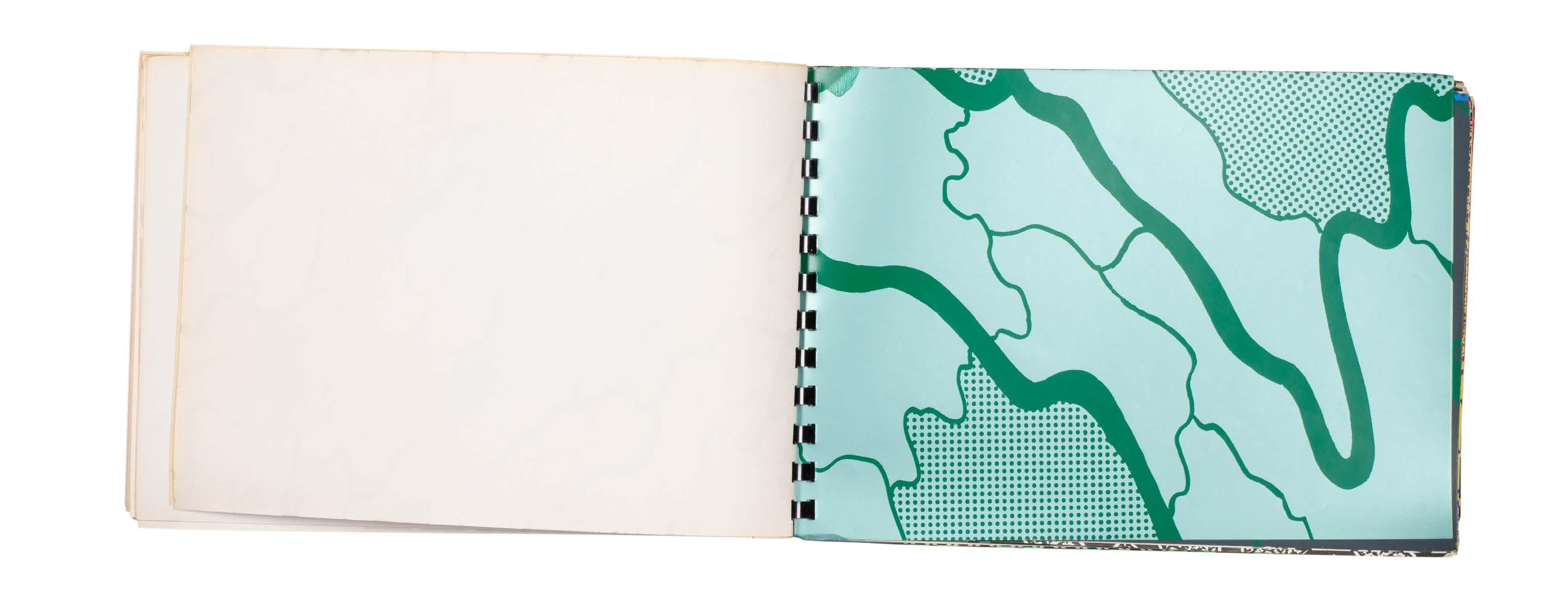
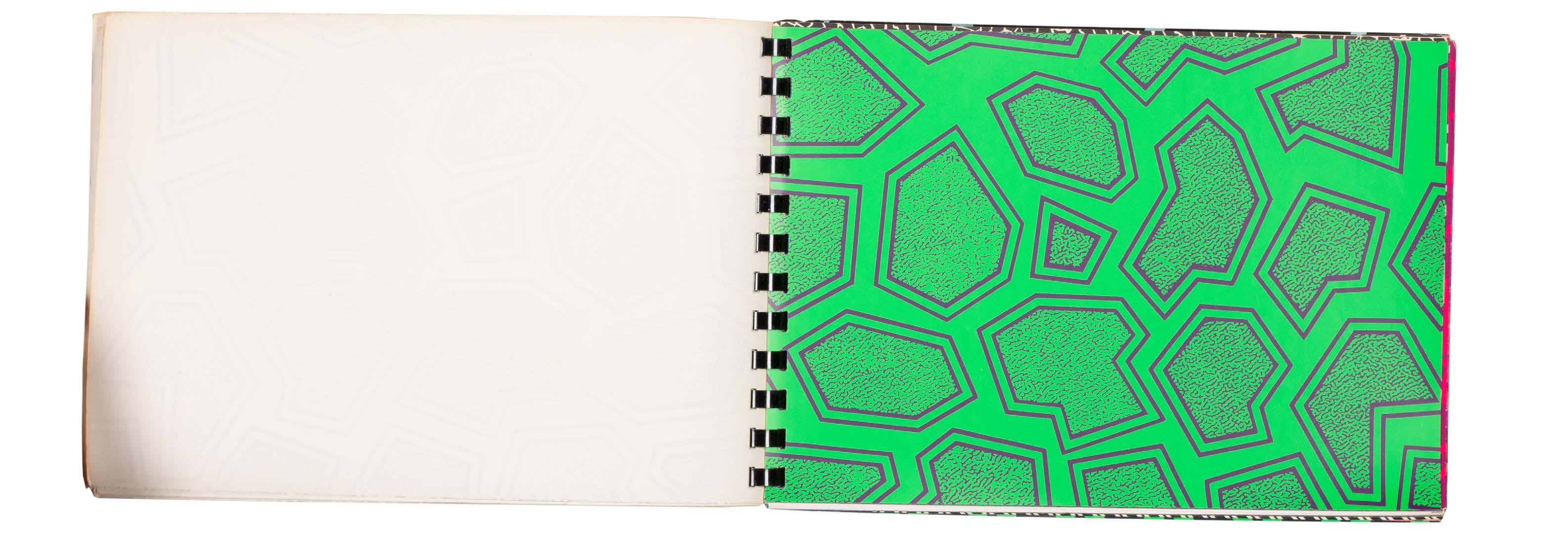

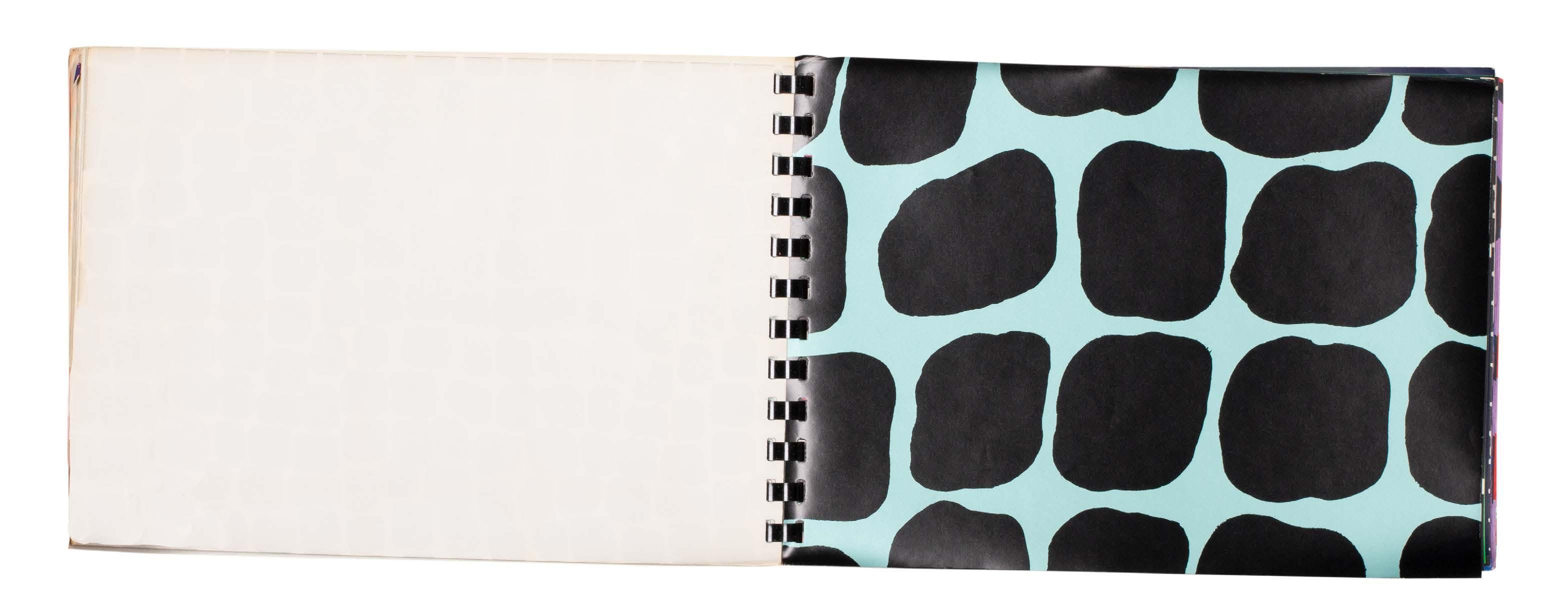

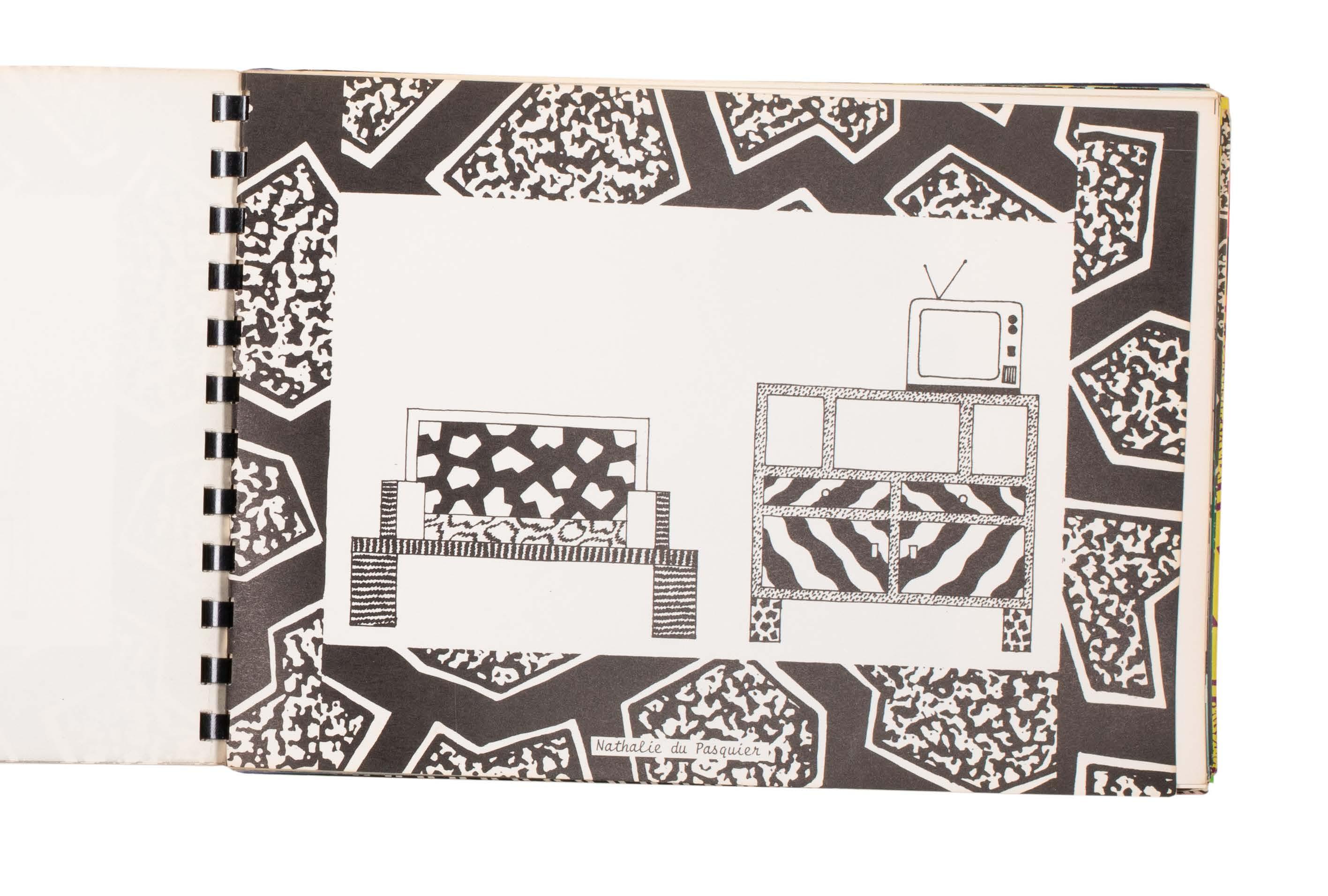
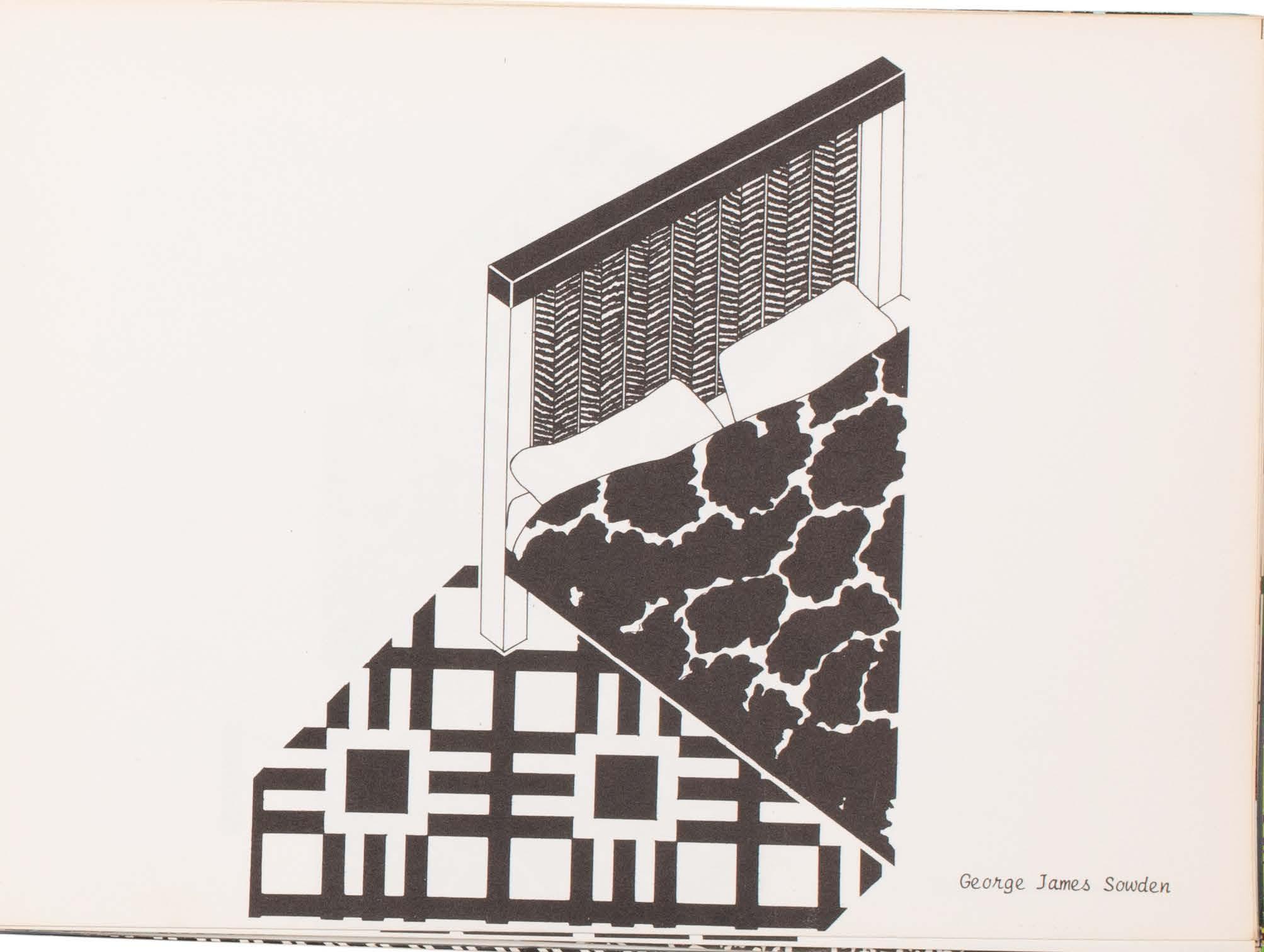
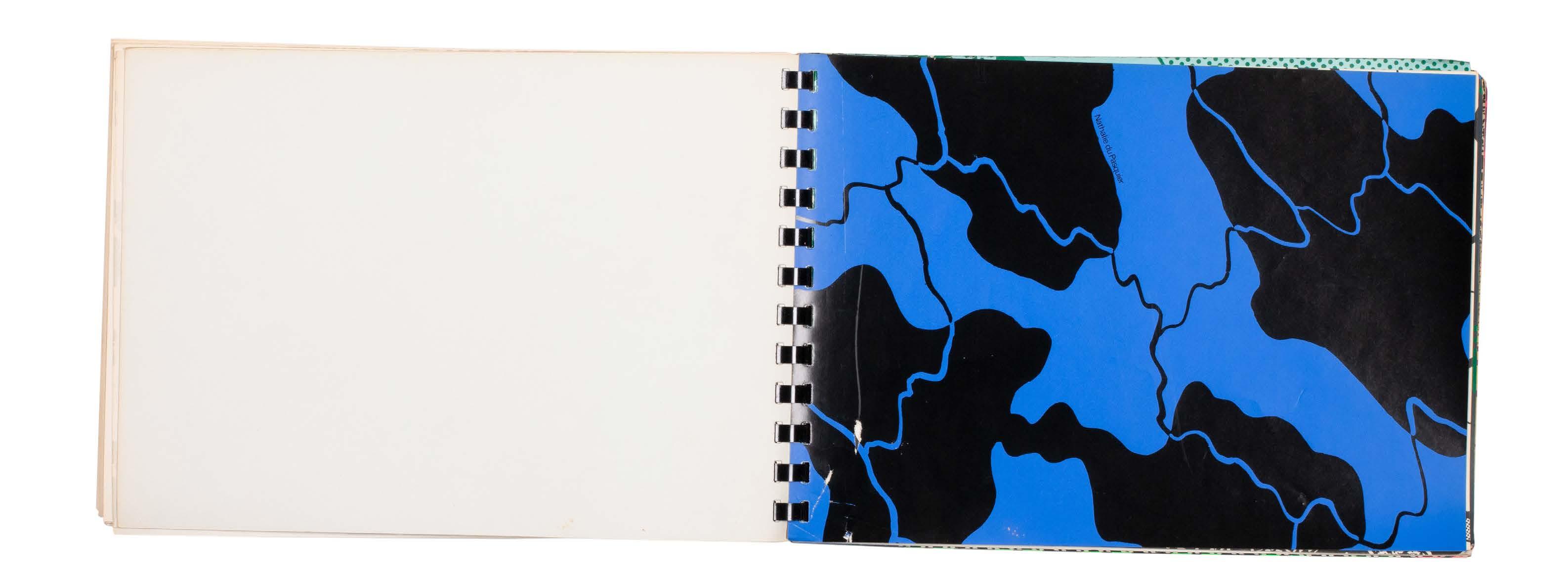

Poltronova
Sergio Camilli • 1957
Sergio Asti
Gae Aulenti
Mario Ceroli
Jonathan De Pas
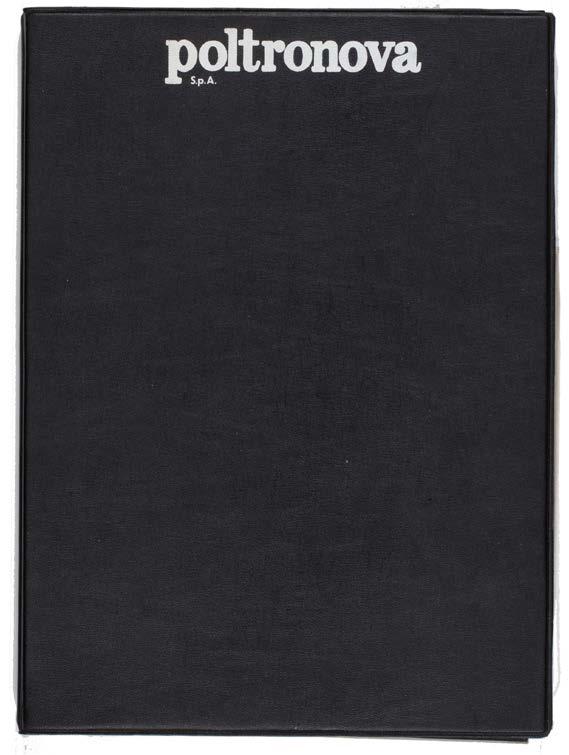
POLTRONOVA: (93). (Sottsass, Superstudio et al.) (Promotional material). (Agliana / Pistoia, Italy. Poltronova). 1972–75. 18 vols. 4to. Illustrated throughout in colour. Loose in black plastic Poltronova folder. • 20 loose Poltronova documents, comprising sales brochures from the following designers: Archizoom, Asti, Aulenti, Camilli, Ceroli, De Pas, D’Urbino, Lomazzi, Michelucci, Sottsass, Superstudio and Vignelli.
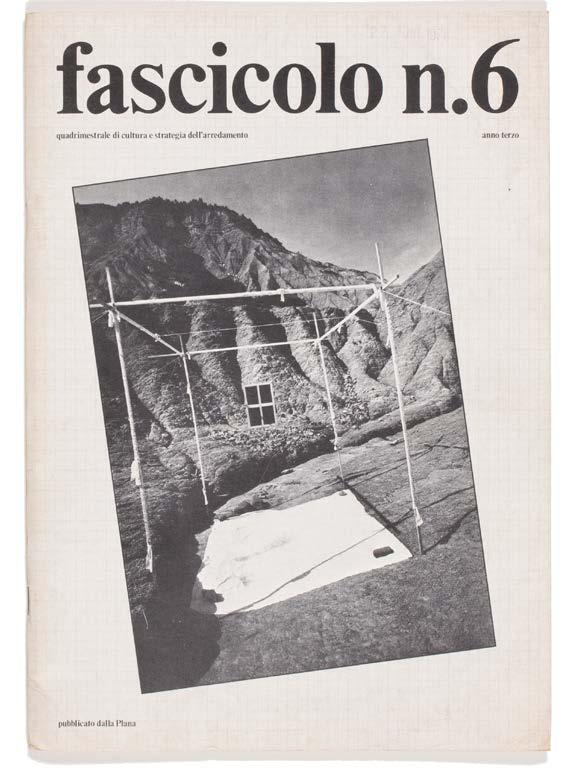
SOTTSASS (97). fascicolo n.6. quadrimestrale di cultura e strategia dell’arredamento. anno terzo. 1978. 4to. Illustrated in colour and black & white. Stapled wrappers. • Single issue of ‘fasciolo’, featuring essays and photography by Sottsass. ‘Pubblicato dalla Plana.’ A former issue of ‘fascicolo’ (anno secondo) featured the designer Ugo La Pietra. The series was edited by Sergio Costa.
Donato D’Urbino
Paolo Lomazzo
Giovanni Michelucci
Ettore Sottsass
Massimo Vignelli

Robots
Bruno Munari 1970s
Guido de Marco
Bruno Munari
Piero Polato
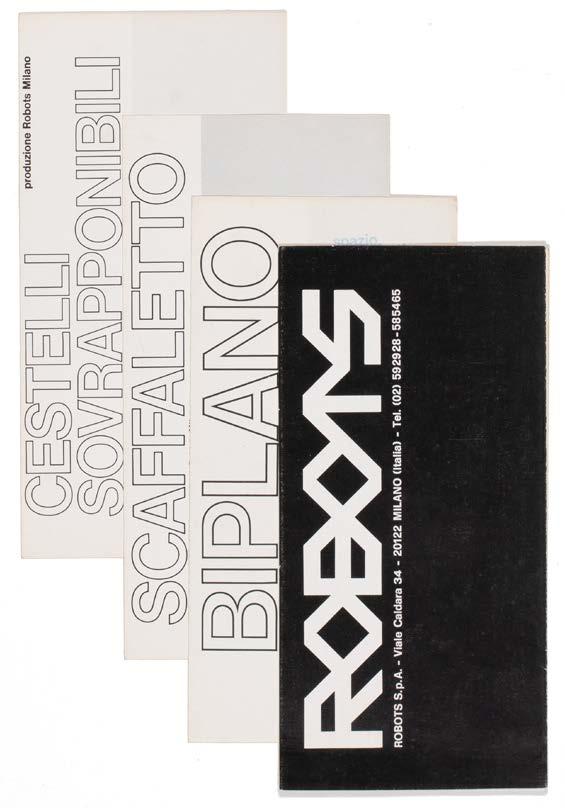
(94). Sottsass. Yantra di Terracotta. Ettore Sottsass JR. Pistoia. Design Centre / Poltronova. Undated. Square leporello. (210 × 210 mm, folded). Illustrated in colour. • The ‘Yantra di Terracotta’ series (c.1969) by Ettore Sottsass was a collection of distinctive glazed terracotta objects—ranging from vases and boxes to ashtrays— interpreting sacred geometric motifs with a postmodern sensibility. (See also cat. no. 62).

(98). Ferrari, Fulvio. Ettore Sottsass. Tutta la Ceramica. Turin. Allemandi & C. 1996. 4to. Illustrated in colour. Original publisher’s cloth. pp.192. • Catalogue raisonné on Sottsass’s ceramic works, with detailed descriptions and over 800 color illustrations of vases, plates, sculptures and other ceramic pieces. Widely regarded as the definitive reference on Sottsass’s ceramic work. Fulvio Ferrari is particularly known for his expertise in Italian design history.
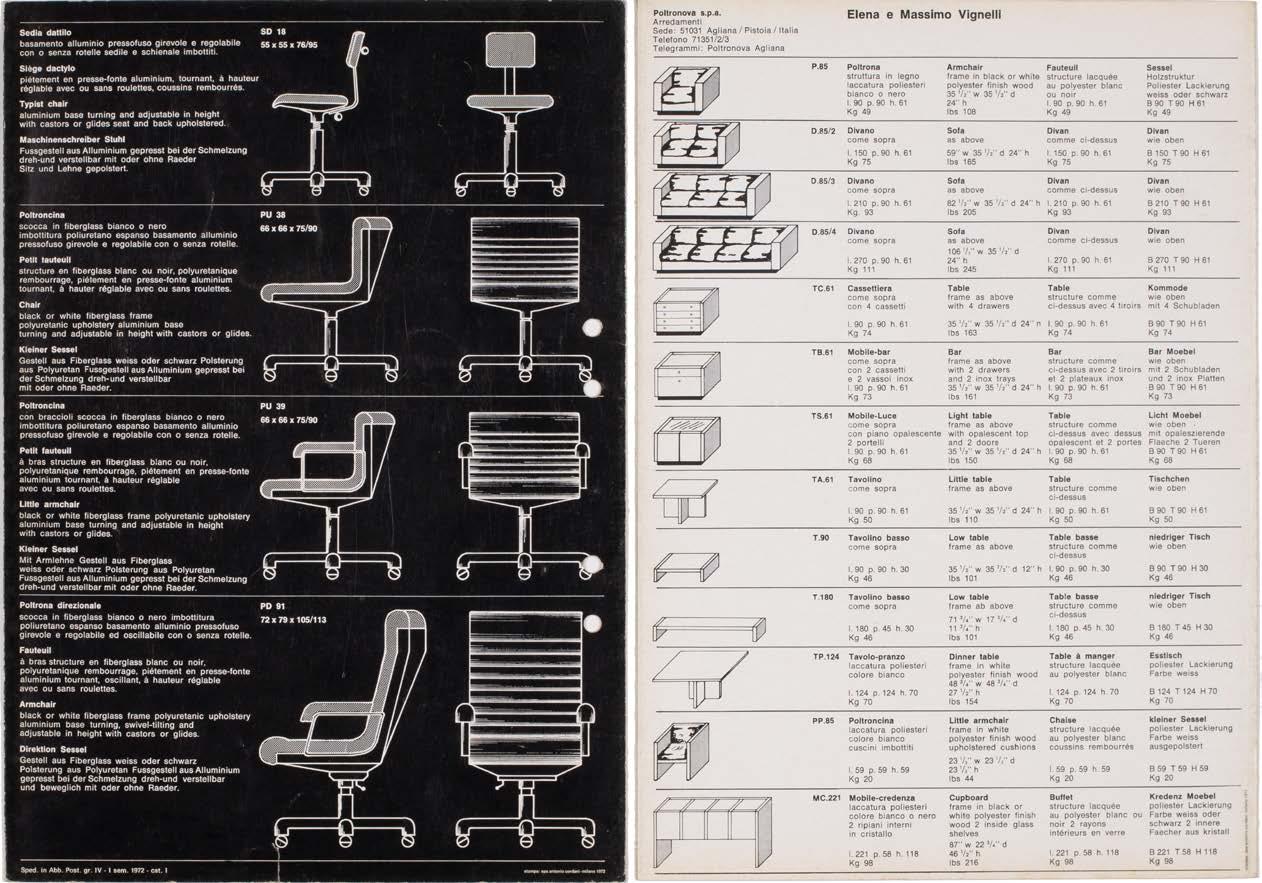
Sottsass (Sottsass Associati)
Ettore Sottsass 1980
Aldo Cibic
Cristina Morozzi
Marco Marabese
Matteo Thun

ROBOTS: (95). (Bruno Munari, Guido De Marco, et al). Robots. Milan. Robots. (1970s). Leporello + 3 loose folded sheets. Tall 8vo. Illustrated in black and white; 3 folded inserts, the Munari ‘Biplano’ is illustrated in colour. pp.16. (plus 3 folded sheets). • A leporello Robots product list for various storage systems and smaller household items (such as a perpetual calendar, a tray, an umbrella stand). Some of the designs include ‘Abitacolo’, ‘Vademecum’ and

(99). Ettore Sottsass. Eastside Collection / Westside Collection. Central Park Tables. (Two brochures). Knoll International. 1980s. Folded sheet (297 × 225 mm, folded). Illustrated in colour. • In the early 1980s, Sottsass was heavily involved with Knoll International, the leading American manufacturer. The ‘Eastside Collection’ and the ‘Westside Collection’ were two complementary series of furniture designed to ‘humanise’ the office environment.
‘Libreria’ (all by Munari); ‘Portarobe’ (Piero Polato) and a ‘Portacenere’ (Guido de Marco). ‘Abitacolo’ is a wireframe modular bed and room system designed for children and teens, one of the most iconic products to come out of Robots, Munari’s own company. It was awarded the Compasso d’Oro in 1979. ‘Vedemecum’ (1974) is a mobile bookcase/trolley made from chromed steel and aluminium. Robots produced innovative furniture until the 1990s.
Paolo Tovaglia
Marco Zanini
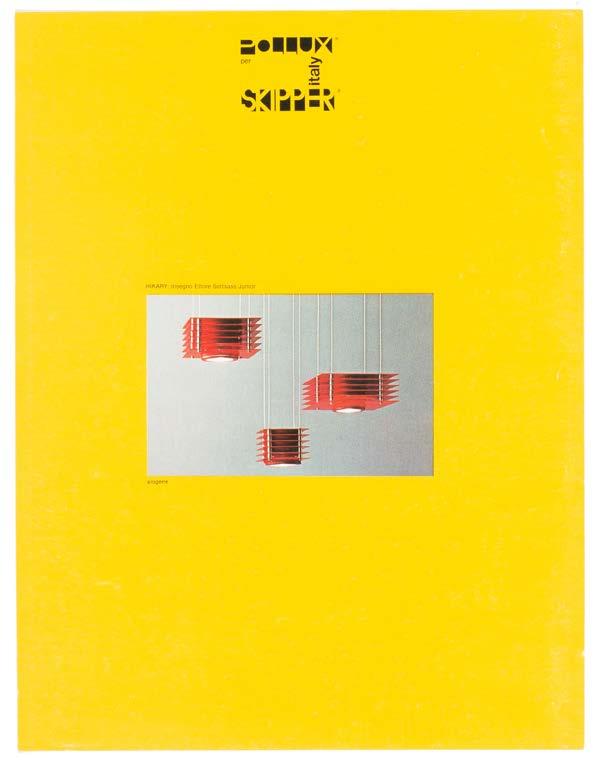
SKIPPER & POLLUX: (96). Sottsass, Ettore. Hikary. (Information sheet). Milan. Skipper & Pollux. 1970s. 4to. Wrappers.
• The ‘Hikary’ pendant light was designed by Ettore Sottsass for Skipper & Pollux in the 1970s.The design features a sophisticated geometic layering using enameled steel, enameled aluminum, steel wire, glass. Skipper & Pollux also collaborated with designers such as Bruno Gecchelin, Claudio Sallochi and Hans von Klier.
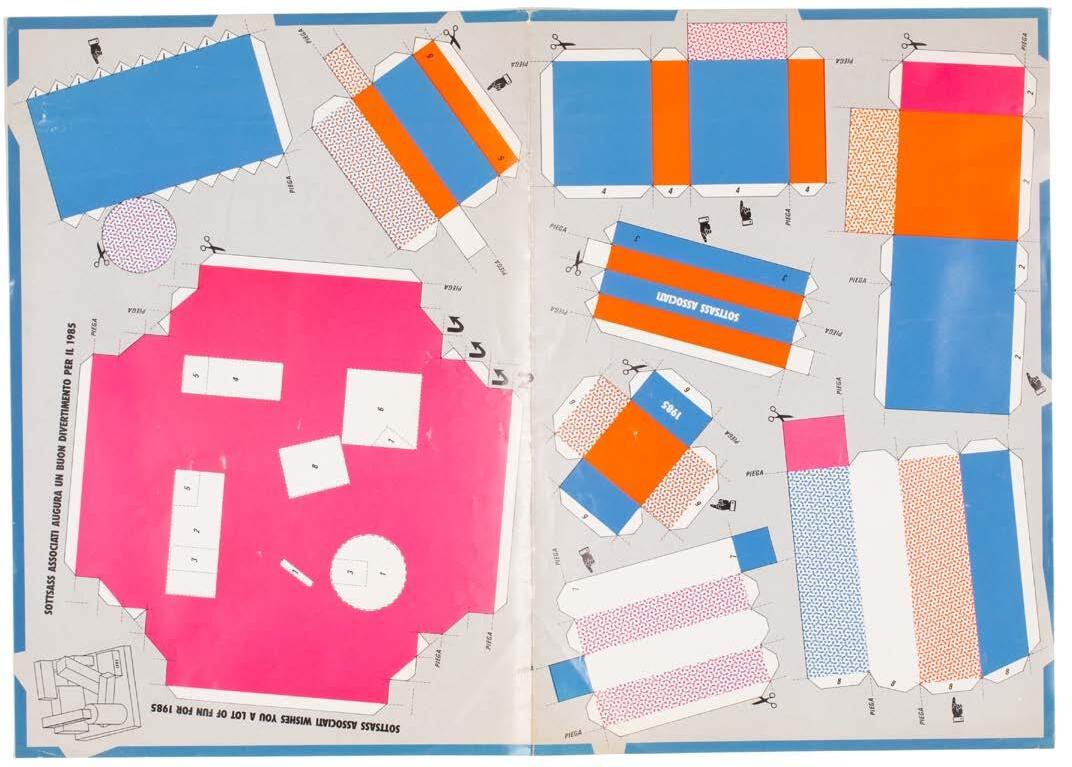
(100). (Greetings card). Sottsass Associati. 1984. Folded sheet, printed in colour to recto only. • Greetings flyer from with cut-out shapes to assemble a small office. ‘Sottsass Associati wishes you a lot of fun for 1985’. Sottsass Associati was created following the enthusiasm for Sottsass’s Memphis movement in the 1980s. He quickly assembled a major design consultancy, eventually leaving Memphis Group in 1985 to focus on the Associati.
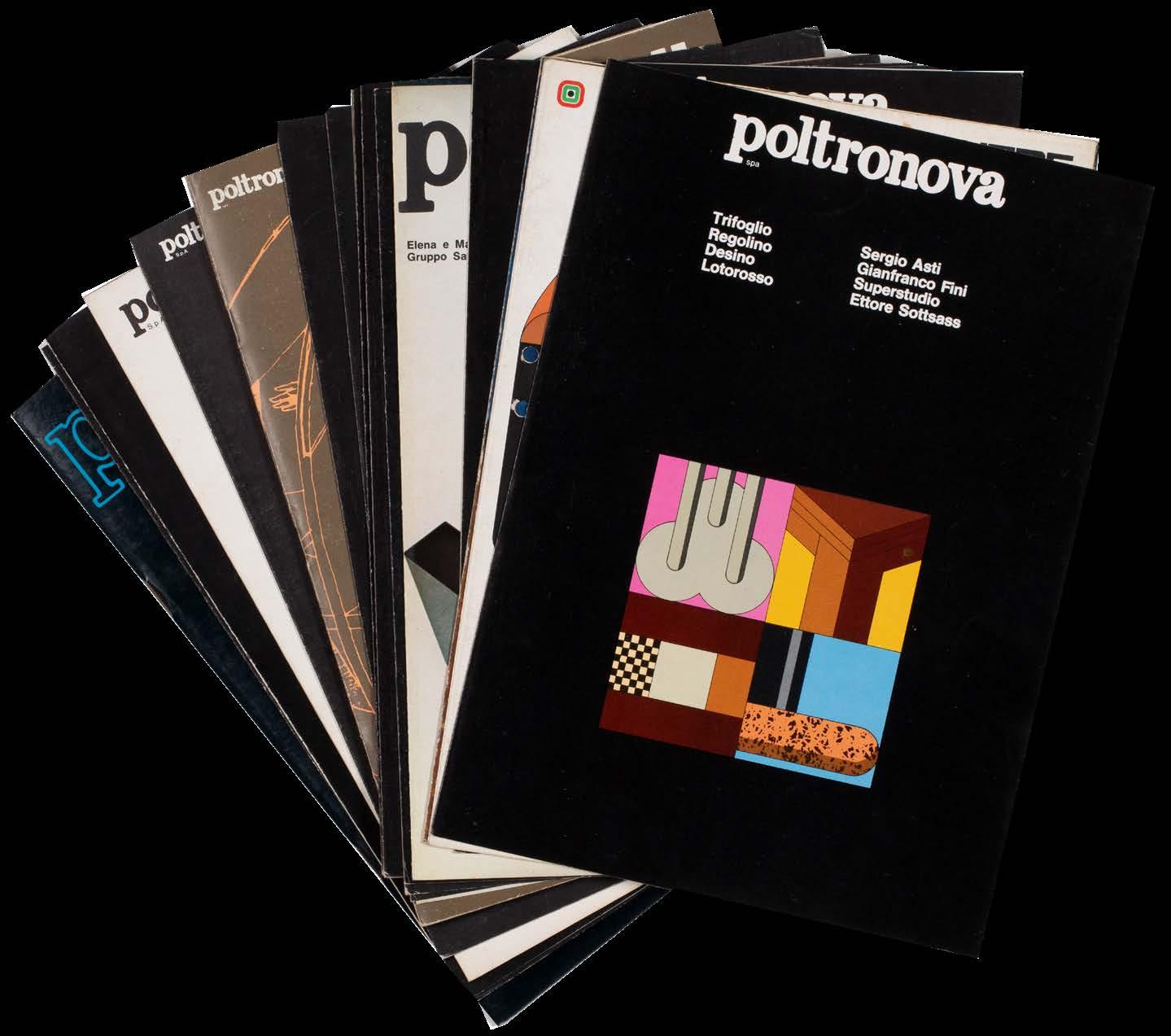

UniFor Vitra Zanotta
(Molteni Group) • 1969
Mario Bellini

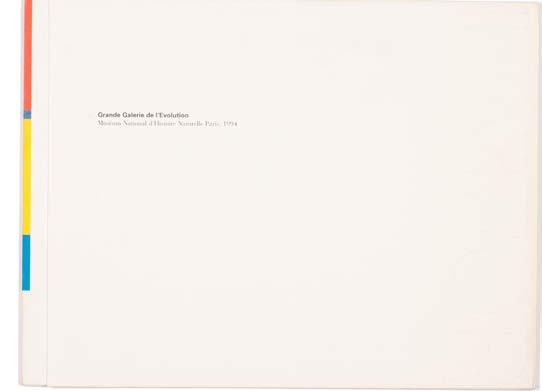
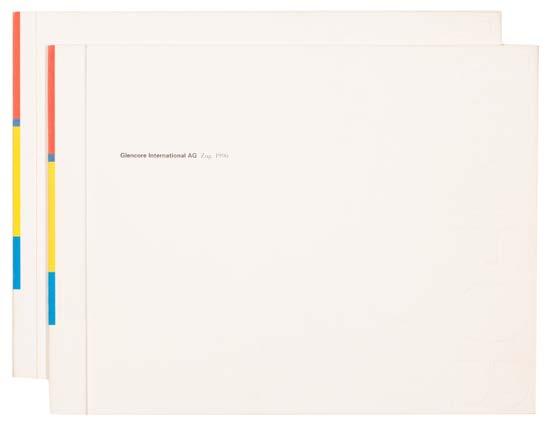
UNIFOR: (102). (Three catalogues). UniFor. (1990s). Large 4to. Illustrated in colour. Stapled wrappers. • UniFor worked closely with architects, designers and institutions to create customized work environments. Architects and designers who worked for the company include Renzo Piano (‘LessLess’ series), Norman Foster, Jean Nouvel, Pierluigi Cerri, David Chipperfield, OMA/ Rem Koolhaas and Michele De Lucchi.

(109). Catalogo 1978–79. 1979. 4to. Richly illustrated; occasional colour images. Original publisher’s grey paper-covered boards. pp.104. • Zanotta catalogue listing ‘Oggetti di Arredamento’, ‘Sedie’, ‘Poltroni e divani’, ‘Tavoli’ e ‘Letti’. Zanotta was one of the first companies to use expanded polyurethane foam and frameless construction in its designs, most notably the ‘Throw Away’ series of sofas and armchairs designed by Willie Landels.
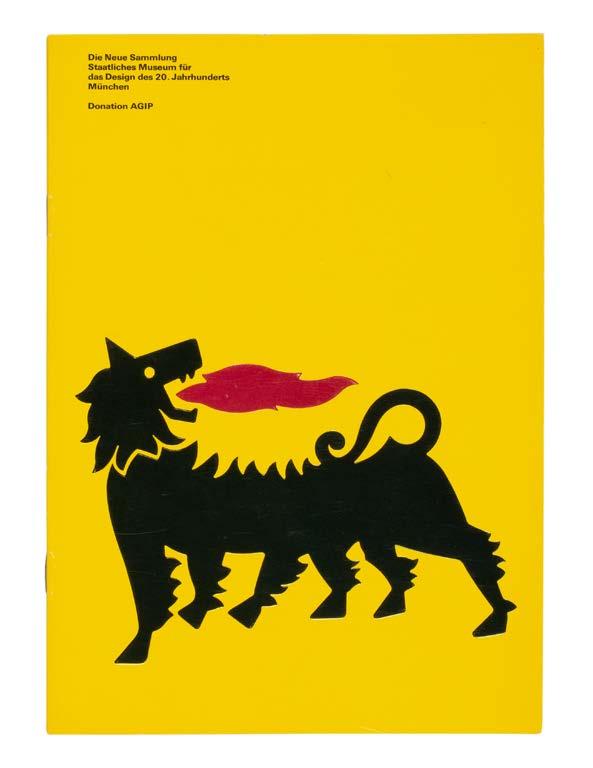
PART 1, Addendum: AGIP. Die Neue Sammlung Staatliches Museum für das Design des 20. Jahrhunderts Munchen. Donation AGIP. AGIP. Munich. 1984. 4to. Illustrated in colour. Wrappers. pp.20. • On April 12 1984, the Neue Sammlung in Munich received a donation from the Italian oil company AGIP. ‘For the first time in history, petrol station elements are being exhibited in a museum of applied arts and are being appreciated not from a technical but from a design perspective’. (Introduction)
Aurelio Zanotta • 1954
Gae Aulenti
Achille Castiglioni
Pier Giacomo Castiglioni
Piero Gatti

(103). Grande Galerie de L’Evolution. Museum National d’Histoire Naturelle, Paris, 1994. Turate. UniFor. c.1994. 4to. Illustrated in colour. Wrappers. pp.12. • A showcase publication advertising museum vitrines from UniFor. With: (104). Glencore International AG, Zug (Switzerland), 1996. Turate: Unifor. 4to. Illustrated in colour. Wrappers. • Architectural showcase publication for UniFor’s involvement in a high profile case study.
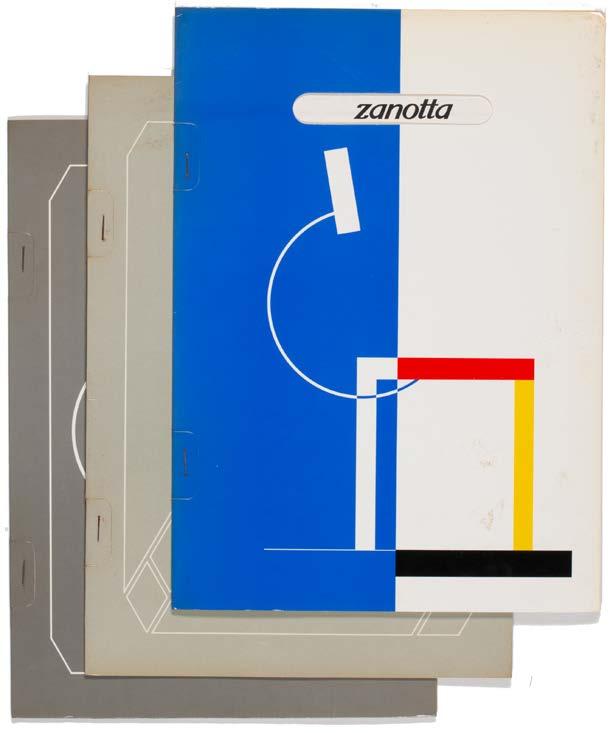
(110). Zanotta. (Chronology and Biography). (Milan). Zanotta. (1980s). 3 vols. Photocopied text pages. With one black & white photograph of Aurelio Zanotta inserted loose to rear cover. Original publisher’s stapled glossy folders with die-cut sections. pp.4; pp.12; pp.14. • Zanotta promotional booklets documenting the company’s history and structure. The volume containing the chronology is from Casciani’s monograph (see cat. no. 114),
(105). Mobili per lo spazio officio. Unifor. 2000. 4to. Illustrated in colour. Stapled wrappers. • ‘Furniture pieces for office spaces. Conceived to interpret complex needs with simple solutions. Designed for flexible, functional, natural surroundings. Built for people who work.’ (From the cover).
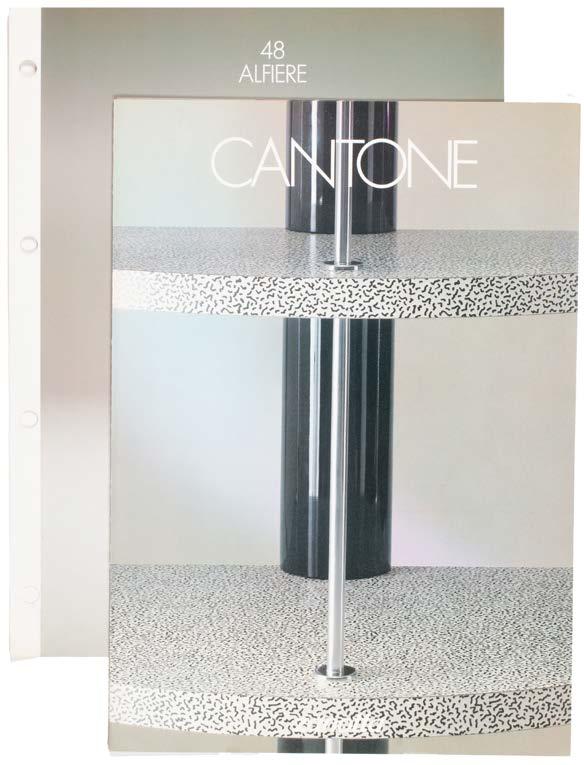
and another contains photocopied pages from ‘Design ist unsichtbar’ (Locker Verlag, 1981). Text in German. A black and white photograph of Aurelio Zanotta is included in one volume.
(111). Sottsass, Ettore. Cantone / 48 Alfiere. (Two brochures). Milan. Zanotta. (1980s). 4to. • Sottsass designs for Zanotta. ‘Cantone’ was a shelf/console (c.1981) and ‘Alfiere’ a bookcase.
Alessandro Mendini
Cesare Paolini
Ettore Sottsass
Franco Teodoro
Willie Landels


VITRA: (106). Mario Bellini. One Man Show. Vitra / New York. Museum of Modern Art. 1988. Leporello. (140 × 820 mm, unfolded). Illustrated in black and white. pp.12. • Leporello published on the occasion of the Mario Bellini exhibition titled ‘One Man Show’ at the Museum of Modern Art, New York, 1988. The exhibition was also associated with ‘Vitra Exhibitions’. With: (107). Mario Bellini / Bellini Collection / Vitra. Berlin. Vitra. 1980s


(112). Listino Prezzi 1/3/1983. Milan. Zanotta. 1983. 4to. Illustrated in black & white. Original publisher’s stapled wrappers. pp.80. • Zanotta 1983 price list. With: (113). (Promotional material). (Milan). Zanotta. (1980s). Various formats and sizes. Illustrated in colour. Three loose cards, leporello and a folded sheet in brown envelope with Zanotta design printed in red. • Zanotta promotional flyers advertising a range of their designs.
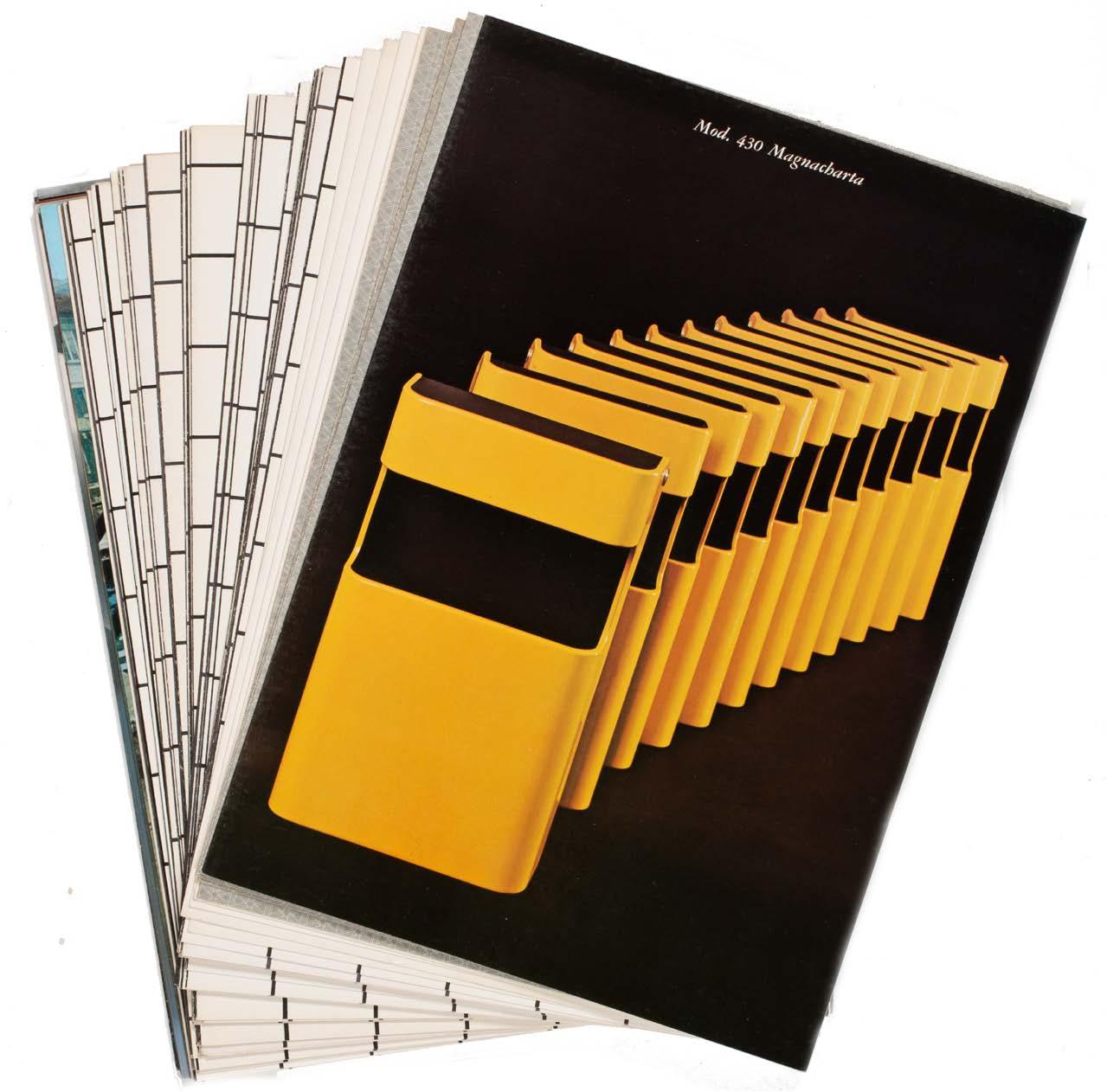
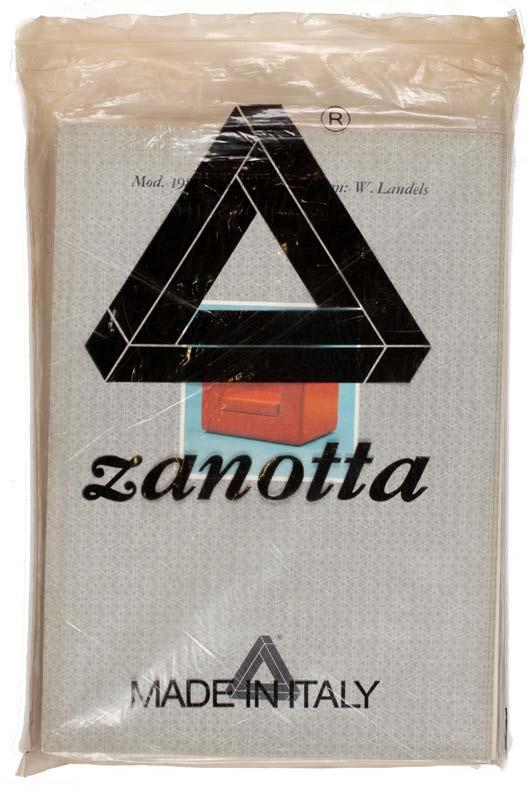
8vo. Single folded sheet. Illustrated in black and white. pp.4. • Small card relating to Bellini’s seating designs. ZANOTTA: (108). (Promotional material). Zanotta. (1960s). 46 vols. 4to. Illustrated in colour and black & white. Documents loose in Zanotta plastic sealed bag (now discoloured). • 46 brochures (some duplicates). With designs by Willie Landels (who was later the first editor of Harpers & Queen).
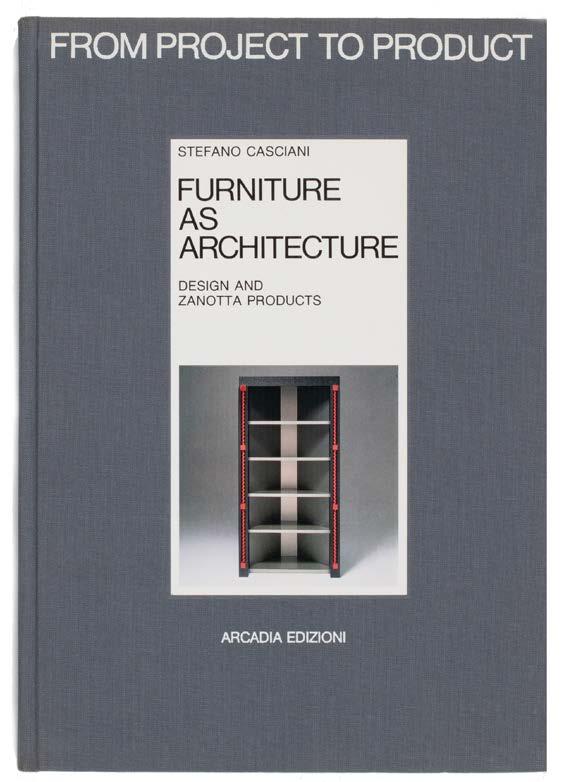
(114). Casciani, Stefano. Furniture as Architecture: Design and Zanotta Products. (Volume 1). Milan. Arcadia Edizioni. 1988. 4to. Illustrated in black and white. Grey cloth-covered boards with label pasted to centre. pp.202. • The second (English) edition of this extensive monograph on Zanotta products from the series ‘Dal Progetto al Prodotto’.
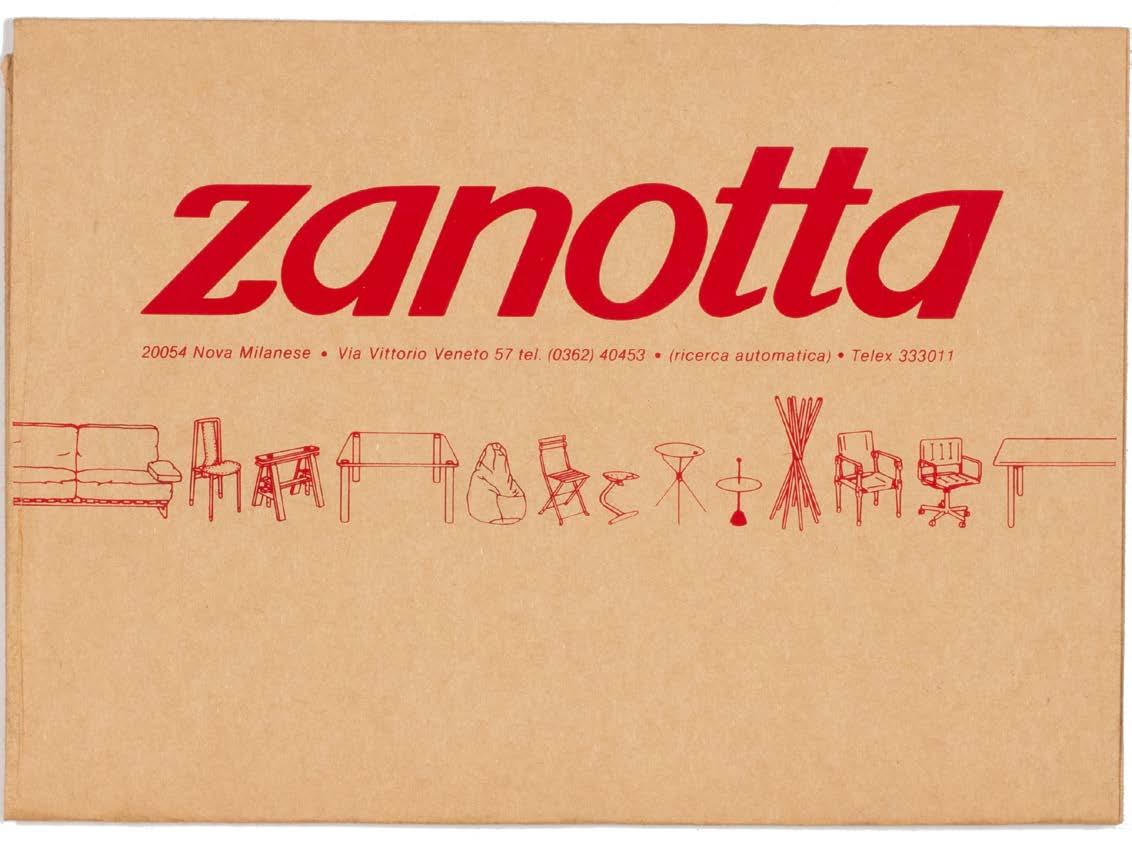
Part 2: G ermany Anthologie Quartett Braun
1983 Natalie du Pasquier
Paola Navone
Ettore Sottsass
George James Sowden
Kurt Thun

ANTHOLOGIE QUARTETT: (115). (Two fold-out posters). Essen. Anthologie Quartett. Undated. Folio. Illustrated in colour recto; black & white verso. (116). (Press folder). Essen. Anthologie Quartett. 1986. 4to. Original publisher’s portfolio. • With original black & white photographs, leporello leaflets (with duplicate), 6 coloured sheets with designs by Natalie du Pasquier and George James Sowden, fold-out poster, postcards and price lists inserted loose.
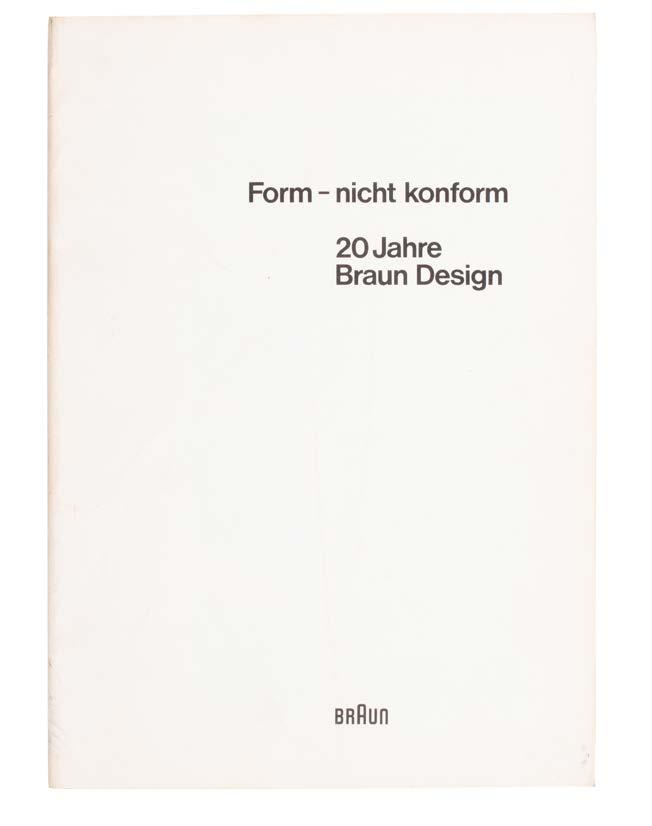
(121). Form - nicht konform. 20 Jahre Braun Design. Frankfurt. Braun. 1970s. 4to. Illustrated in black & white. Stapled wrappers. pp.30. • Braun publication celebrating products from the first 20 years of the company’s history. Each item is illustrated alongside its manufacturing date and short description.
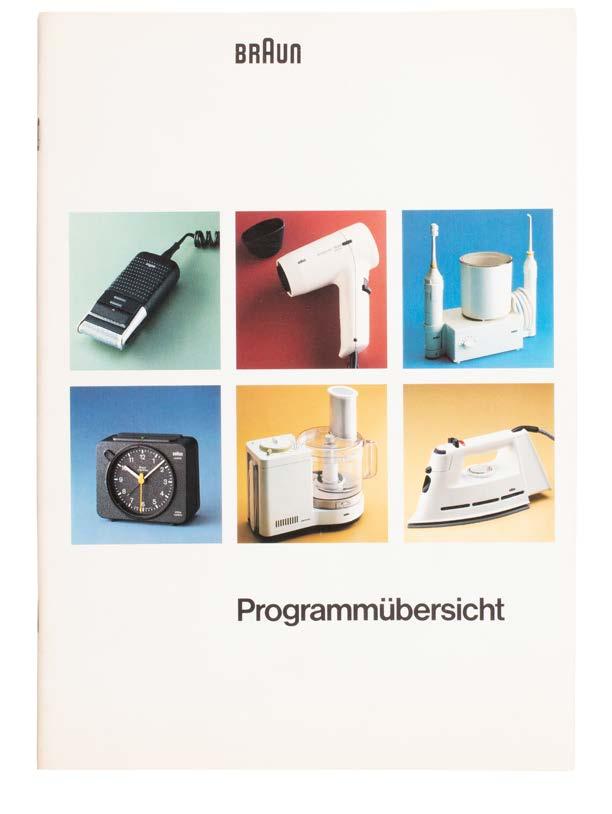
(131). Programmübersicht. Stand August 1985. Frankfurt. Braun. 1985. 4to. Illustrated in colour. Stapled wrappers. pp.42.
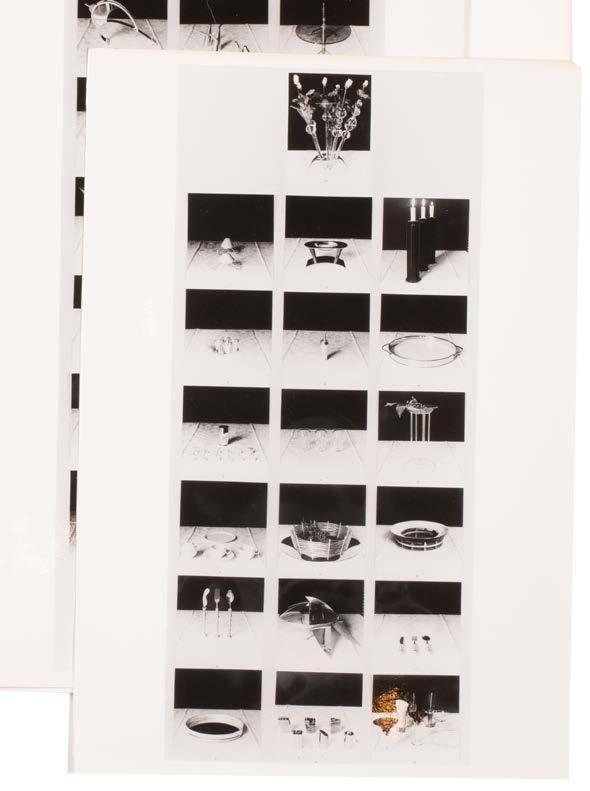
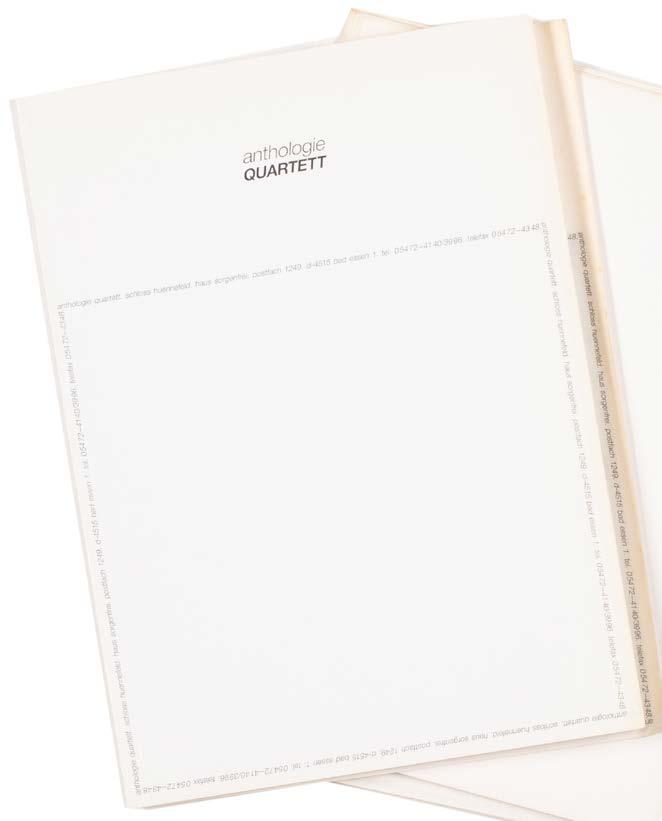
(117). (Price list). Essen. Anthologie Quartett. Undated. 4to. Illustrated in black & white. • With additional inserted price lists from the late 1980s. Not pictured.
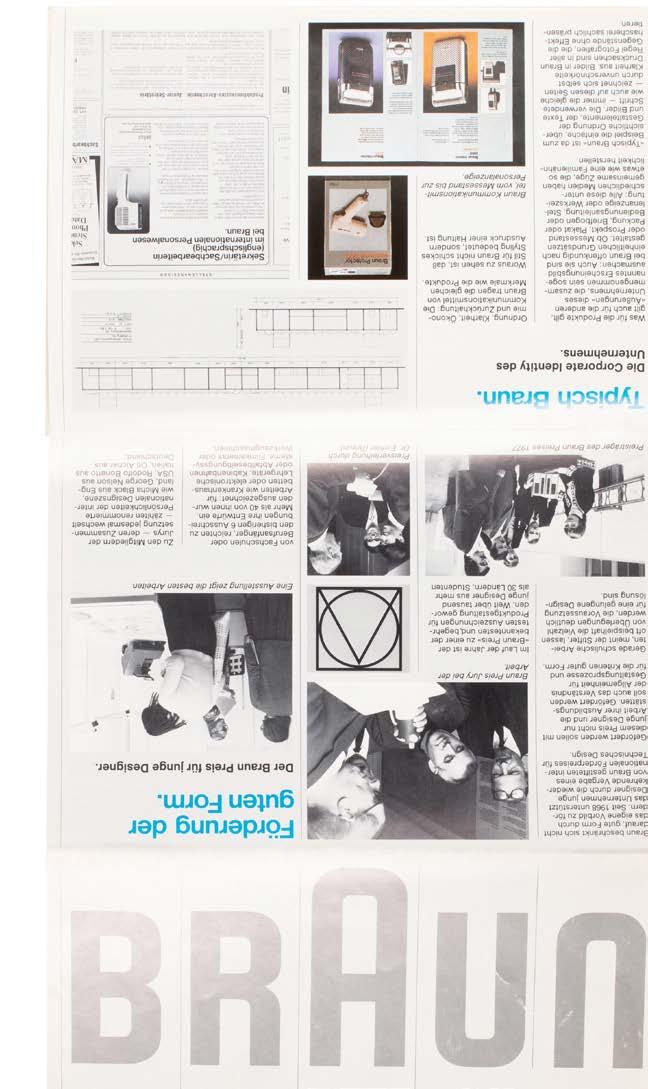
(122). Die Produkte von Braun / Brauns Beitrage zur Industrie-entwicklung &c. (1970s). Leporello. (212 × 150 mm, folded). Illustrated in colour. pp.14. (123). Braun. (6 promotional leaflets). Frankfurt. Braun. 1970s. Tall 4to. Illustrated in colour. • The leaflets advertise hair styling sets, kitchen equipment and film cameras. (124). magazin. w & v. Nr.42. Braun. 1975. 4to. Illustrated in black & white. pp.26. Image: p.27.
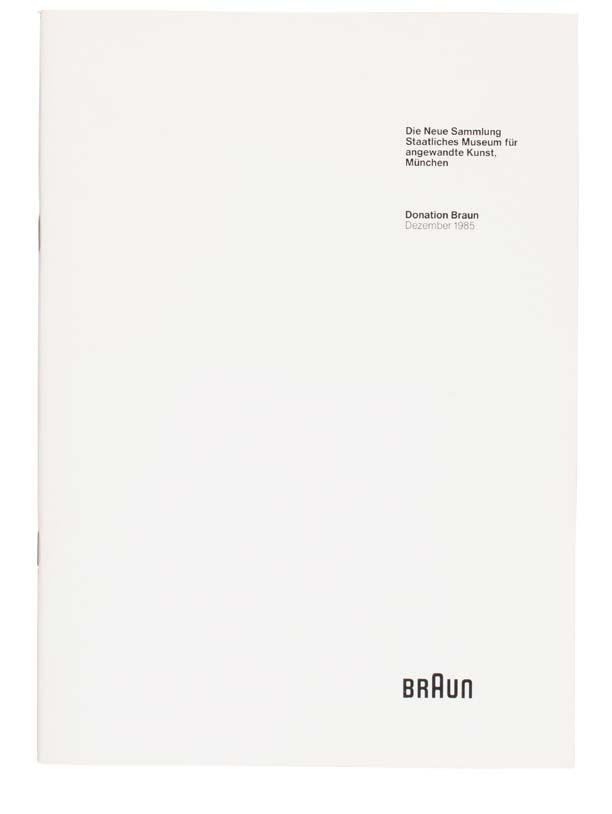
(132). Die Neue Sammlung - Staatliches Museum für angewandte Kunst, München. Munich. Staatliches Museum. 1985. 4to. Illustrated in colour and black & white. Stapled wrappers. pp.28. • Donation Braun, December 1985. Marks a time when the museum was consolidating its identity as a world leader in collecting and exhibiting industrial and product design before its move to the Pinakothek der Moderne, Munich in 2002.

(118). (Two product folders). Essen. Anthologie Quartett. Undated. 4to. Illustrated in colour. Ringbinder folder. c.70 sheets; c.18 sheets. Some foldout sheets. • Nice piece of promotional design in itself. In the 1980s Anthologie Quartett commissioned a large number of accessories and objects from more than 50 designers from all over Europe; in the 1990s, greater emphasis was placed on furniture and lamps. Image: p.27.
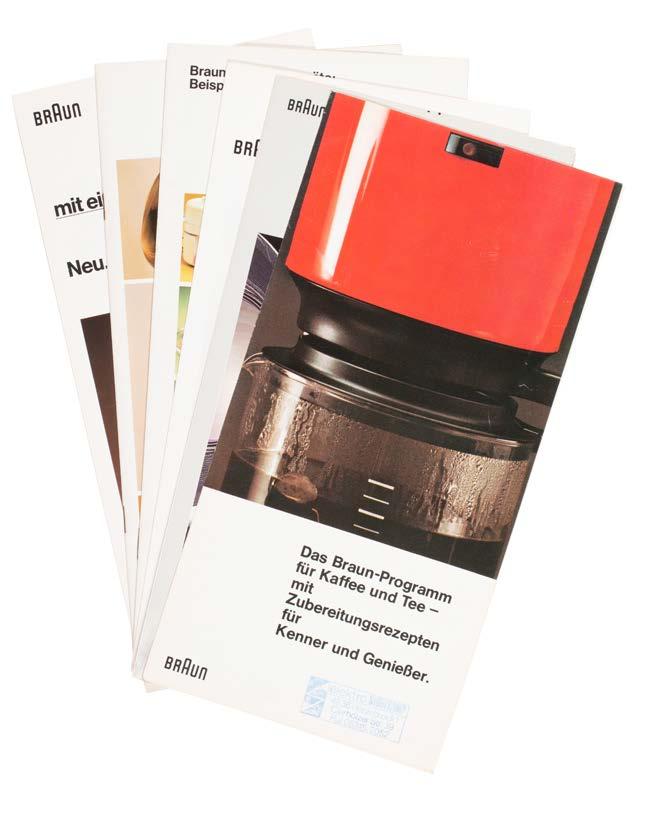
(125). Reprint from ‘Canada Commerce’, The Role of Design in Industry, Braun, (March isssue 1976). 1976. 4to. • Photocopied text pages. Loose in lime green paper wrappers. (126). Braun Preis 1977. Frankfurt. Braun. 1977. Large 4to. Illustrated in black & white. pp.6. • Fold-out Braun Prize 1977 publication. With text in German, French and English. Image: p.27 (127). Betriebsspiegel 179. Frankfurt. Braun. 1979. Large 4to.
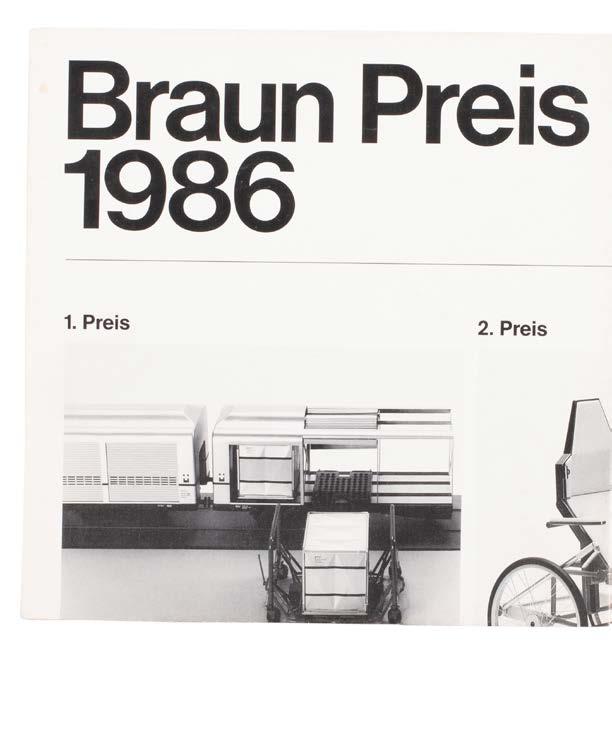
(133). Braun Preis 1986. Frankfurt. Braun. 1986. Single folded sheet, (210 × 210 mm). • Fold-out poster. (134). Braun Products 1988; Ansichten zum Design; Braun im Rückblick. 1921–1989; Tatsachen über Braun. Frankfurt. Braun. 1988; 1990; 1991. 4to. Illustrated in black & white and colour. Stapled wrappers. pp.28; pp.44; pp.74; pp.34. • 4 Braun booklets outlining the company’s history and products. One in English.
Max Braun • 1921 Dieter Rams
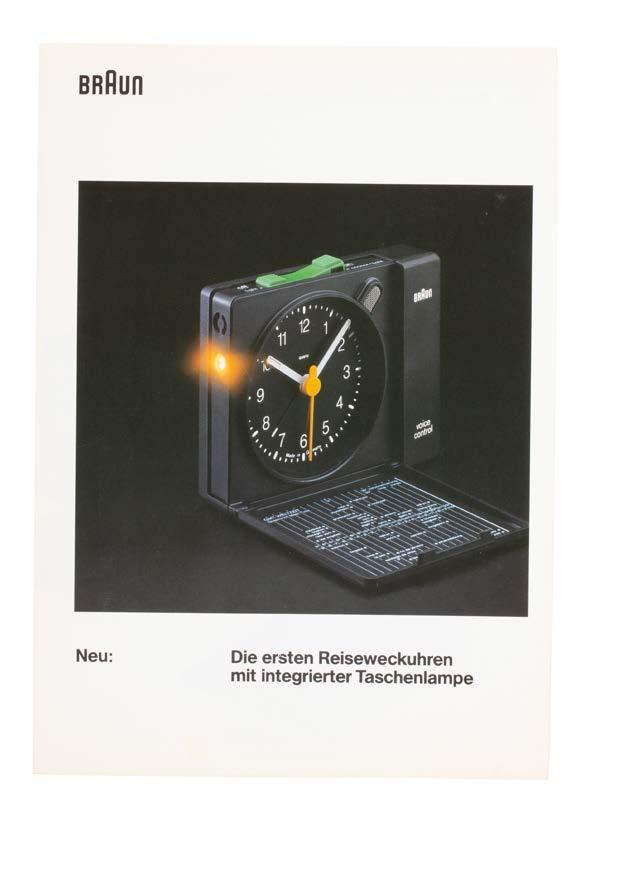
(119). Anthologie Quartett. Lighting. Essen. Anthologie Quartett. 2001. 4to. Illustrated in colour. Stapled wrappers. • Among the most iconic lighting designs from Anthologie Quartett was ‘Cellula’ (by Nunzia Carbone and Tiziano Vudafieri), a modernist interpretation on the classic chandelier.
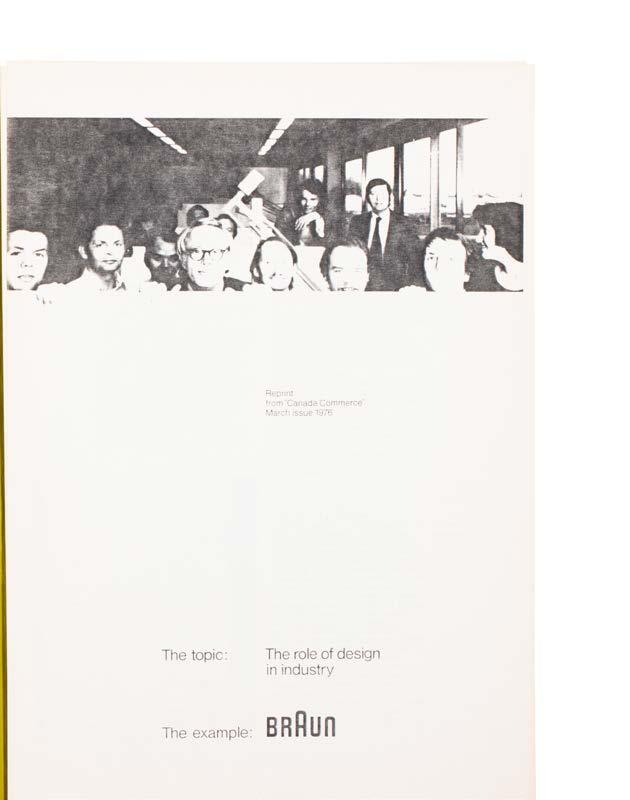
BRAUN: (120). Braun. (6 promotional leaflets). Frankfurt. Braun. 1970s–80s. 4to. Illustrated in colour. • The leaflets include ‘HiFi Programm ‘78’, leaflets for alarm clocks and various other types of household / kitchen and bathroom equipment (razors and electric toothbrushes).
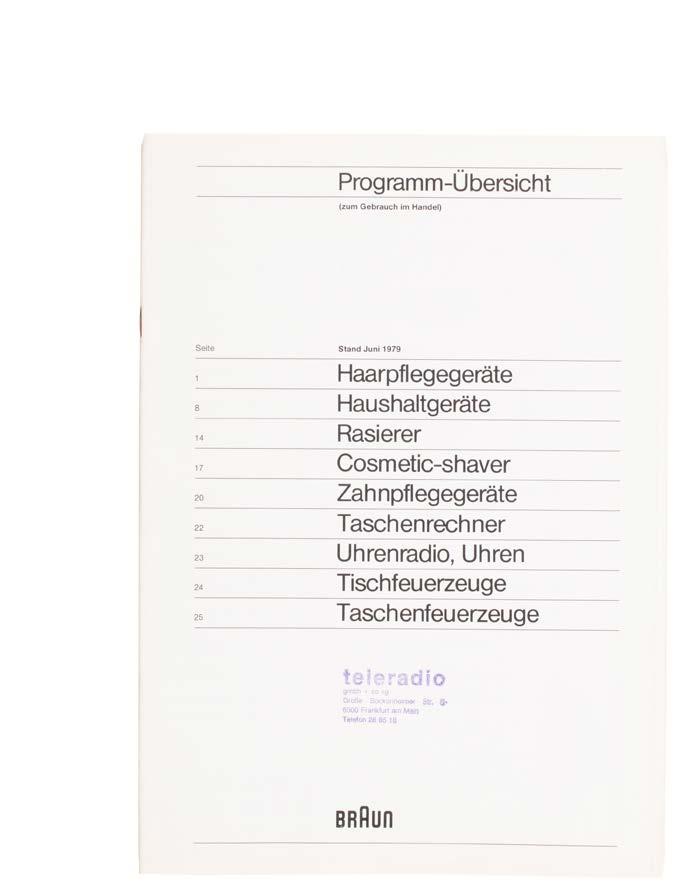
Illustrated in black & white. pp.8. Single issue of Braun’s newsletter. Image: p.27. (128). Was nutzt die gute form? (What use is good form?) Alstertal-EinkaufsZentrium. Hamburg-Poppenbuttel. 1979. 4to. Illustrated in colour. • Flyer for the 1979 exhibition which critically reflected on the role of design in everyday life, echoing echoes Rams’s belief in design as a tool for clarity and function, not decoration or prestige. Image: p.27 (129). Programm-Übersicht. Stand Juni 1979. Frankfurt. Braun. 1979. 4to. Illustrated in colour. Stapled wrappers. pp.26. • Lists ‘Haarpflegegeräte’, ‘Hausheltgeräte’, ‘Rasierer’, ‘Cosmeticshaver’, etc. (130). Braun im Rückblick. Daten und Fakten 1921–1979. Braun. 1980. Square 4to. Illustrated in black & white. • Historical survey highlighting key milestones, products, and design achievements at Braun over nearly six decades. Image: p.27.
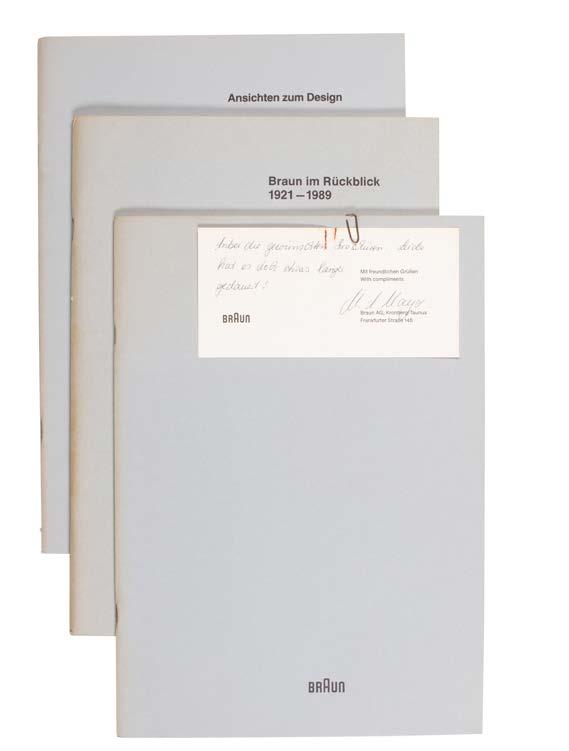

(135). Braun HiFi. Design als Programm. Institut für Technische Form. 1989. Tall 8vo. Illustrated in black & white. • Exhibition invitation card. (136). Braun Design Sammlung. Industriedesign seit 1955. Design Zentrum Hessen / Institut für Neue Technische Form. Darmstadt. 1990. 4to. Illustrated in black & white. • Exhibition flyer. Image: p.27. (137). Braun+Design Tax. Hamburg. Jo Klatt Braun+Design. 1992. Tall 8vo. pp.152. Image: p.27.
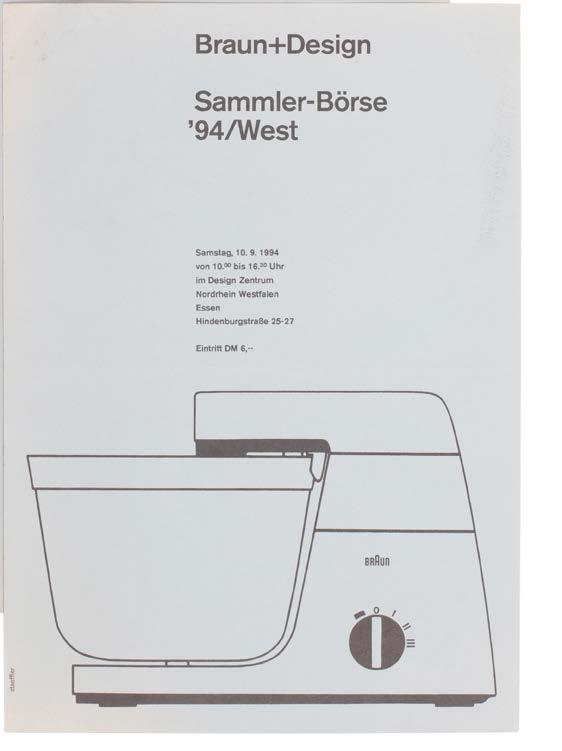
(138). Braun+Design/Design+Design. Hamburg. Jo Klatt Braun+Design. 1992. 4to. Illustrated in black & white. Stapled wrappers. pp.38; pp.38; pp.38. • Three issues of this magazine for design collectors. With grey paper Braun+Design inserts together with ‘Braun+Design. Sammler-Borse. 94/ West’, advertising the Braun exhibition at Design Zentrum Westfalen, Essen. With ‘Design+Design Gesamtprogramm 94/95’ leaflet. Image also p.27.
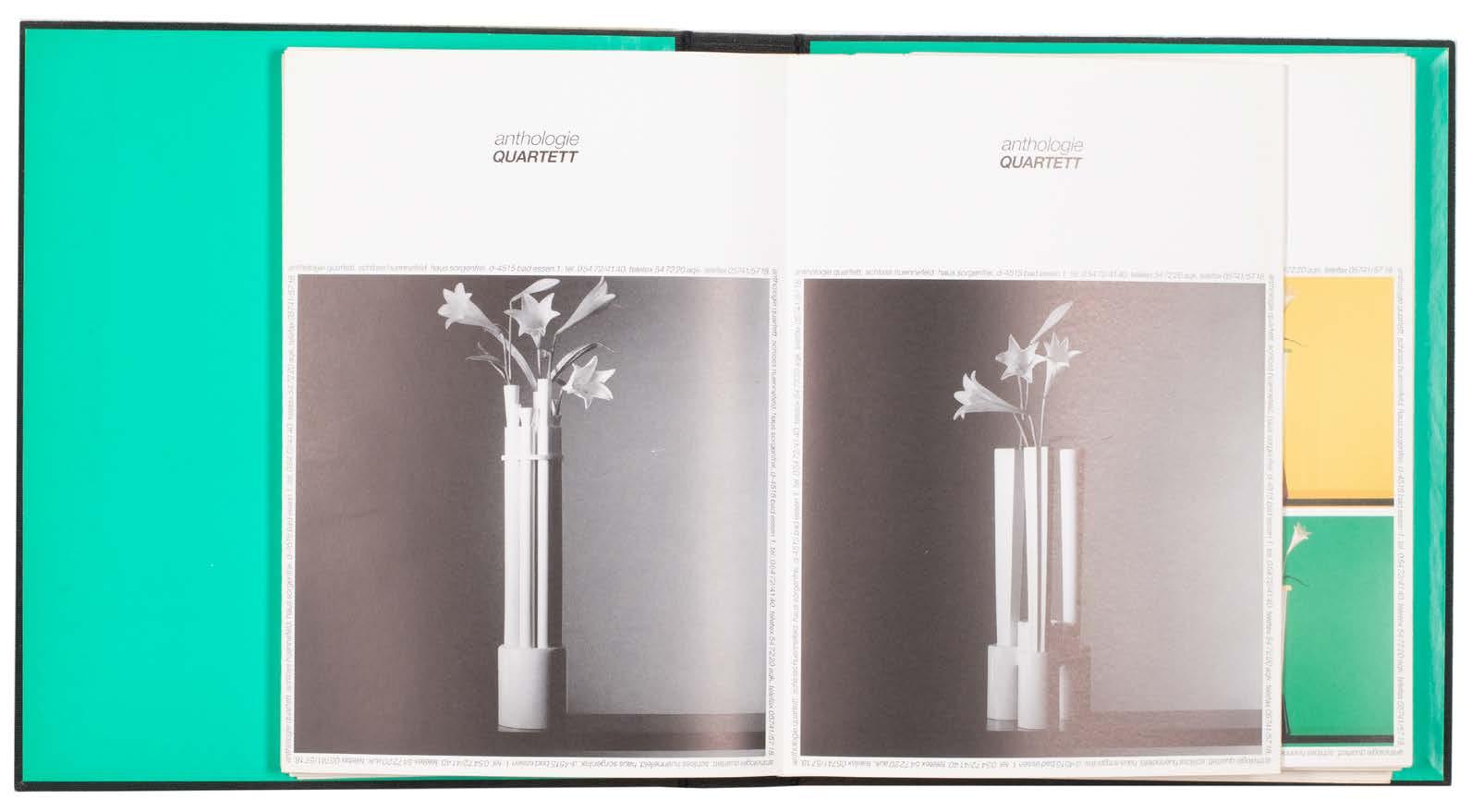
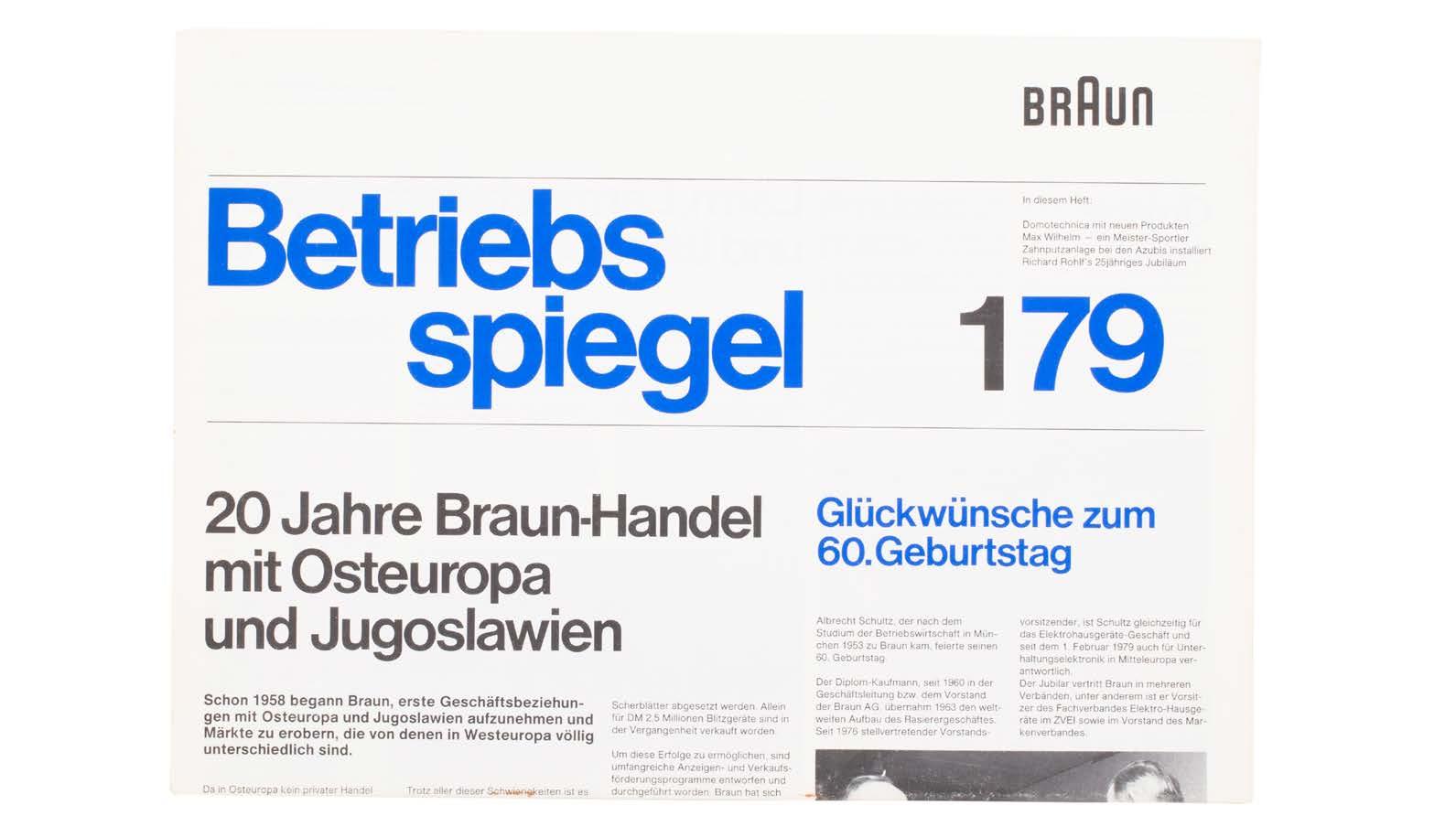


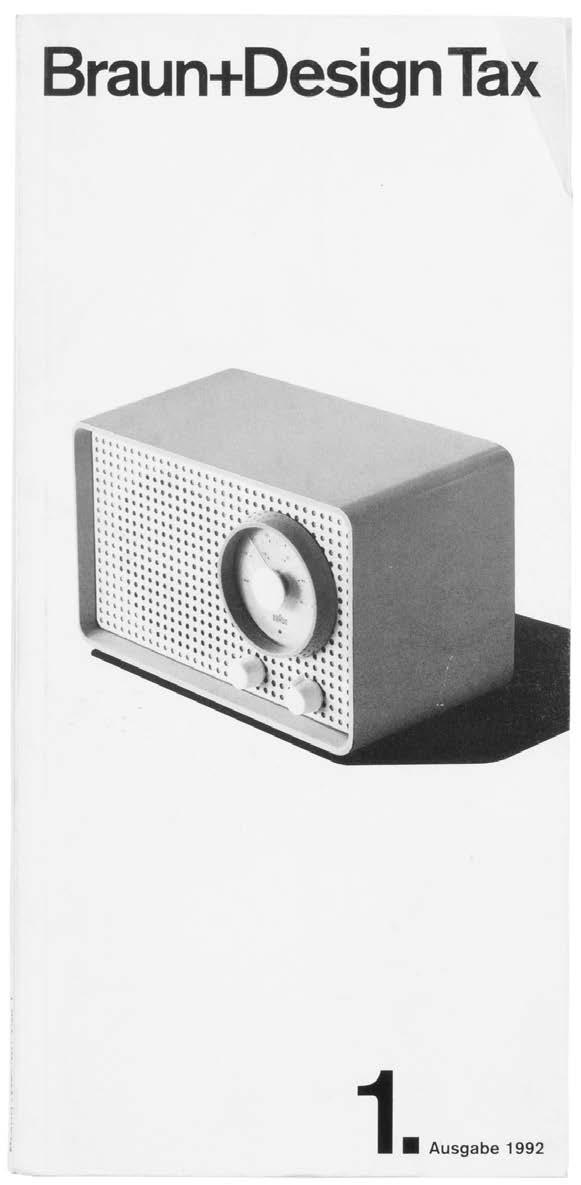
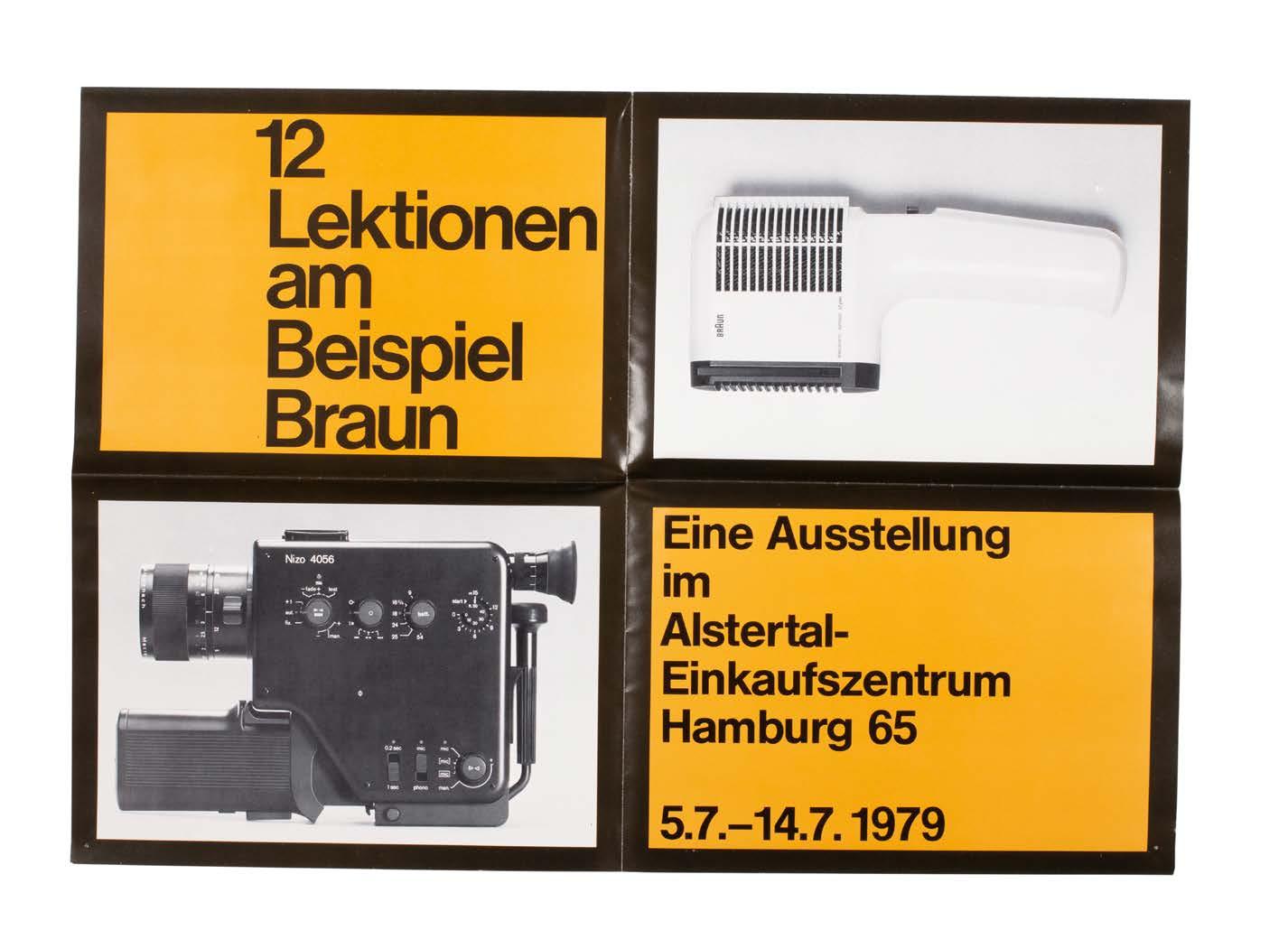
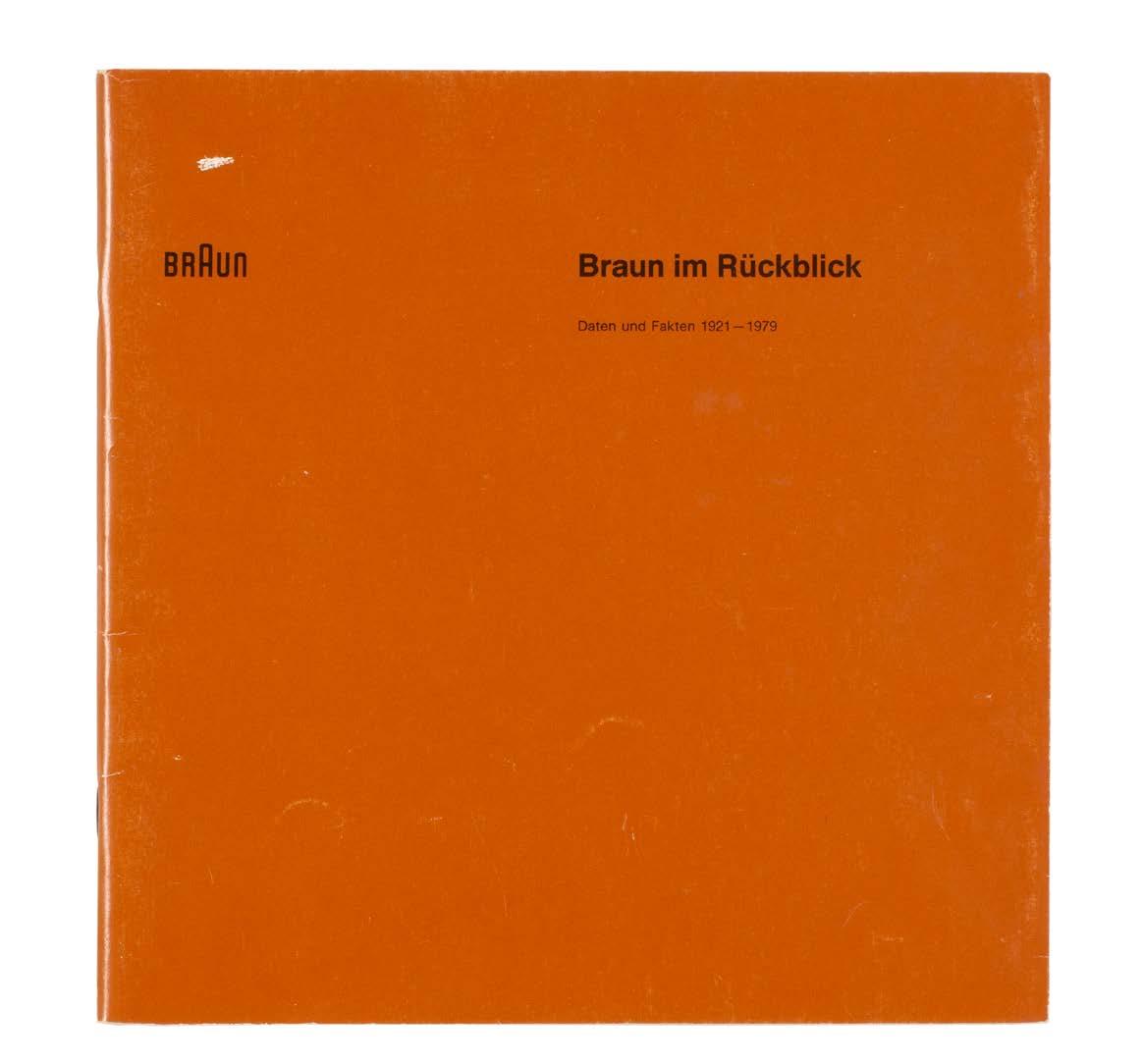
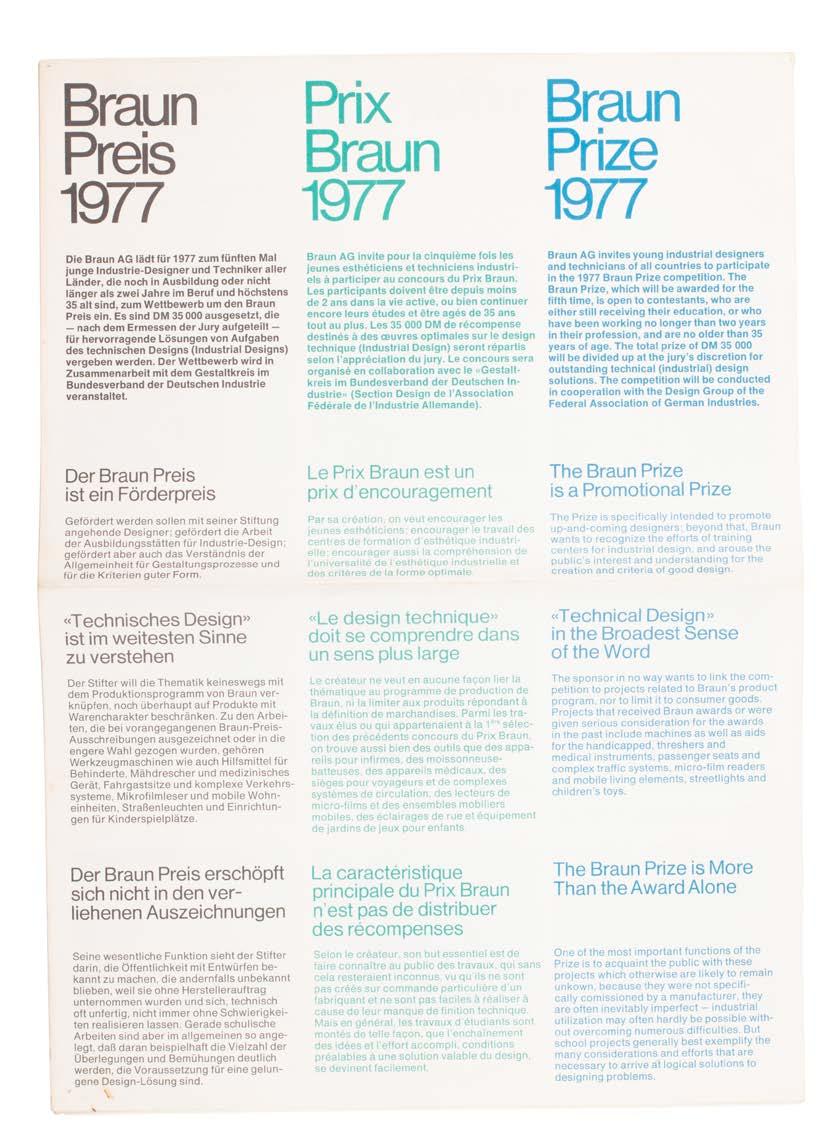


From top, rows left to right: no.118 (two images), no.127, no.137, no.128, no.124, no.126, no.130, no.136, no.138
Bulthaup Gaggenau Vitsœ Vorverk
Martin Bulthaup • 1949
Rolf Heide Otl Aicher
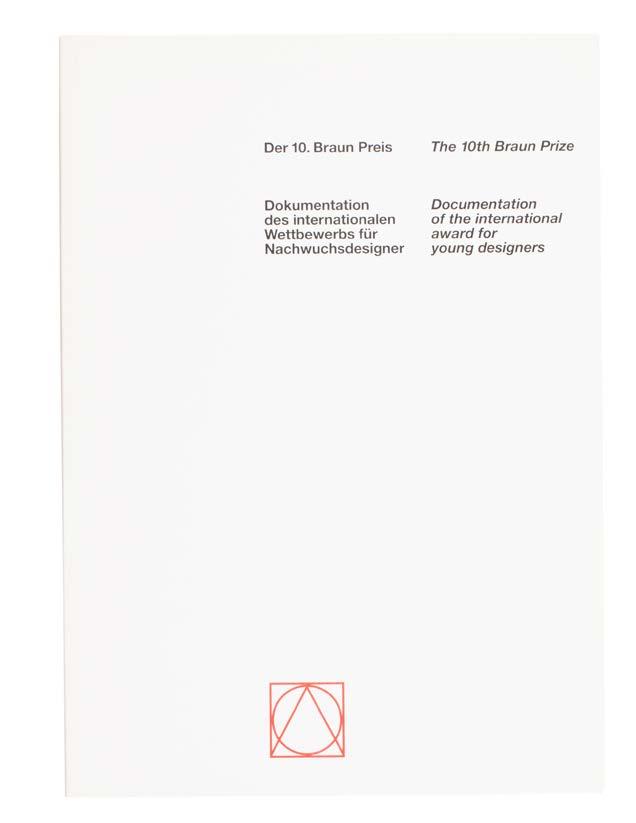
(139). Der 10. Braun Preis. Dokumentation des internationalen Wettbewerbs für Nachwuchsdesigner. (The 10th Braun Prize: documentation of the international award for young designers). Braun. 1994. 4to. Illustrated in colour. Wrappers. pp.78. • Text in English and German. The Braun Prize was first established in 1968 and is Germany’s first international design promotion award in the field of product design. Showcases winning projects.

BULTHAUP: (146). (Three catalogues).
Aich. Bulthaup. 1980s. 4to. Illustrated in colour. Stapled wrappers. • Kitchen equipment and worktop design from Bulthaup. The 1980s marked the beginning of Bulthaup’s collaboration with designer Otl Aicher. It was Aicher’s belief that the kitchen should be an inviting place where meals are prepared together; where all the required tools and implements are clearly visible, and stored within easy reach.
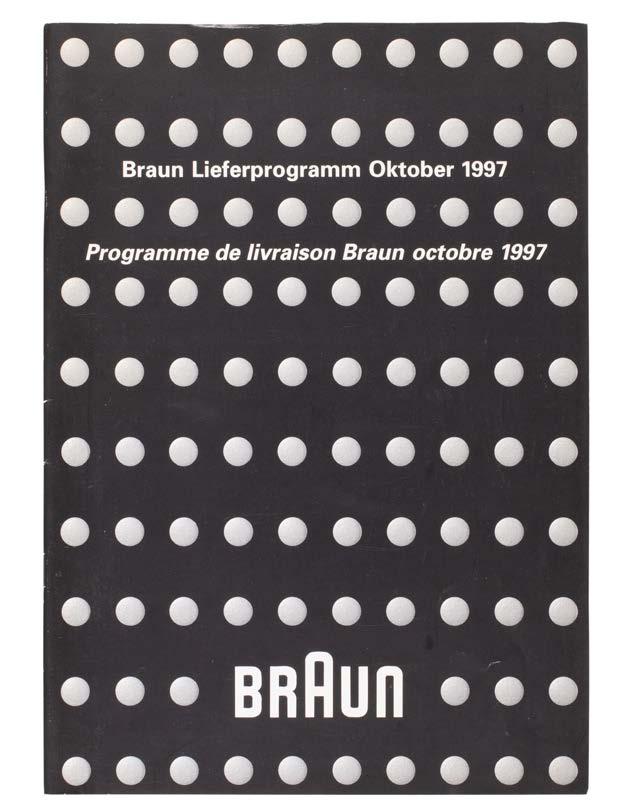
(140). Braun Preis 1999. Kooperation. Technik und Design. (Two documents). 1999. 4to. Illustrated in black & white. Not pictured.
(141). Braun Lieferprogramm Oktober 1997. Frankfurt. Braun. 1997. 4to. Illustrated in black & white. Stapled wrappers. pp.30. • Details the company’s delivery program, October 1997. Text in German and French.
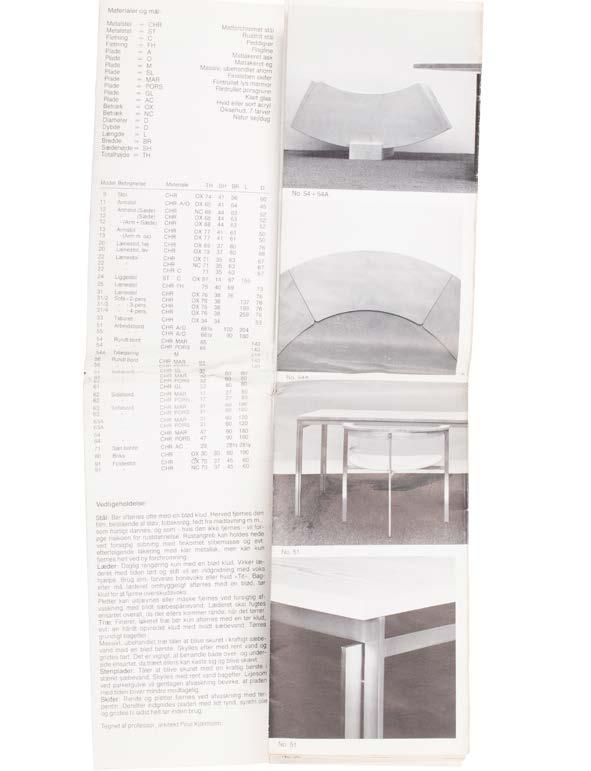
FLEINER MÖBEL: (147). (Poul Kjaerholm). Stuttgart-West. Fleiner Möbel. Undated. Leporello. Illustrated in colour. pp.12. • Lists stools, chairs, desks and sofas by the Danish designer Poul Kjaerholm (see also Part 3). Fleiner Möbel was incorporated in 1983. The collaboration with ‘architare’ in more recent years has led to the company being recognised as a top furniture company in Germany.
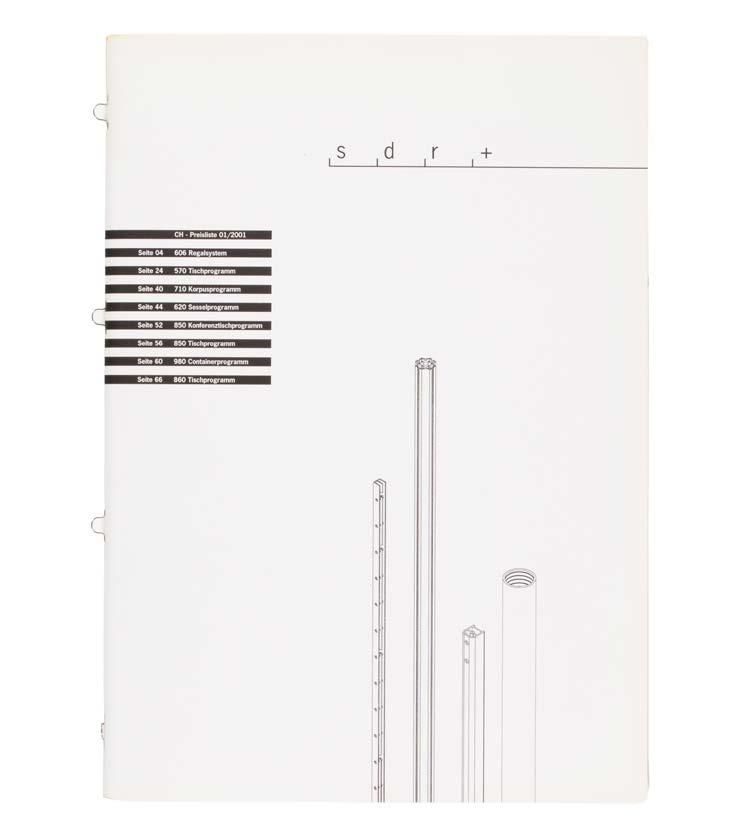
SDR+ (151): srd+. Preisliste 01/2001. sdr+. Cologne. 2001. 4to Illustrated in colour. Loop-stapled wrappers. pp.70. • sdr+ (Systemmöbel Dieter Rams) was a German furniture manufacturer that held the European license to produce Dieter Rams’ furniture designs, including the iconic 606 shelving system, the 620 chair programme, and the 570 table programme.
(1683) Rolf Heide
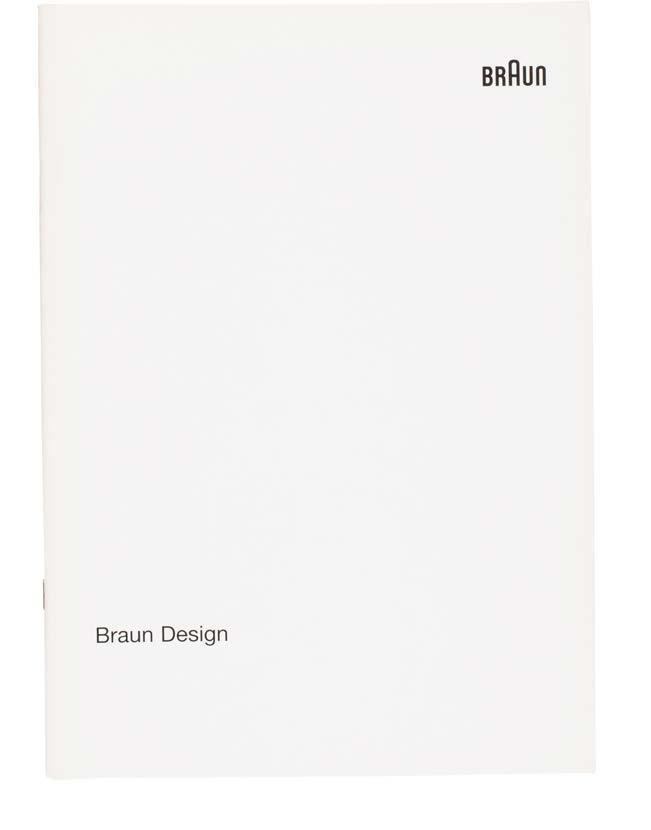
(142). Braun Design. Frankfurt. Braun. 1999. 4to. Illustrated in colour. Stapled wrappers. pp.34. • Company overview. Text in German and English. Image: see also p.29.

GAGGENAU: (148). Kücheneinbaugeräte. Typen & Maβe. Gültig ab Mai 1984. Gaggenau/Baden. Gaggenau. 1984. 4to. Illustrated in black & white. Stapled wrappers. pp.22. • Built-in kitchen appliances. A German manufacturer of high-end kitchen appliances, Gaggenau has a history stretching back to 1683, initially founded as a nail forge in the Black Forest. Over centuries, it evolved from metalworking to become a renowned name in kitchenware.
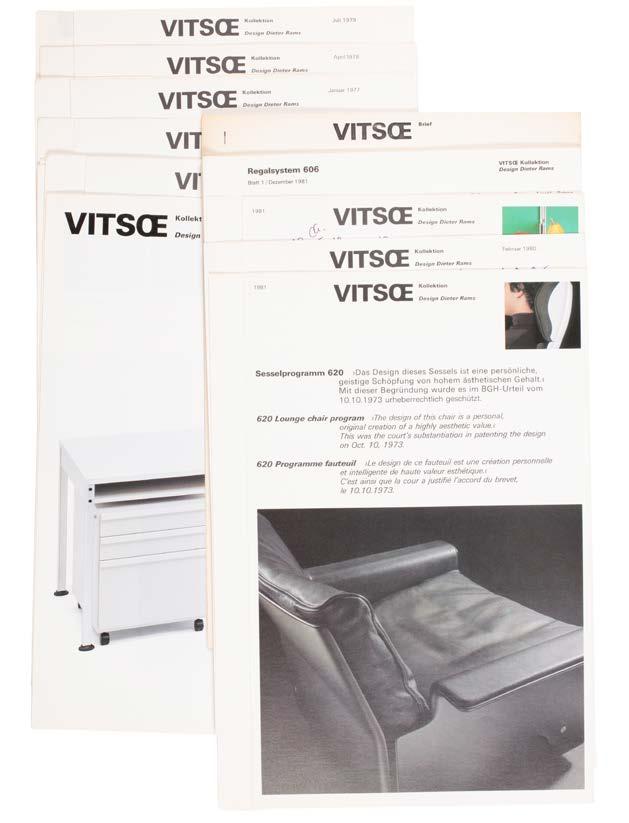
VITS Œ: (152). Rams, Dieter. Vitsœ Kollektion. Design Dieter Rams. (13 product sheets). Frankfurt am Main. Vitsœ. 1975–1981. 4to. (Single folded sheets). Illustrated in colour and black & white. • Vitsœ / Dieter Rams product sheets, which include: ‘Regalsystem 606’ (Oktober 1975), ‘Sesselprogramm 620’ (Marz 1977), ‘Schiebetursystem 690’ (January 1977), ‘Tischprogramm 570’ (March 1977) and ‘Sesselprogramm 601/02’
Niels Vitsø, Otto Zapf • 1949 Dieter Rams (1883) Andrea Branzi
Rolf Heide
Michele De Lucchi
Ettore Sottsass
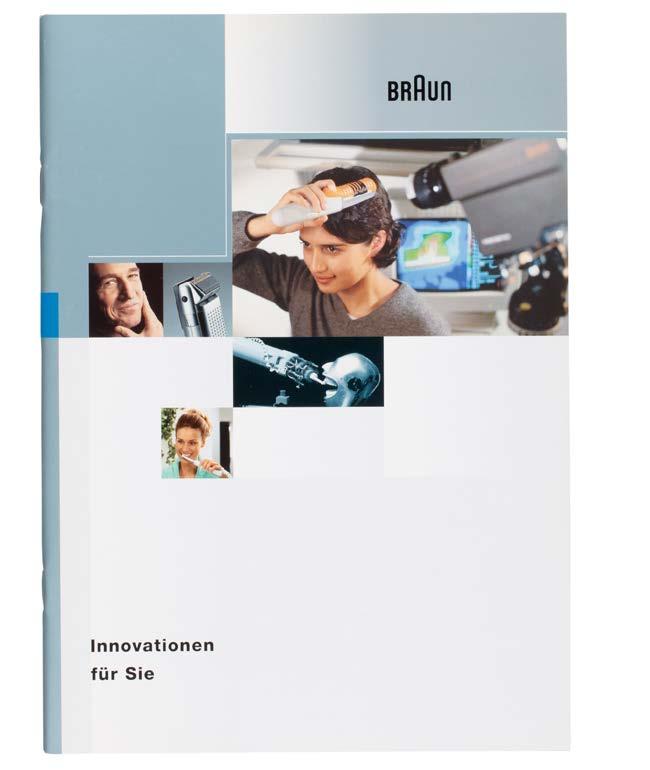
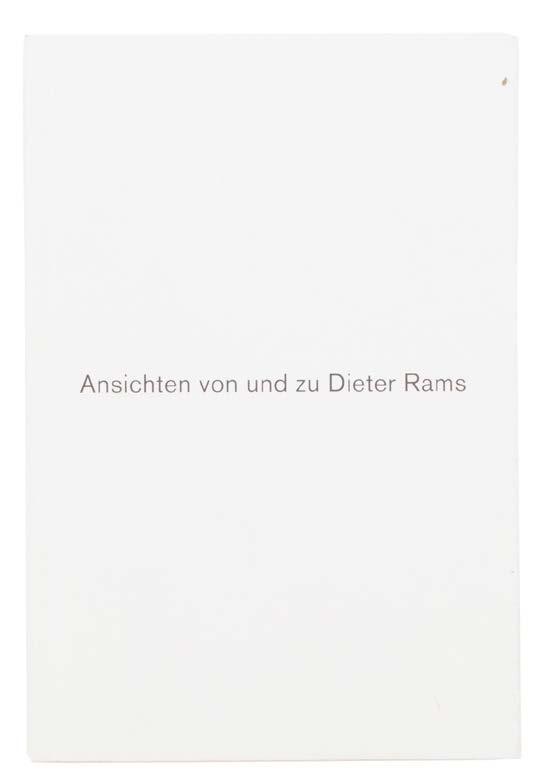
(143). Braun. Innovationen für Sie. Frankfurt. Braun. 1999. 4to. Illustrated in colour. Stapled wrappers. pp.28. • Late brochure detailing beauty and household products.
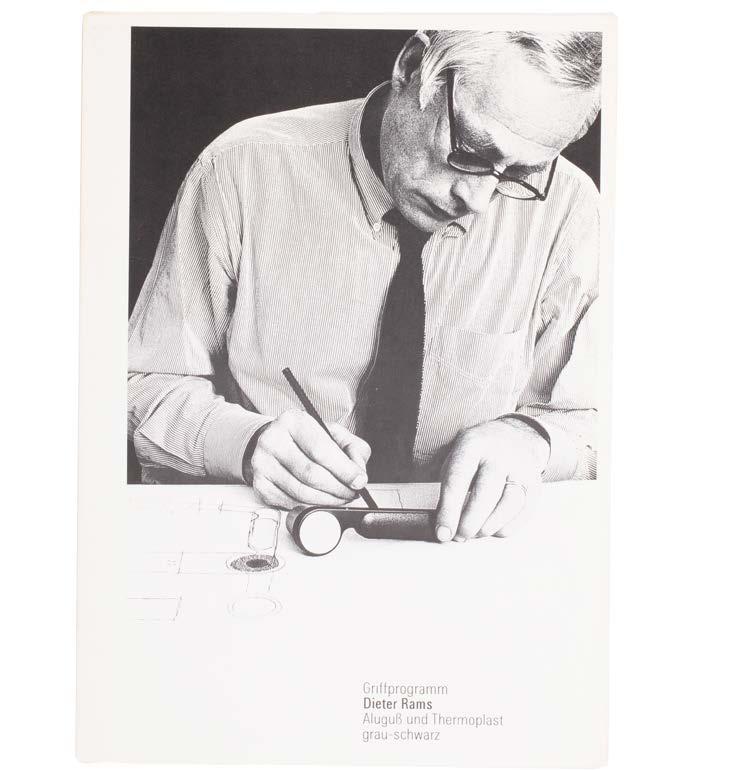
(144). Ansichten von und zu Dieter Rams. Heine Lenz Zizka und Modus. 2002. 8vo. Illustrated in colour Wrappers. • Small monograph on Rams with various contributions. Not pictured.
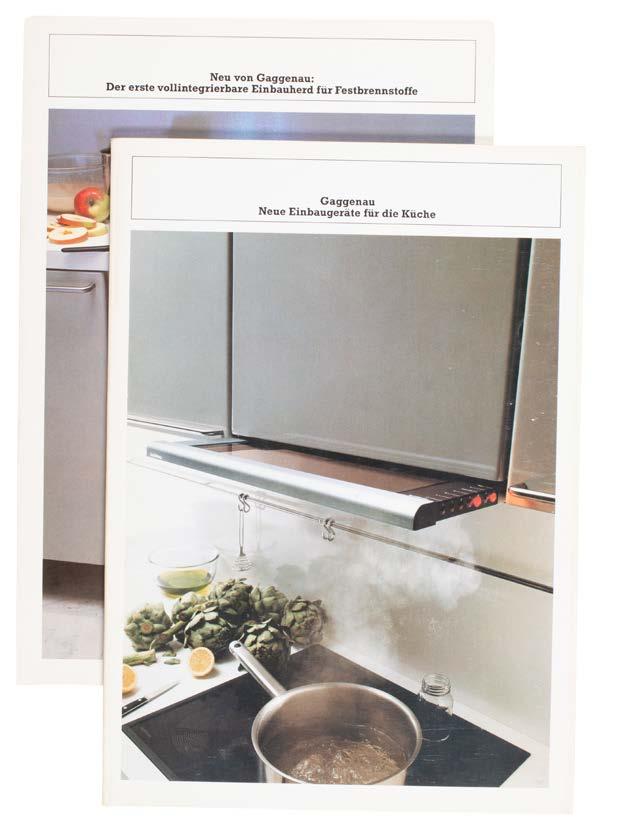
(149). Heide, Rolf. Gaggenau / Neu von Gaggenau. Gaggenau/Baden. Gaggenau. (1980s). 4to. Illustrated in colour. Stapled wrappers. • From the late 1970s through to the early 1990s, Rolf Heide served as a freelance designer for Gaggenau. His work focused on exhibition design, catalogues, and broader corporate visual presentation, helping shape the brand’s public and trade fair presence.

(February 1980). Several of the sheets are annotated. With stapled ‘VitsœBrief’ headed typed letter from ‘Dietrich Mahlow, Eröffnungsrede zur Ausstellung Design Dieter Rams bei Wiese Vitsœ in Frankfurt am 30.8.1981.’ With: (153). Vitsœ. Work in Progress. September 1994. 1994. Oblong 8vo. Stapled wrappers. pp.6. Ephemeral promotional booklet: ‘The Vitsœ collection is now available in coloured paper so you don’t have to search for long.’
FSB (Rams): (145). Griffprogramm. Dieter Rams. Aluguss und Thermoplast grau-schwarz. Brakel. FSB. Undated. 4to. Illustrated in black & white. • Sales brochure for a furniture range. ‘Function is enhanced by manufacturing all working parts in metal and all easily damaged parts in glass-fibre reinforced (GFR) black plastics.’ (From the brochure). Dieter Rams, designer at Braun, worked for the Handle range at FSB, a company founded in 1881.
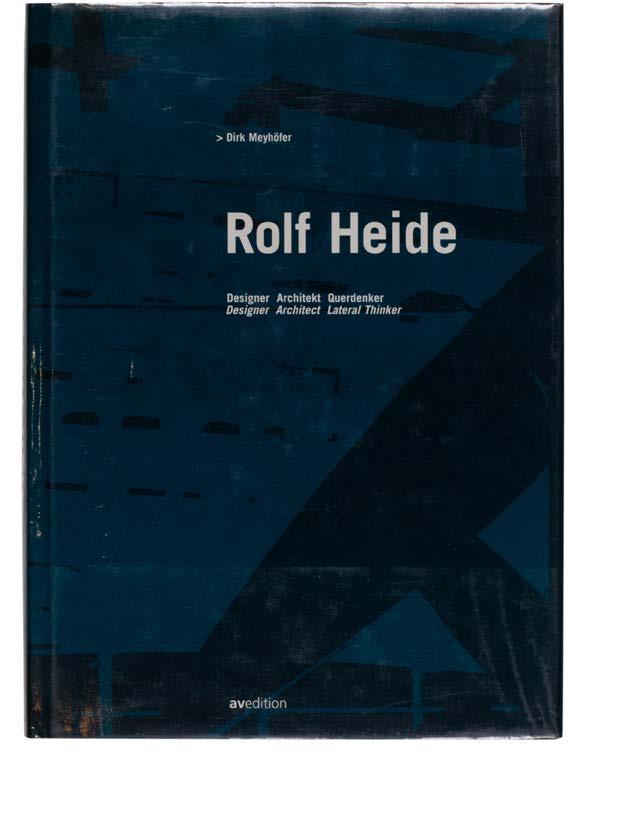
(150). Meyhofer, Dirk. Rolf Heide. Designer, Architekt, Querdenker. Hamburg. Avedition. 2000. Large 4to. Illustrated in colour. Boards. pp.268. • Richly illustrated Heide monograph, offering a comprehensive retrospective of Heide’s multi-faceted legacy, spanning furniture and lighting design, interior architecture, exhibition design, and corporate identity projects. Text in English and German. This copy with written dedication from Rolf Heide.

et al. Vorwerk. (Three press release folders). Hamein. Vorwerk. (1990s). 4to. With photographs and letters inserted loose. Publisher’s portfolio. • One press release (1990) concerns an exhibition of ‘Vorwerk Classic’ at Mathildenhohe in Darmstadt, the other (of which there is a duplicate) on Vorwerk’s participation in the exhibition ‘Citizen Office’ (Ettore Sottsass, Andrea Branzi, Michele De Lucchi) at Vitra Design Museum with

photographic documentation (stamped ‘Vitra Design Museum April 1993’) of designs inserted loose. Image also p.29. (155). Rolf Heide. Vorwerk. (Werke und Skizzen: Buch 5). 2006. 4to. Illustrated in colour. Publisher’s cloth. pp.274. • The fifth book in the series ‘Rolf Heide. Werke und Skizzen.’
Wohnbedarf
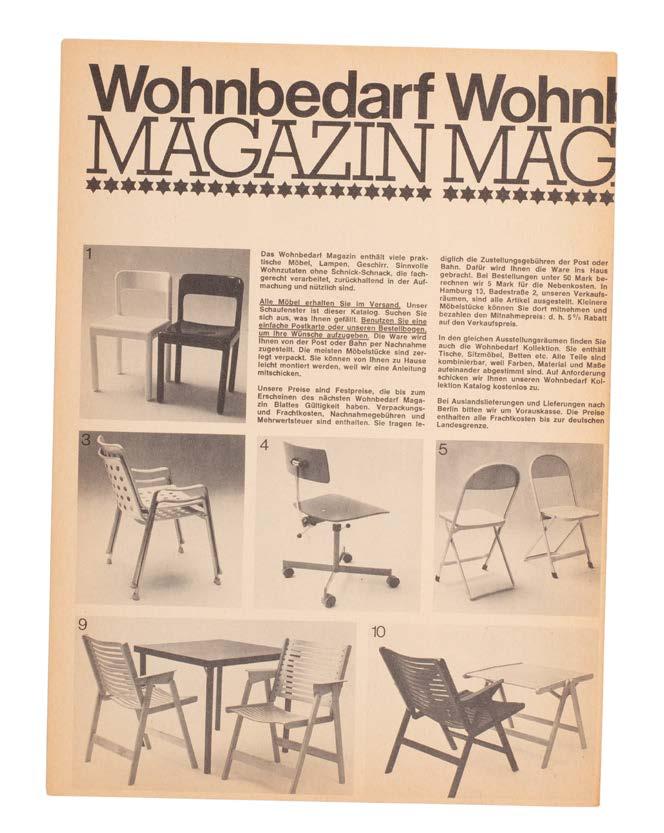
WOHNBEDARF: (156). Wohnbedarf Magazin. Hamburg. Wohnbedarf OHG. Undated. Single sheet, folded twice, (210 × 297 mm, folded). • Single issue of Wohnbedarf Magazine. ‘Wohnbedarf was launched in Zurich, Switzerland, in 1931 by the art historian and modernist supporter Sigfried Giedion, the architect Werner Max Moser, and the businessman Rudolf Graber. They were prompted by the establishment of the Werkbundsiedlung Neubühl in Zurich,
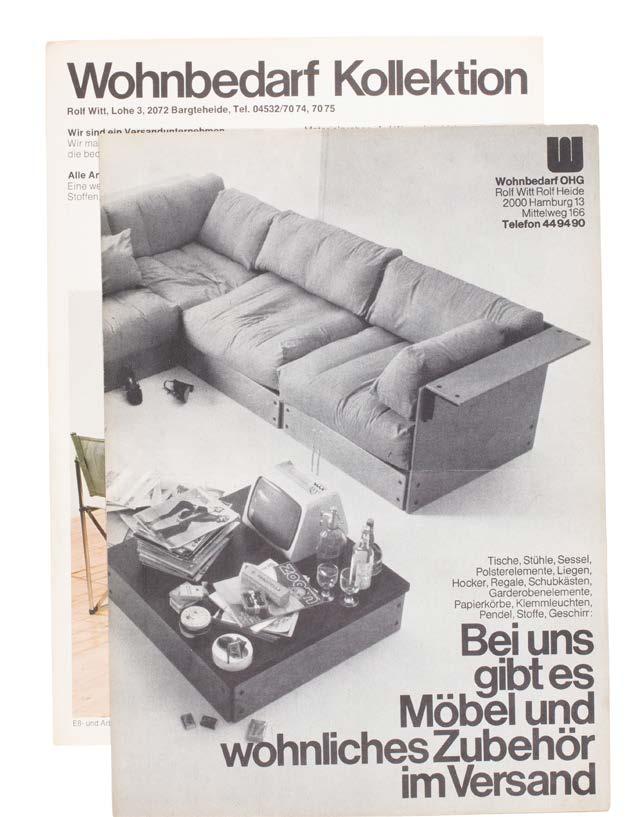
whose model homes the company furnished from 1932. ‘A selection of more practical and formally perfect furniture, textiles, and lighting fixtures’ should be made available, while ‘at the same time industry should be taught to value true quality’. (Graber, 1931)
(157). Wohnbedarf Kollektion / Tische, Stuhle, Sessel. Hamburg. Wohnbedarf OHG. Undated. Two sheets. Illustrated in black & white. • Promotional leaflets.
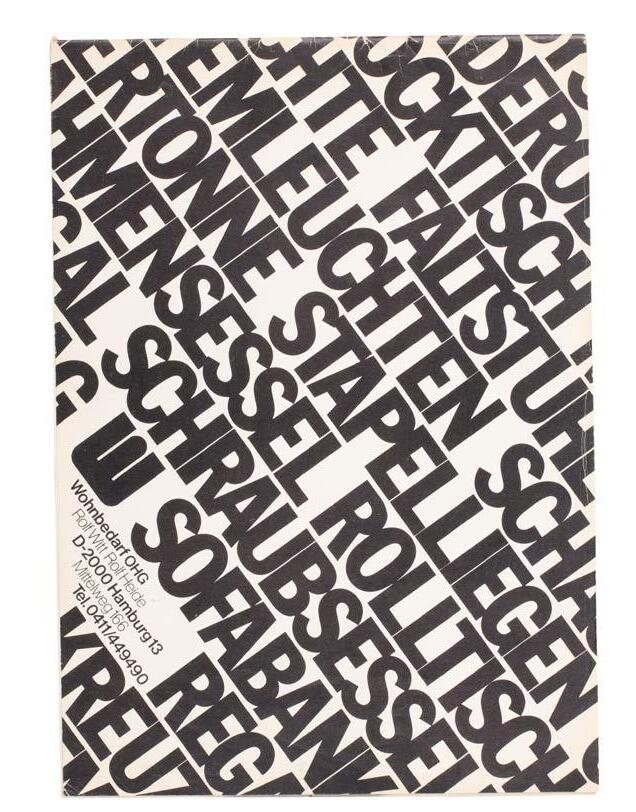
(158). Rolf Witt Rolf Heide. Hamburg. Wohnbedarf OHG. (1970s). 4to. Illustrated in black & white. Stapled wrappers. pp.32. With: (159). Wohnbedarf Kollektion. Rolf Witt Rolf Heide. Hamburg. Wohnbedarf OHG. (1970s). 4to. Illustrated in black & white. Stapled wrappers. pp.30. Not pictured.
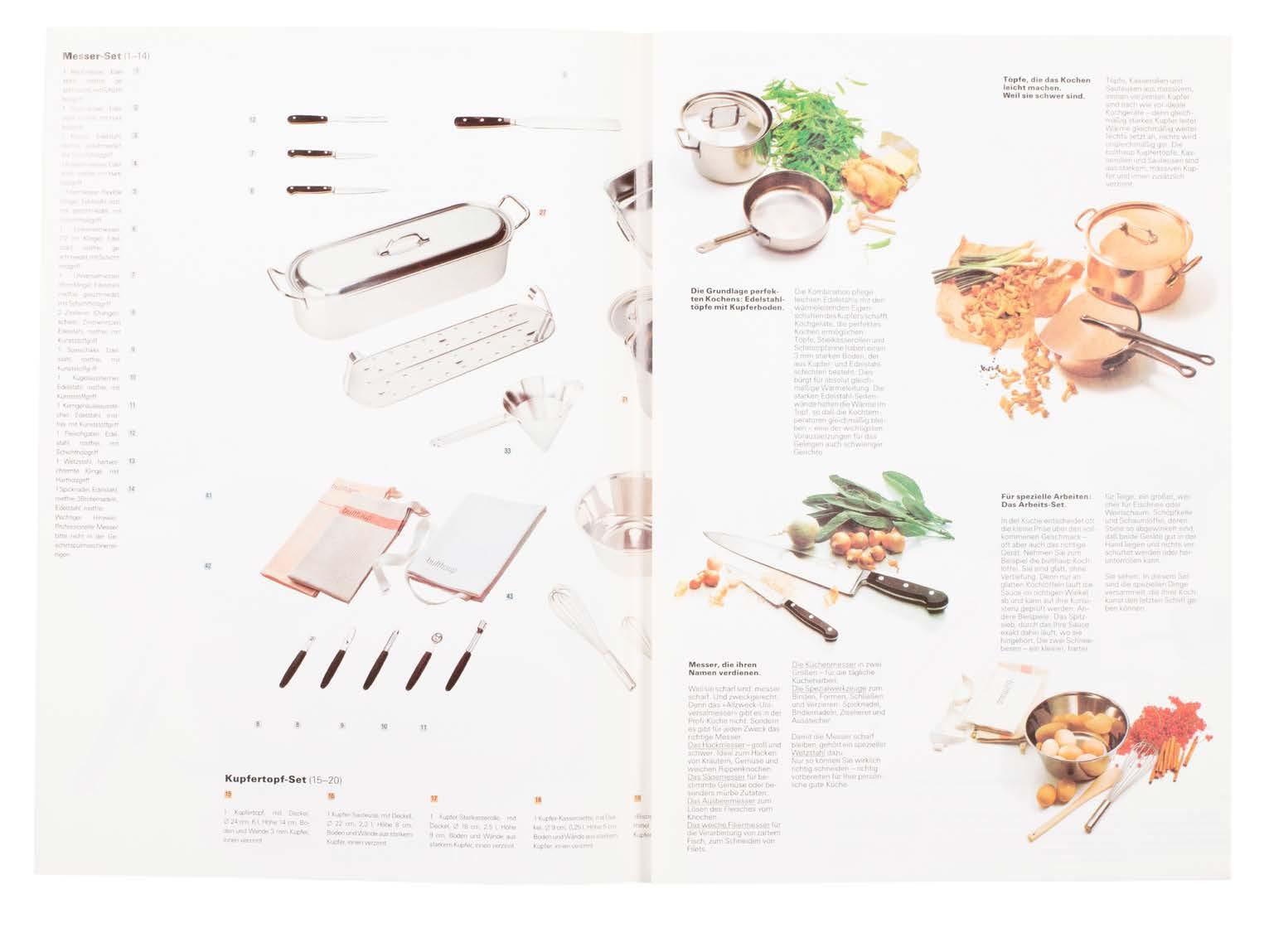

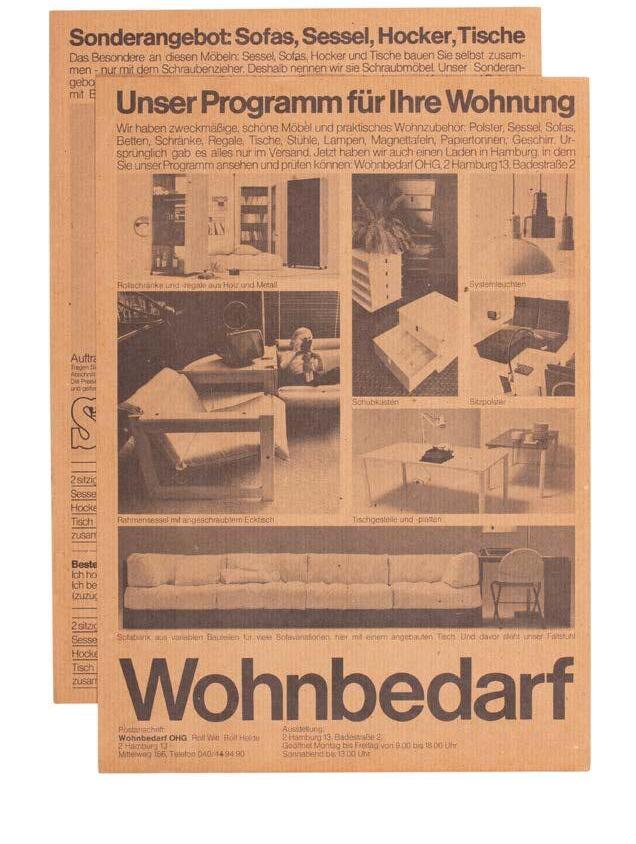
(160). Heide, Rolf. Unser Programm für Ihre Wohnung. Wohnbedarf / Sonderangebot. (Two advertisements). Hamburg. Wohnbedarf OHG. 1970s. 4to. Illustrated in black & white.
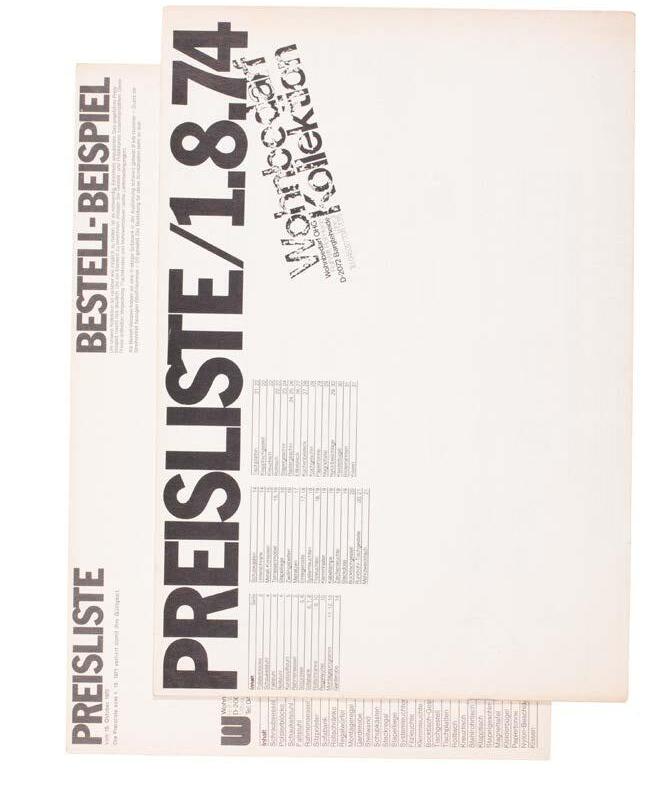
(161). Preisliste 1.8.74 / Preisliste (Bestell-Beispiel). 10 Oktober 1972. 1972–1974. Oblong 4to. Stapled wrappers. pp.24; pp.32. • Two Wohnbedarf price lists. Also included is the Bestell-Blatt order form.

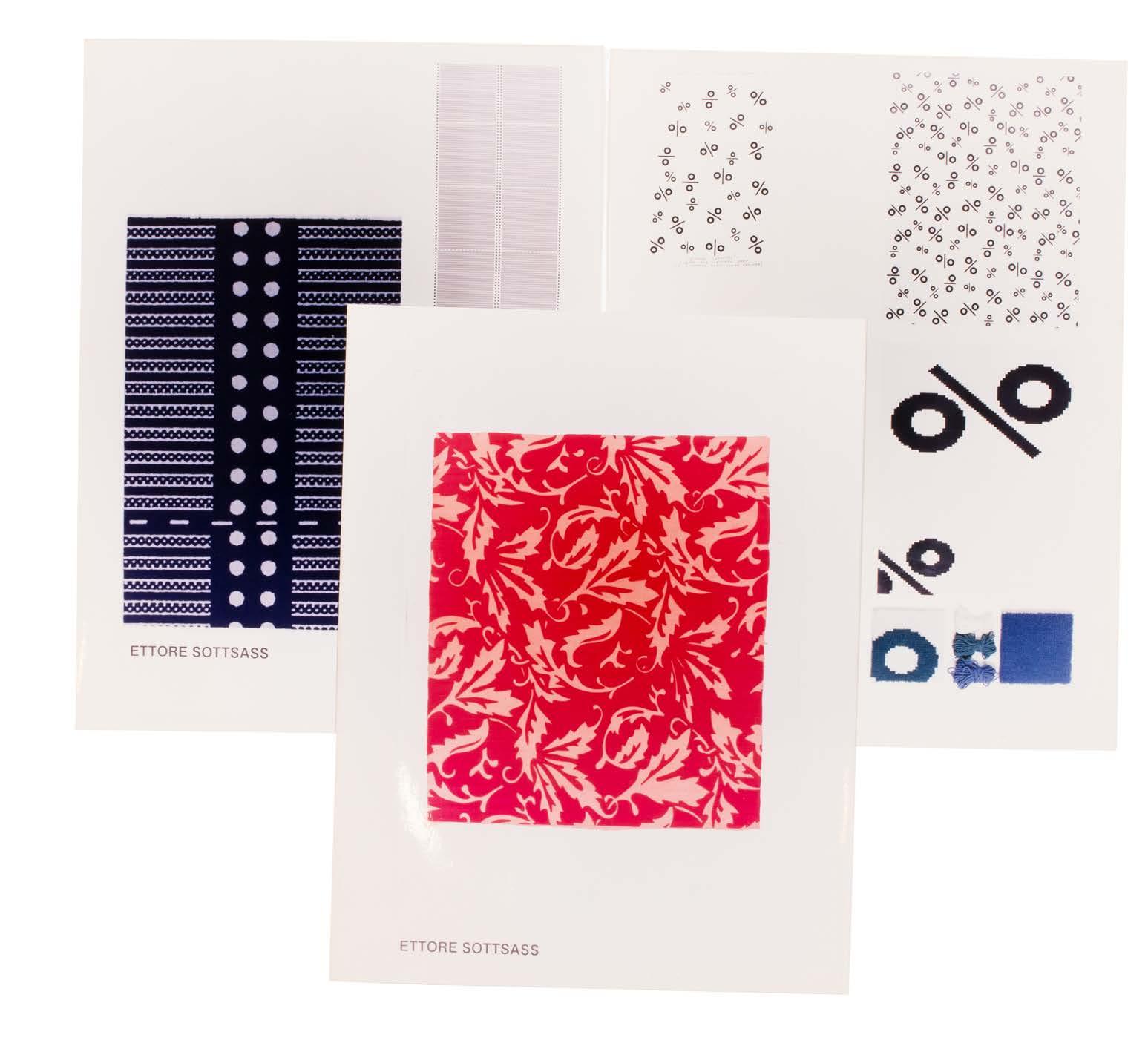
no.154
Left to Right:
Sigfried Giedion, Werner Max Moser, Rudolf Graber • 1931
Rolf Heide
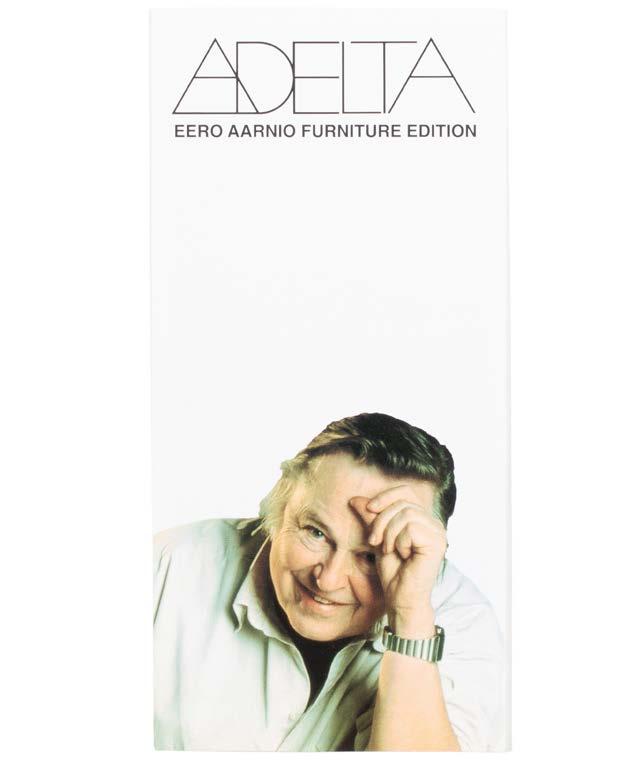
ADELTA: (162): Adelta. Eero Aarnio Furniture Edition. Dinslaken. Adelta. (1990s). Folded sheet. Illustrated in black & white. pp.6. • Designs by the Finnish designer Eero Aarnio produced by Adelta include the iconic ‘Ball Chair’, ‘Tomato Chair’, and playful children’s seating.
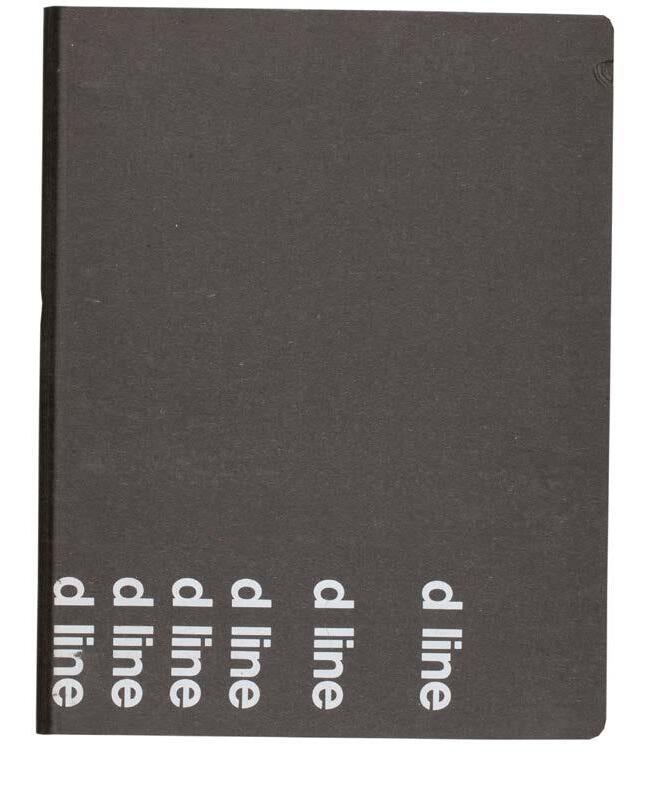
design of the company logo, catalogues and showrooms. With five coloured leather sample swatches for Kjærholm furniture.
D-LINE: (166): (Holscher, Knud). d-line. Sales catalogue. (Denmark). D-line. (1990s). 4to. Illustrated in colour. Original publisher’s ringbinder. pp.24; plus c.100 photocopied pages. • d-line sales catalogue comprising holepunched product sheets in ringbinder.
BD Ediciones
Pep Bonet, Cristian Cirici, Lluis Clotet, Mireia Riera, Oscar Tusquets • 1972
Antonio Gaudi
R. M. Schindler
Charles Rennie Mackintosh

ALEPH: (163). Starck, Philippe. Aleph / Ubik de Philippe Starck. Price List & Aforismi di Antonia Astori. Price List / Technischer Katalog. Preisliste. Aleph. 1989. 4to. Illustrated in colour. • Three promotional booklets from Aleph / Driade s.p.a. / Ambiente Aoyama (Tokyo) within gold Aleph envelope.
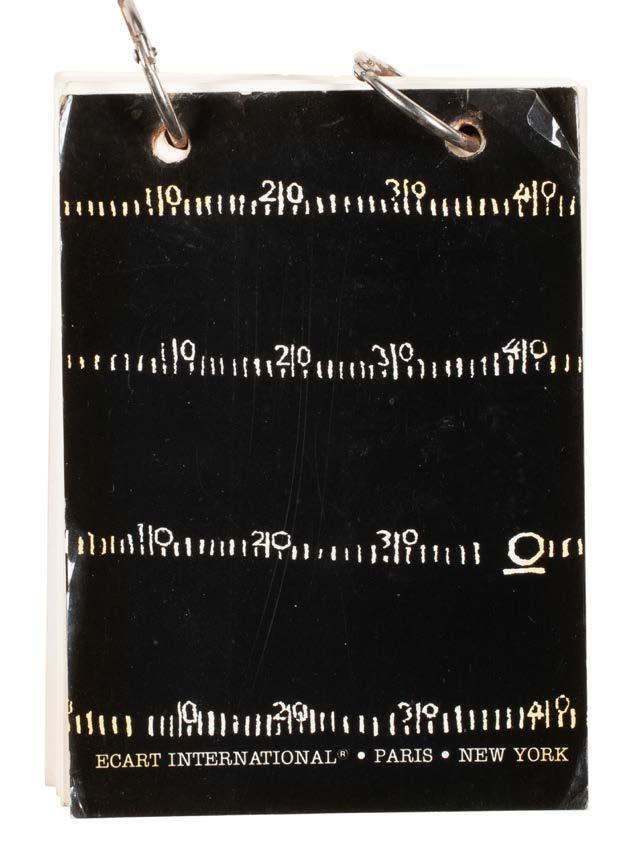
ECART: (167): Ecart International. (Paris). Ecart International. (1970s). 8vo. Illustrated in colour and black & white. Ringbound wrappers. pp.46. • Early trade booklet with designs by Eileen Gray, Michel Dufet, Mallet Stevens, Mariano Fortuny, J. Michel Frank and others. Text in English and French. Previous owner’s name written in blue pen to initial leaf. ‘The furniture and objects in this catalogue were designed in the first half of the twentieth century.

D-Line Ecart Kold Christensen
Ejvind Kold Christensen • 1950s Poul Kjærholm
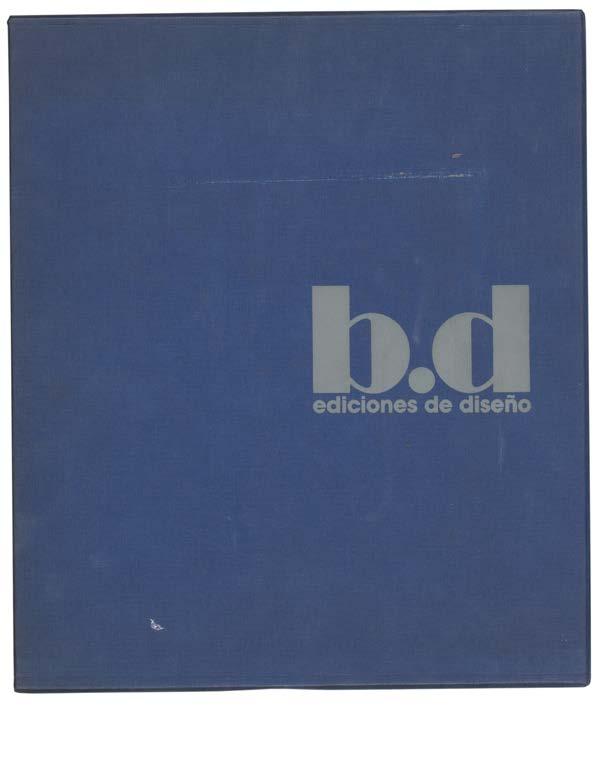
BD: (164): B.D. Ediciones de Diseño. Barcelona. BD: Ediciones de Diseñ o. c.1986. Folio. Illustrated in colour. Original portfolio and slipcase. • Extensive catalogue with sections: Historicos, Lamparas, Asientos Mesas, Allombras, Otros Muebles, Objetos Varios and Construccion. ‘Established in 1972 as ‘BD Ediciones de Diseño’ by a group of young architects and designers from Barcelona [...] BD has played a leading role in the international

Most of them were intended for mass production, but for a variety of reasons, including their disturbing nature they disapeared from the market. Recreating these designs, with struct authority, Ecart International proposes to fulfil their original purpose...’ (From the catalogue).
(168): Privates Licht: Wandleuchten für Belux. Wohlen. Belux. 8vo. Illustrated in colour. Original folder. 14 postcards.
• Loose postcards from Swiss lighting
Knud Holscher • 1971 Andrée Putman • 1978
Eileen Gray
Michel Dufet
Robert Mallet Stevens
Jean-Michel Frank

renown of Spanish design. With a nonconformist spirit, the founders sought complete creative freedom and still orientate production towards cultivating beauty while combining artisan processes with industrial technologies, seeking the luxury of things well done and distanced from mass production. BD [...] sits on the cusp betweek art and design, combining aesthetics with functionality to offer unique pieces with a strong personality.’ (From Aram.co.uk).
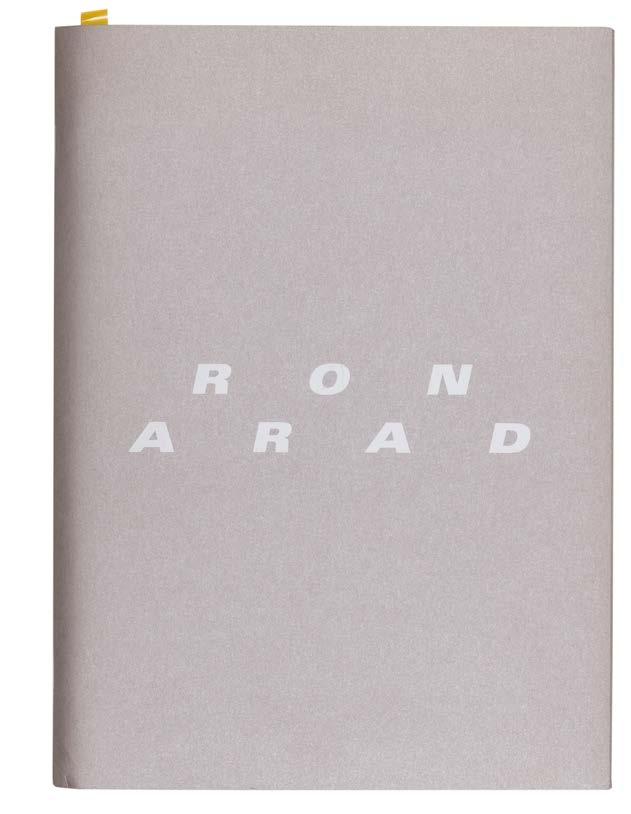
company Belux. Together with booklet comprising questions posed to designers included in the exhibition. Photographs by Andreas Pohlmann.
Single designers: (169): Ron Arad. The Dogs Barked. Zurich. De Pury & Luxembourg. 2006. Folio. Illustrated in colour. Original portfolio. • Exhibition catalogue for Ron Arad’s exhibition ‘The Dogs Barked’ at de Pury & Luxembourg, 24 November 2006–
E. KOLD CHRISTENSEN: (165). Poul Kjærholm. E. Kold Christensen. Copenhagen. Undated. Square 8vo. Illustrated in black & white. Loose as issued within wrappers and slipcase. • Early trade catalogue of works with an extensive list of works by Kjærholm. Each card (there are over 60) is printed with item descriptions to the verso. Kjaerholm is known to have been involved in every aspect of the marketing of his furniture, including the
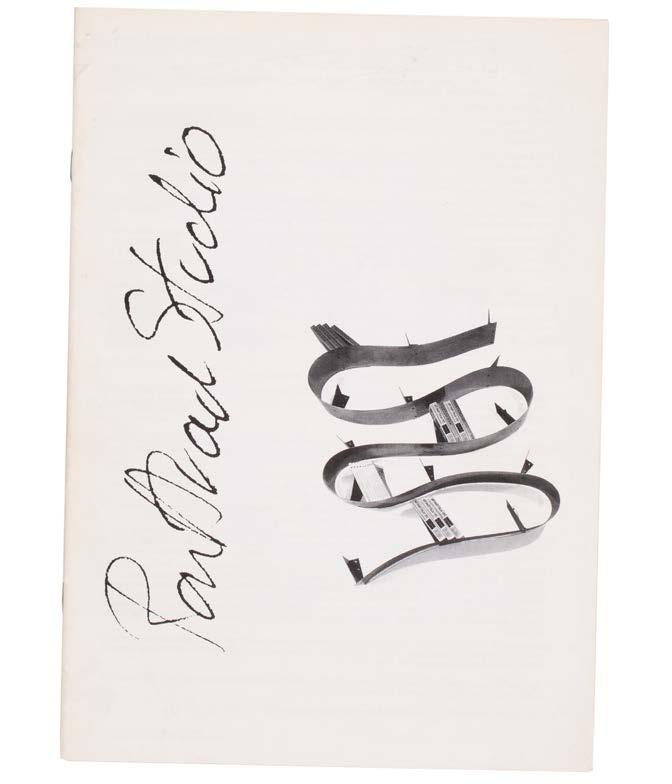
3 February 2007. With an A4 illustrated list of works, catalogue, newspaper articles (inserted loose) and 1995 price list from Ron Arad Studio.
•
‘Mobel
(Joseph
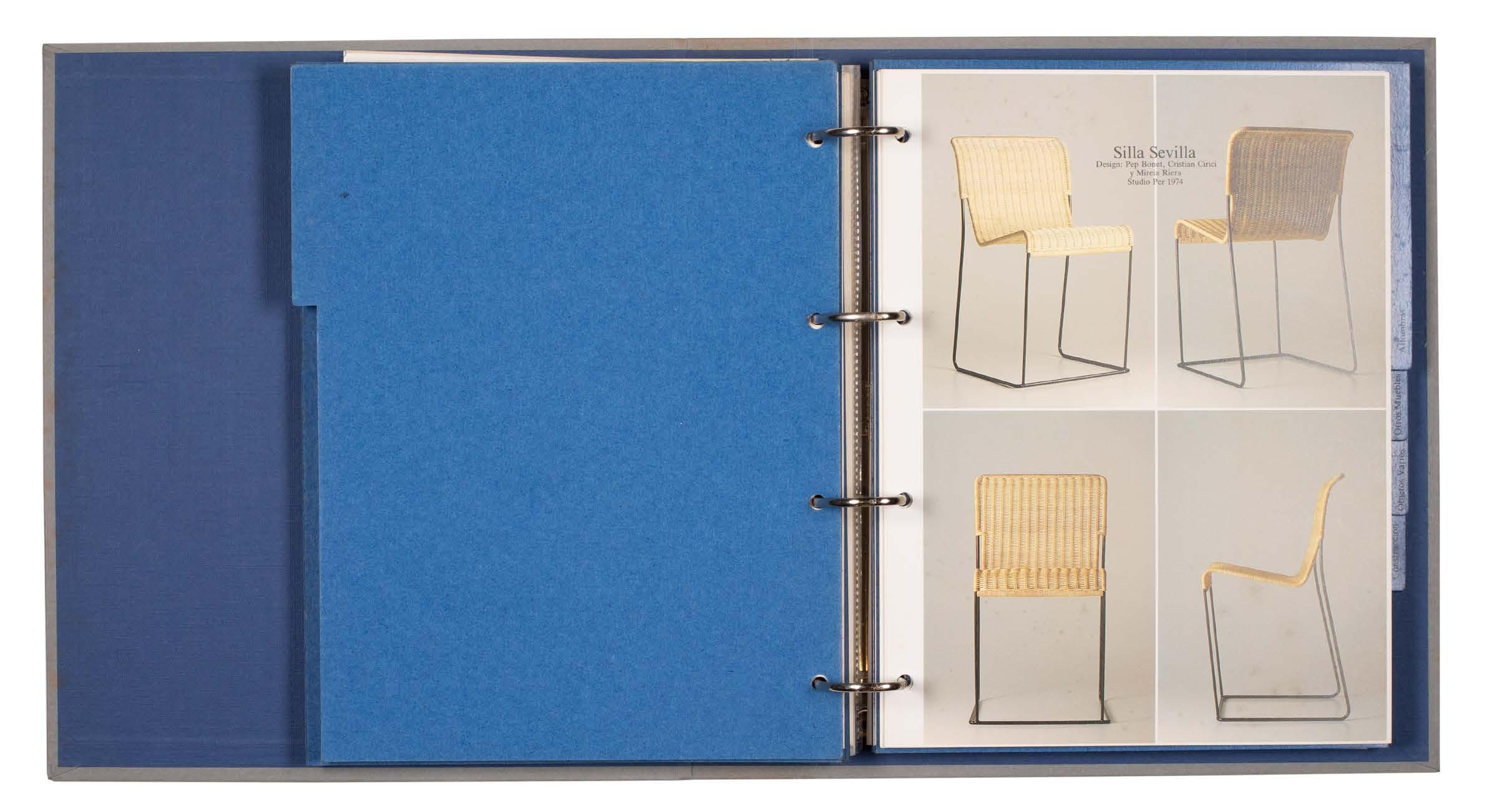
(170): Eileen Gray. Images. Eileen Gray Collection. Venice. Images. 1980. Leporello. Tall 8vo. Illustrated in colour and black & white. Wrappers. pp.20.
Rare leporello of Eileen Gray works.
Italia’ handwritten to the first page. Text in English, Italian, French and German. ‘A homage to Eileen Gray the pioneer of design. Her work is always modest, reasonable, yet so fresh and exquisite as to always be exciting.’
Rykwert, Introduction).

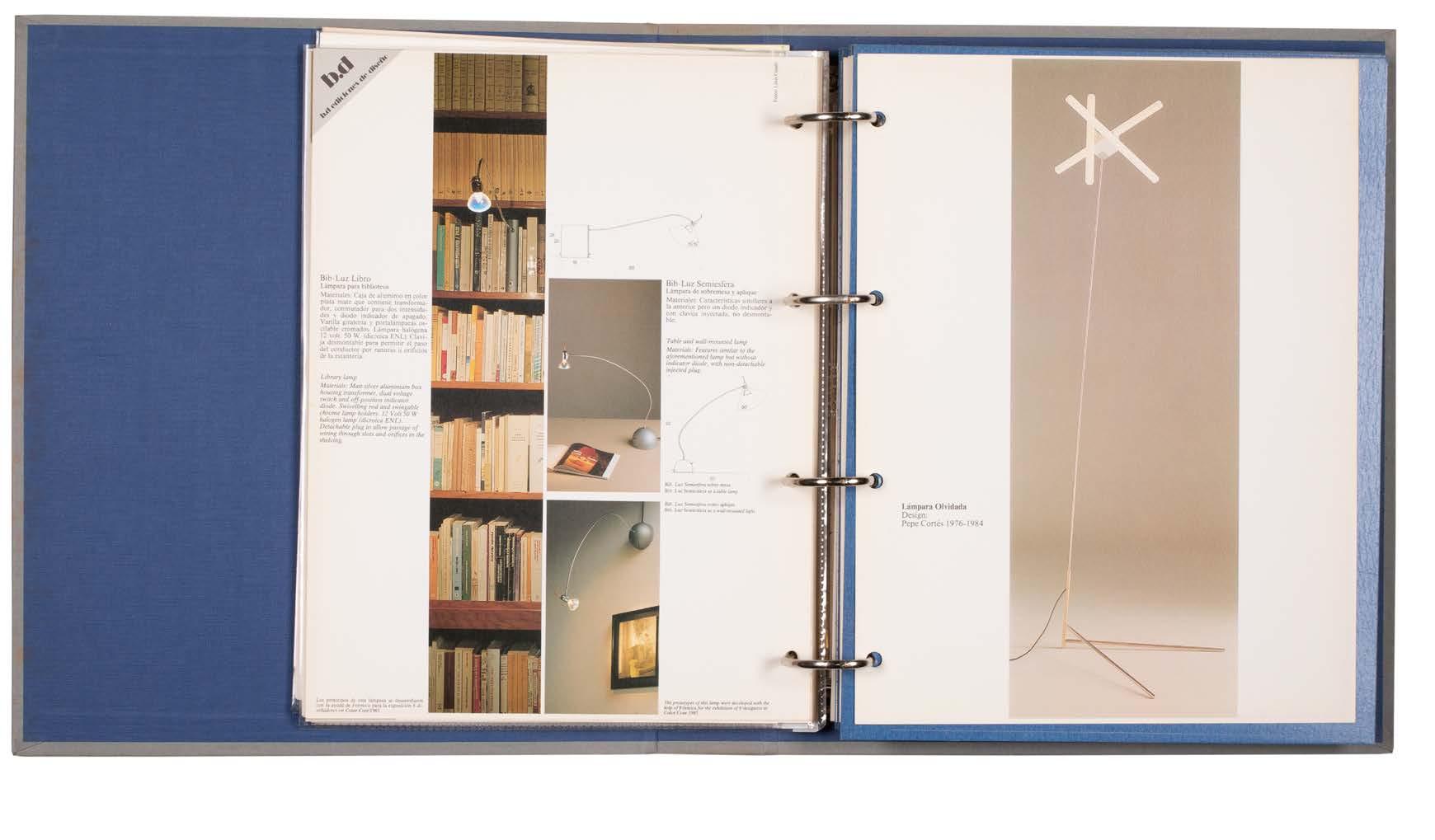
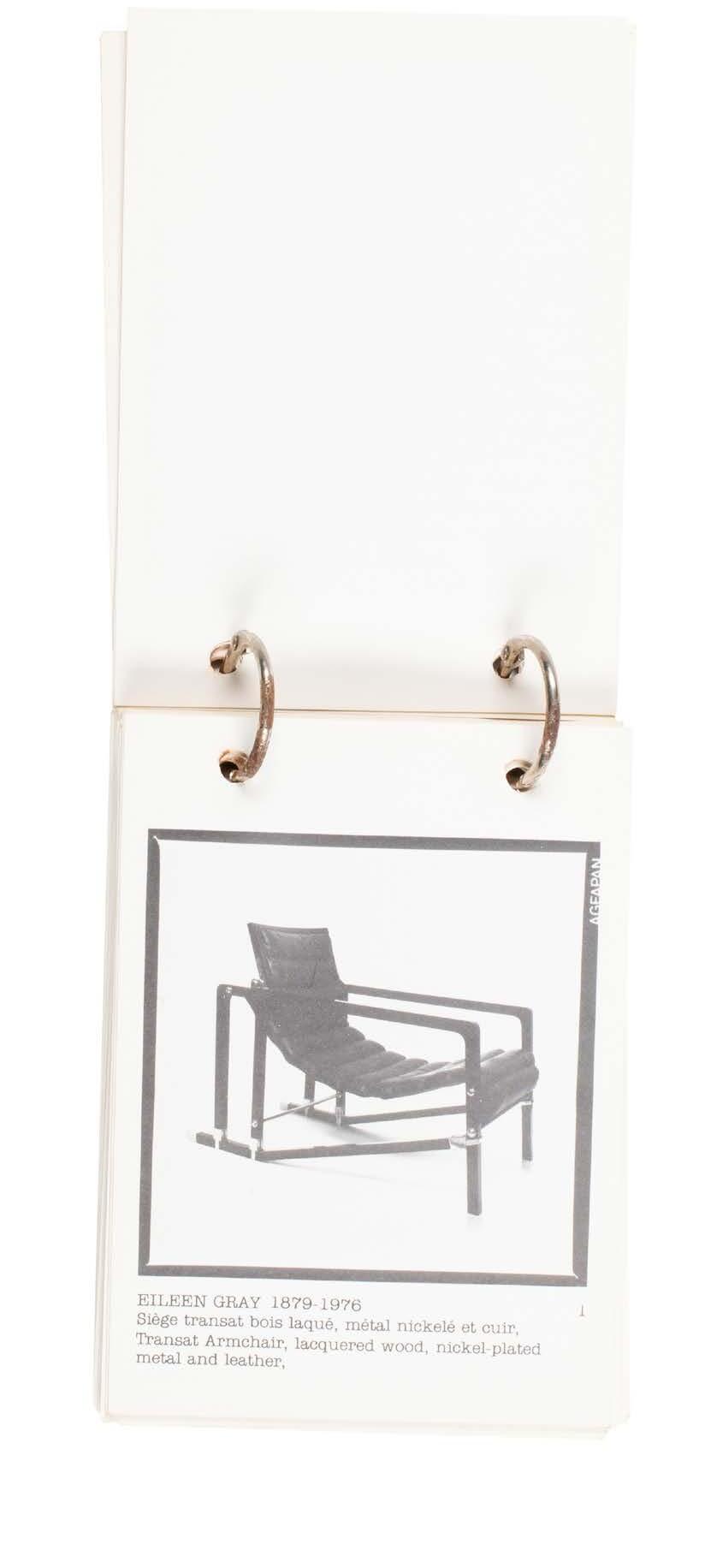
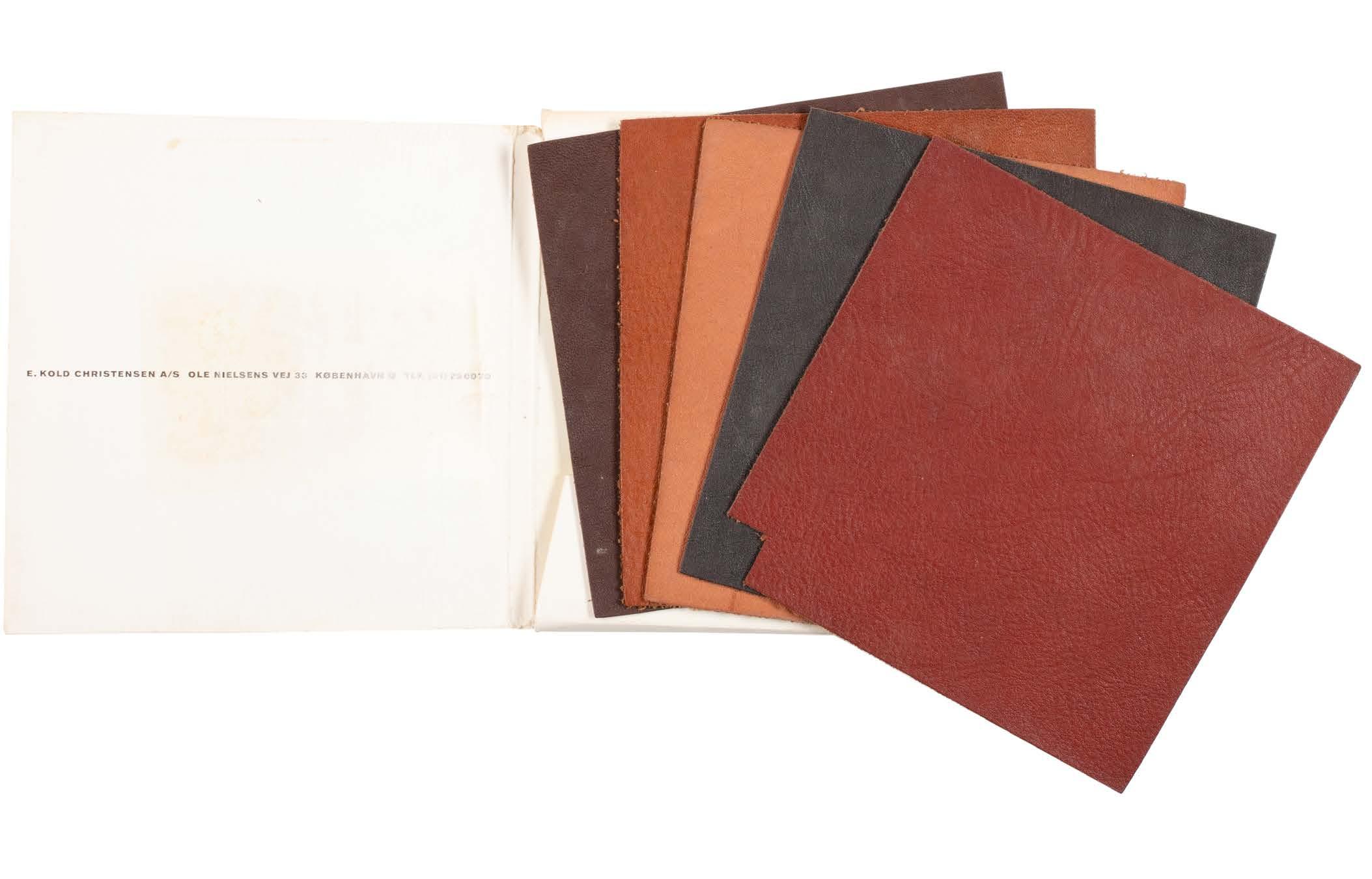
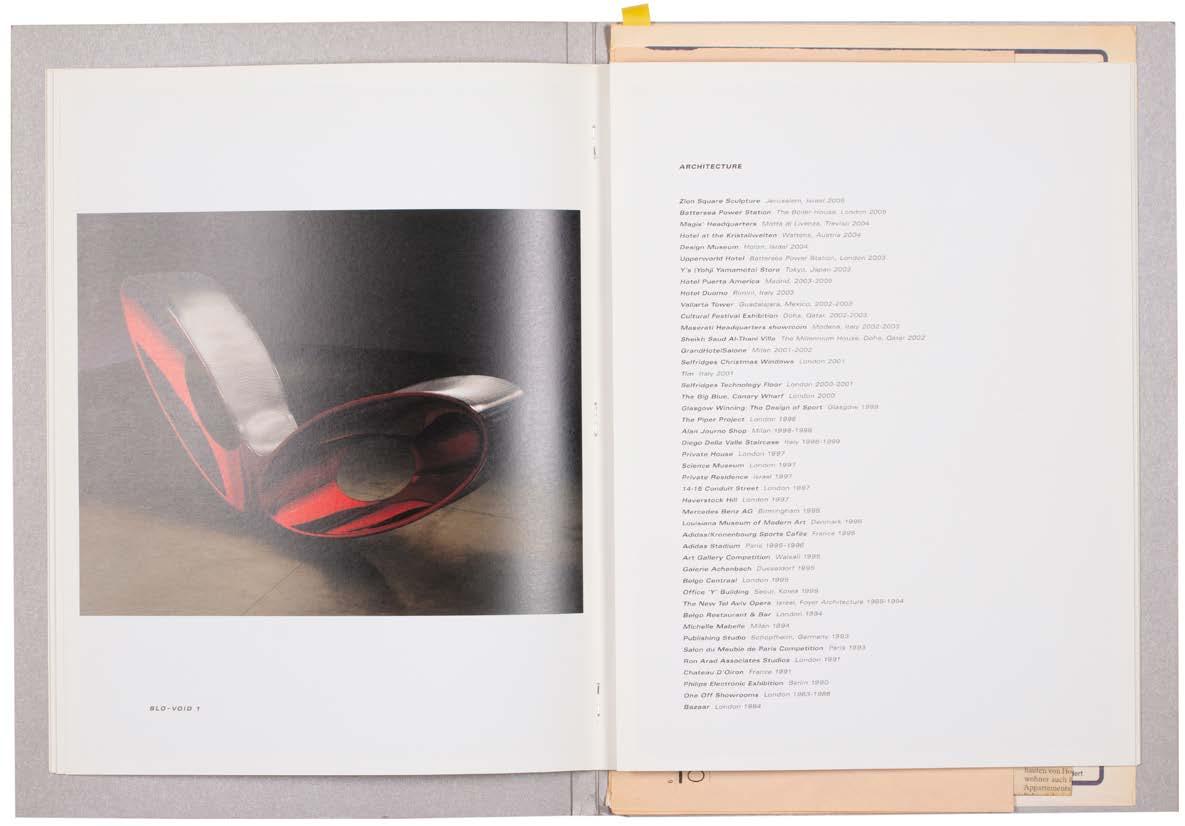

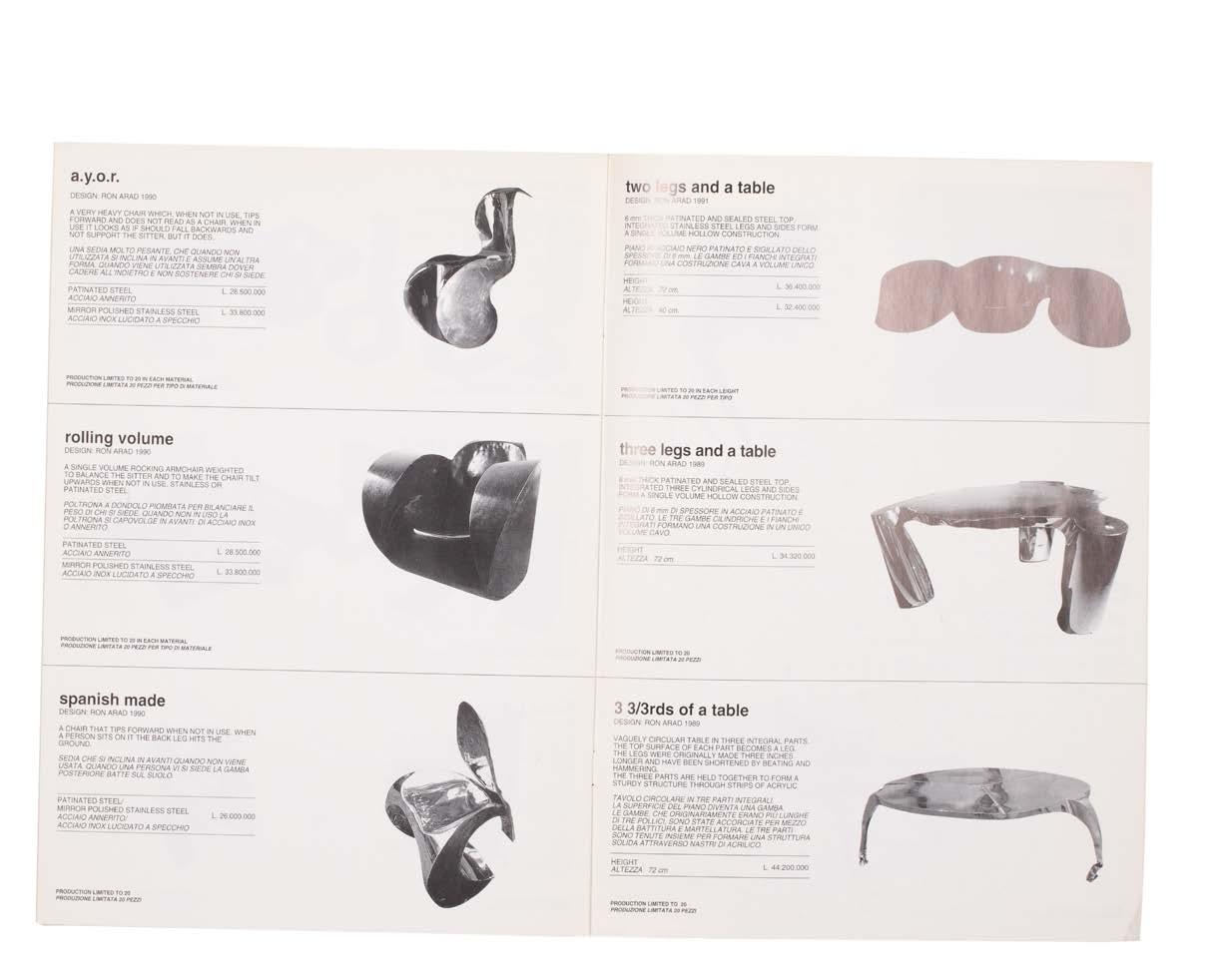
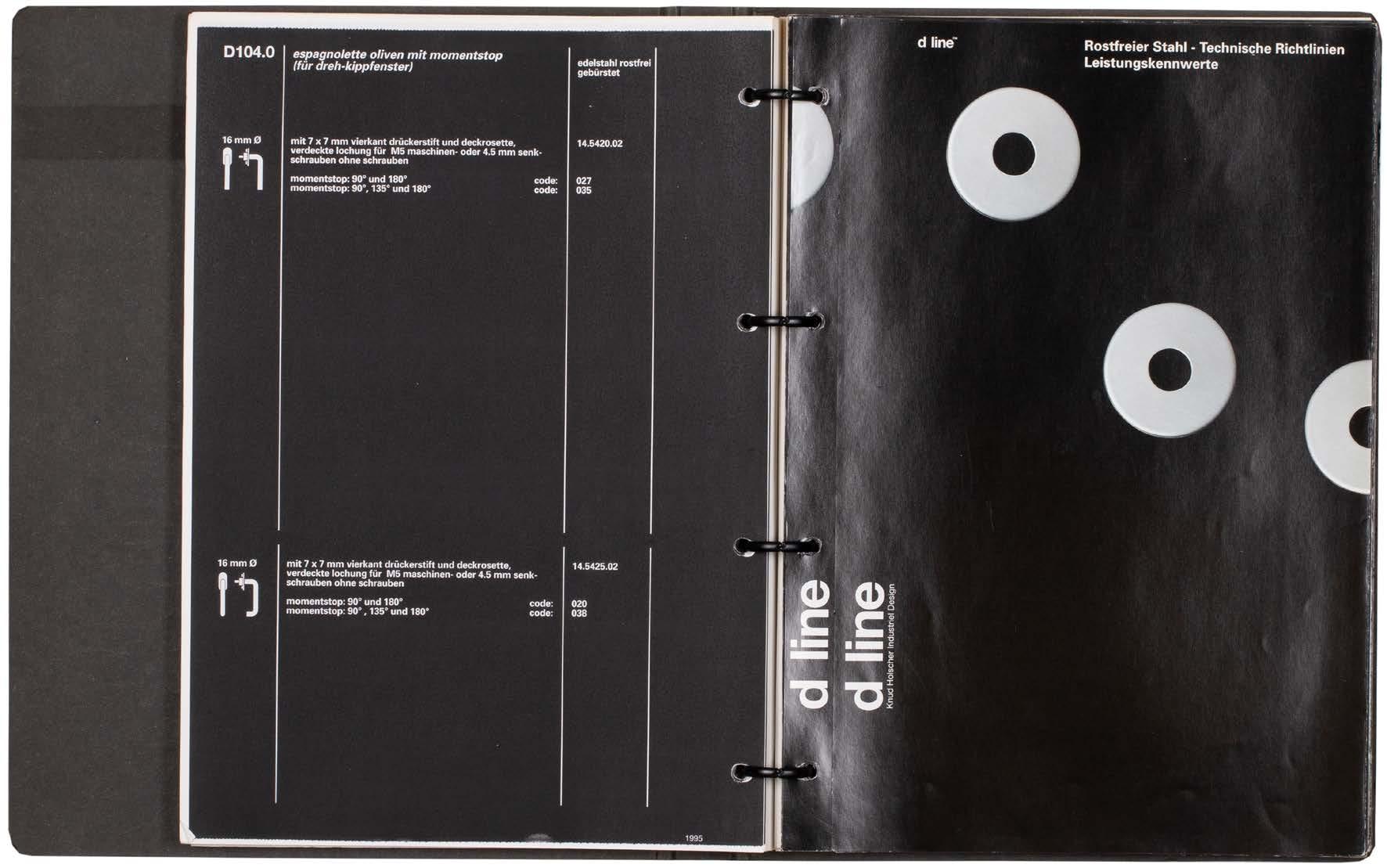
Clockwise from top left: no.165, no.165, no.169, no.166, no.167, no.167, no.164

